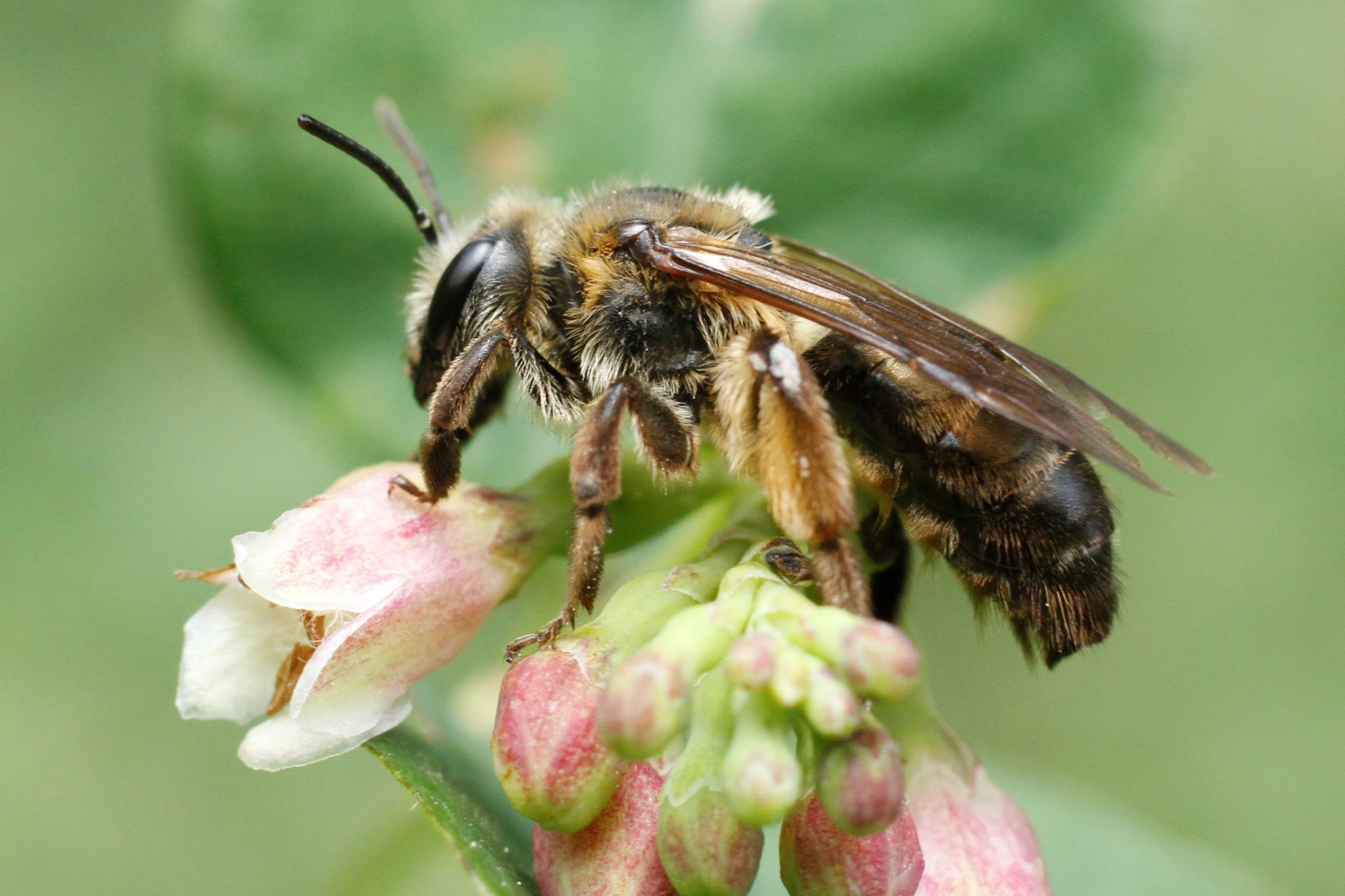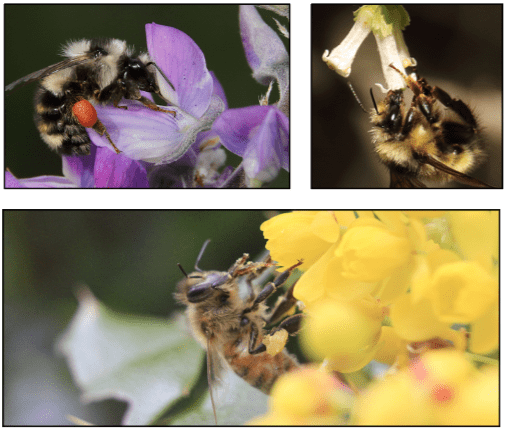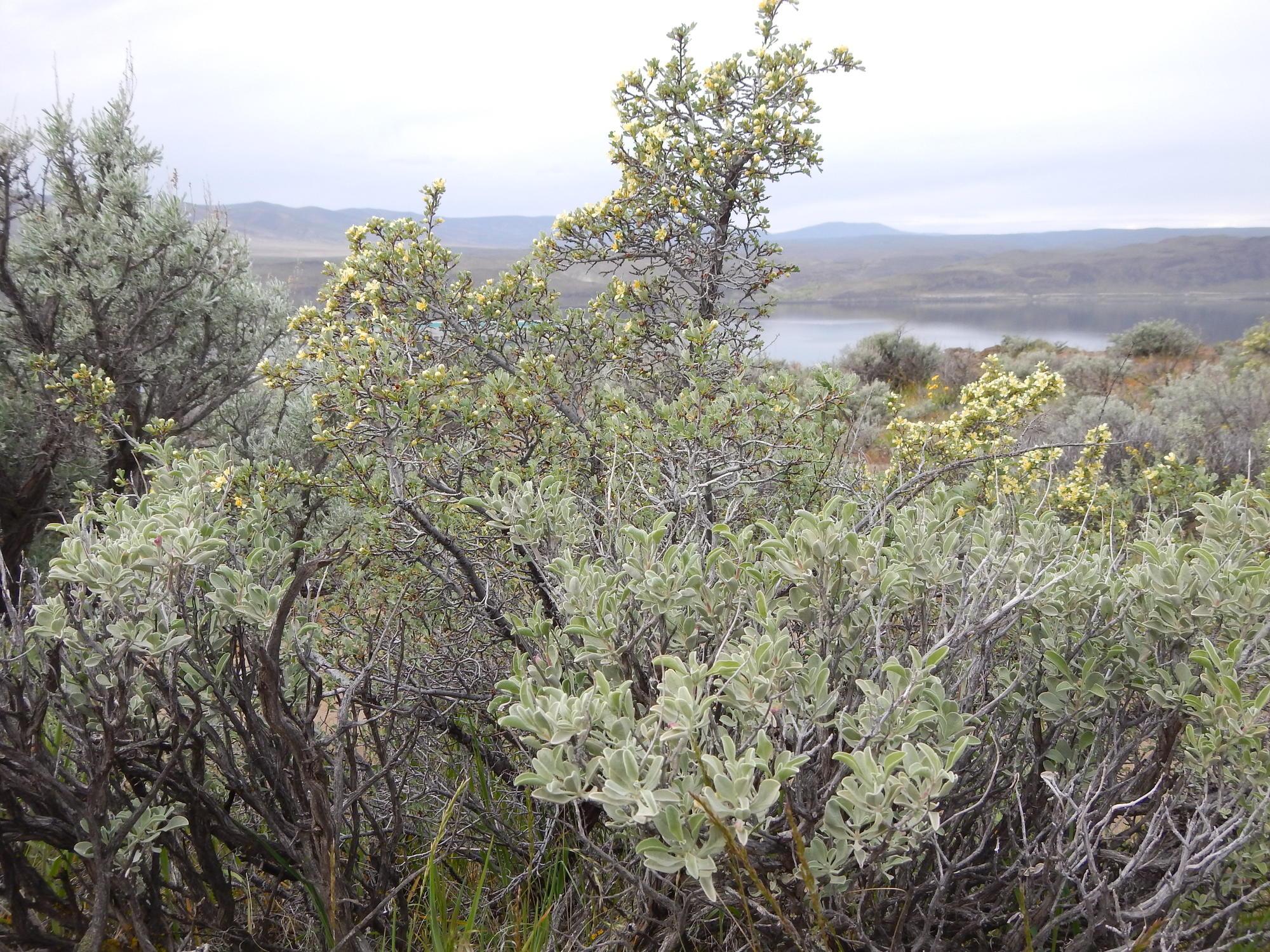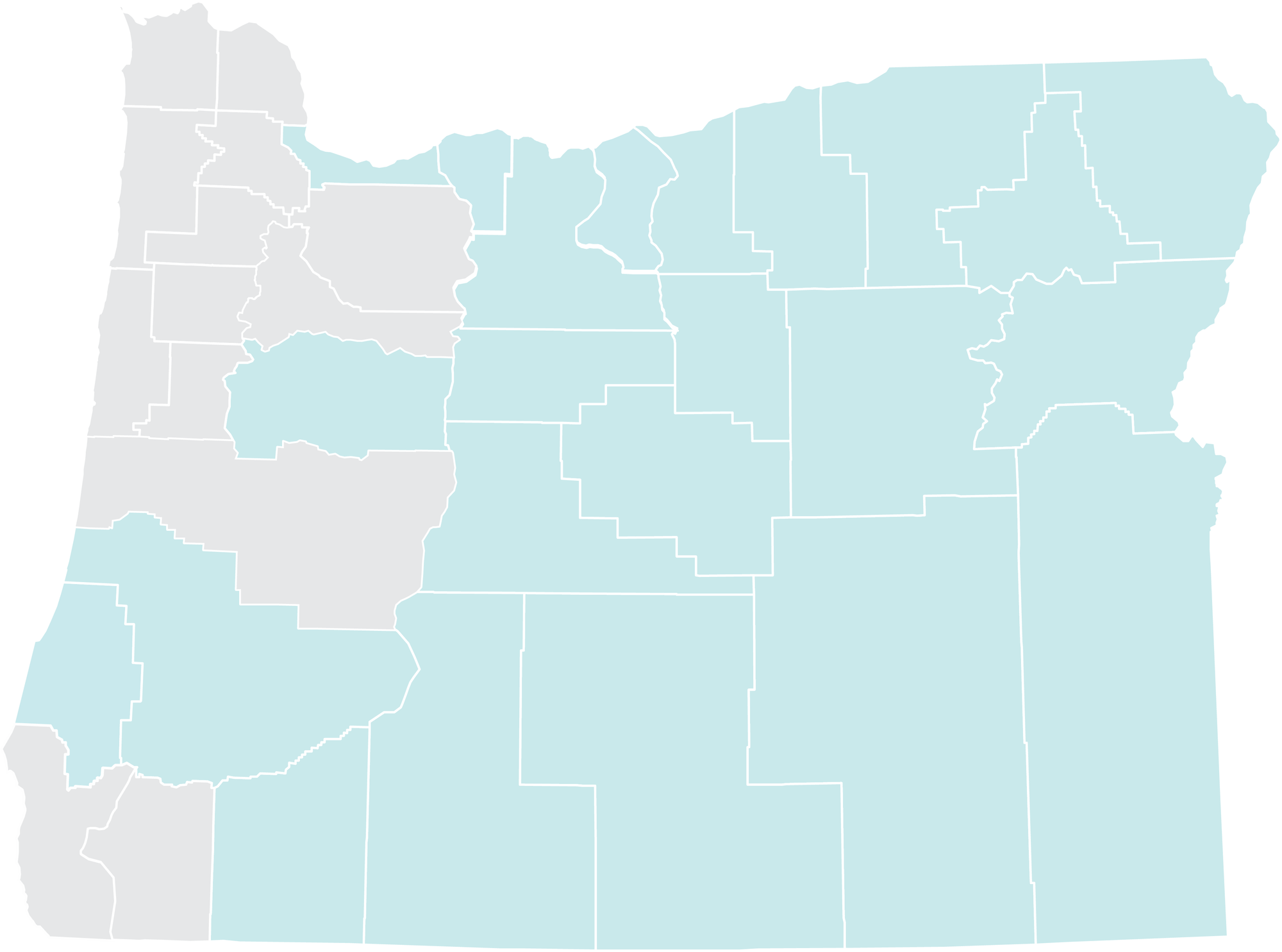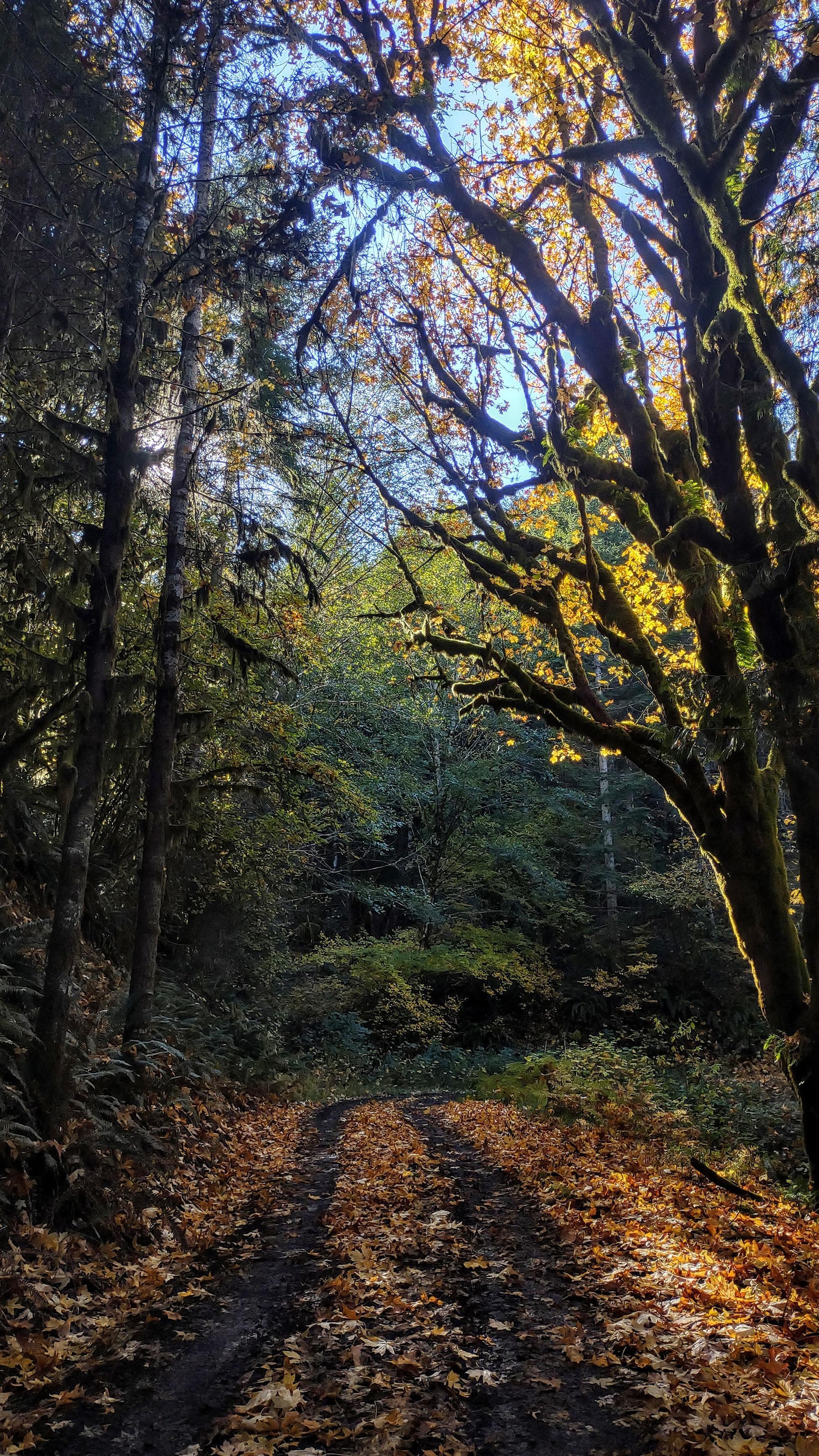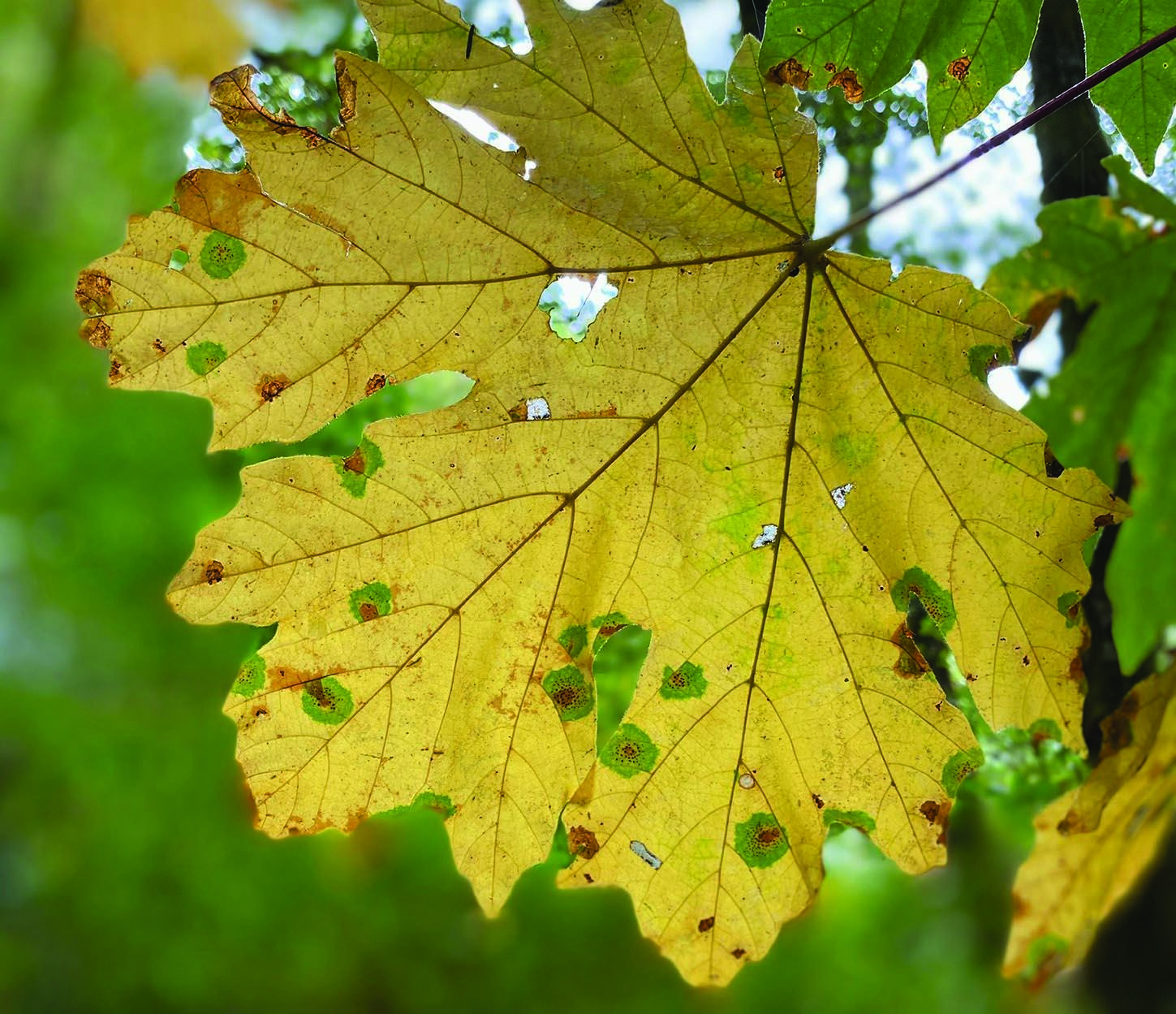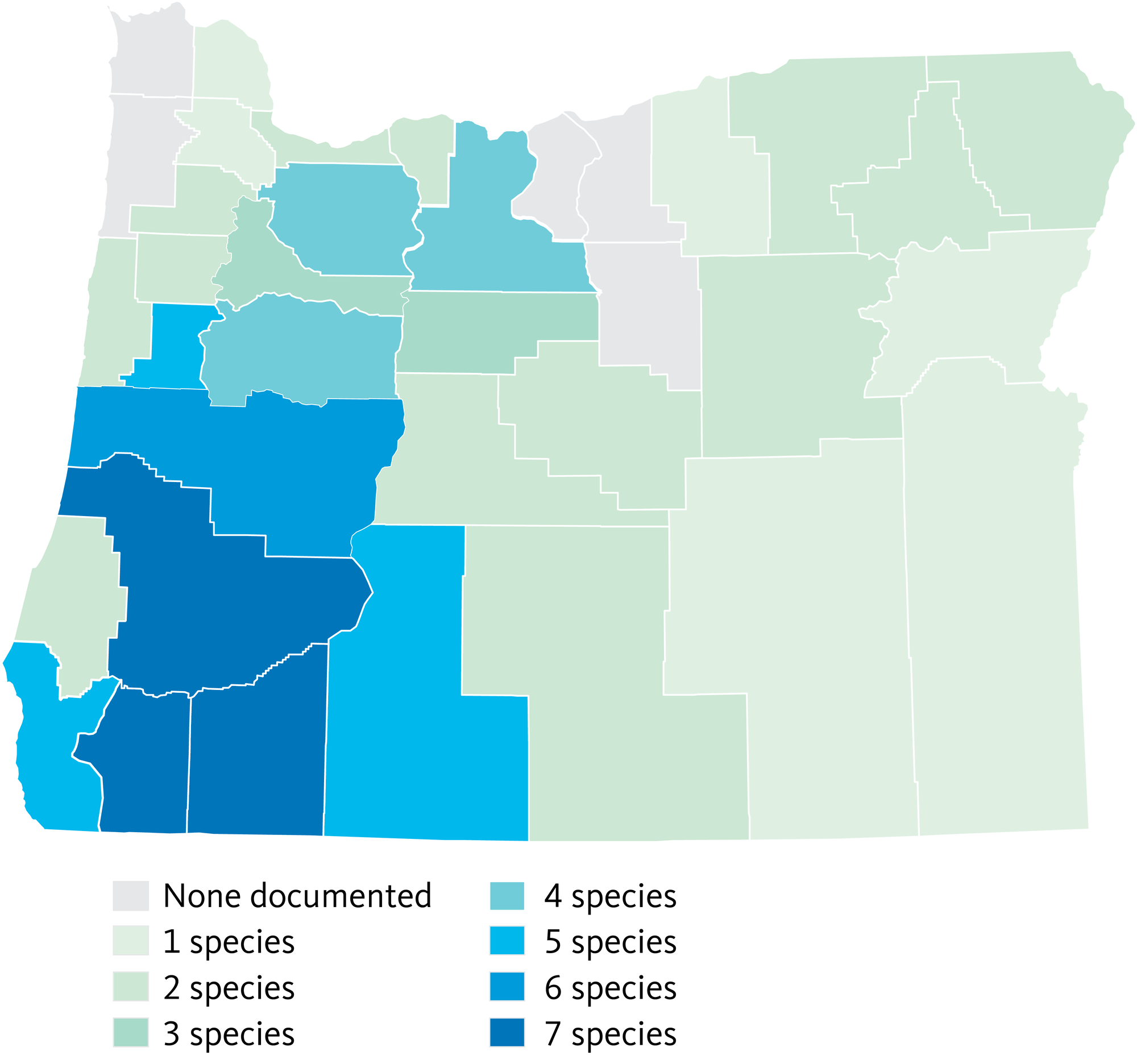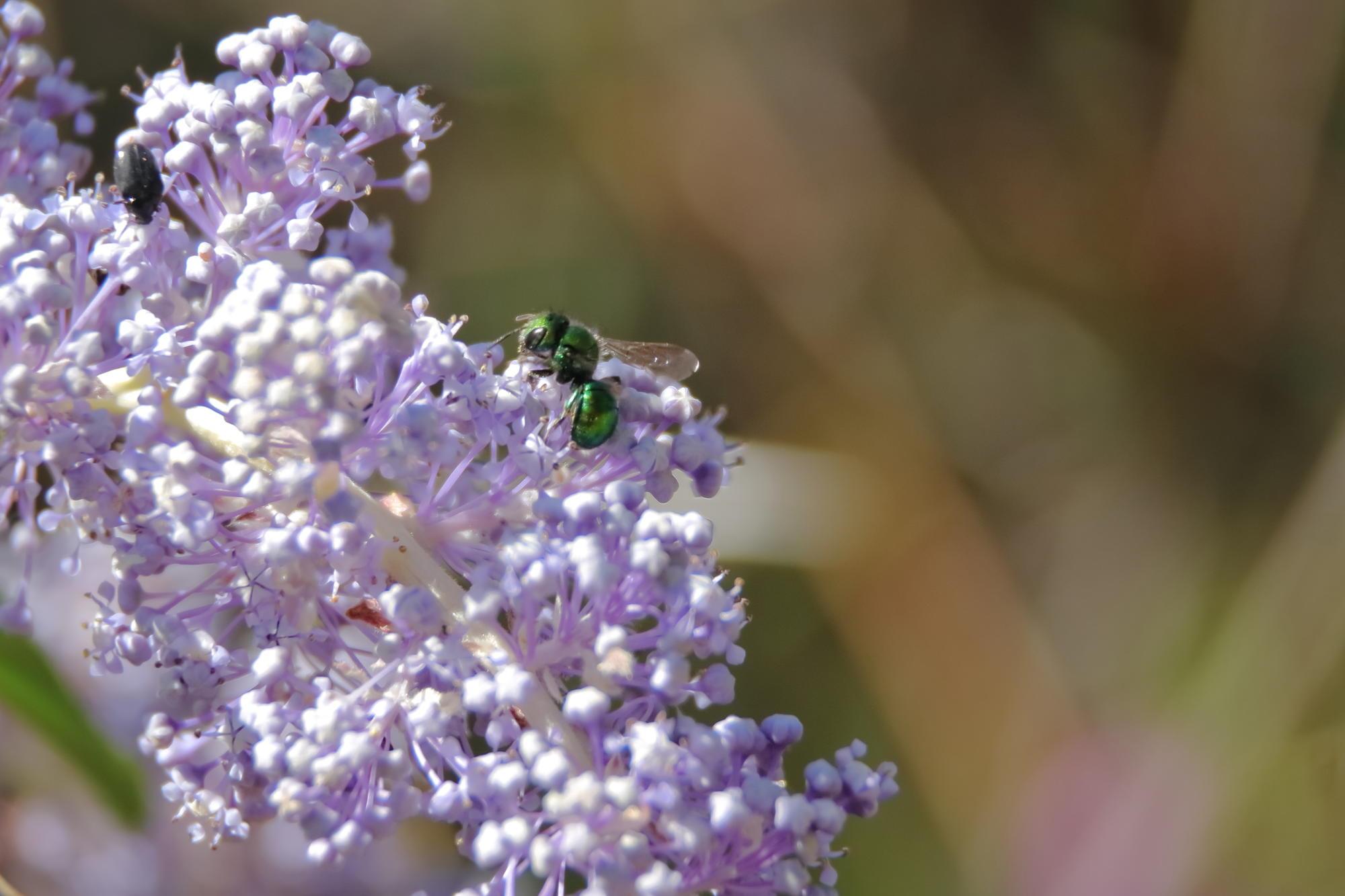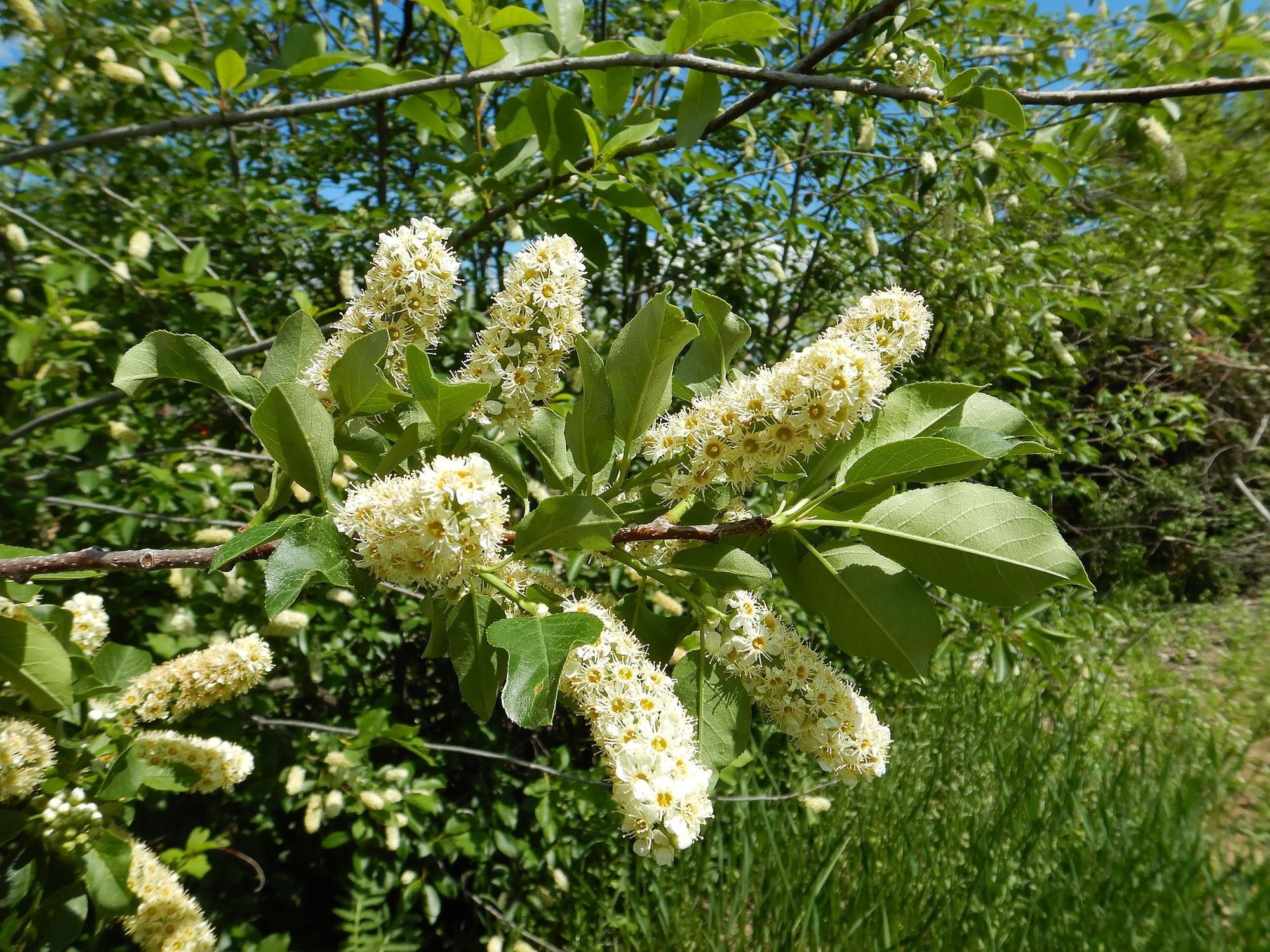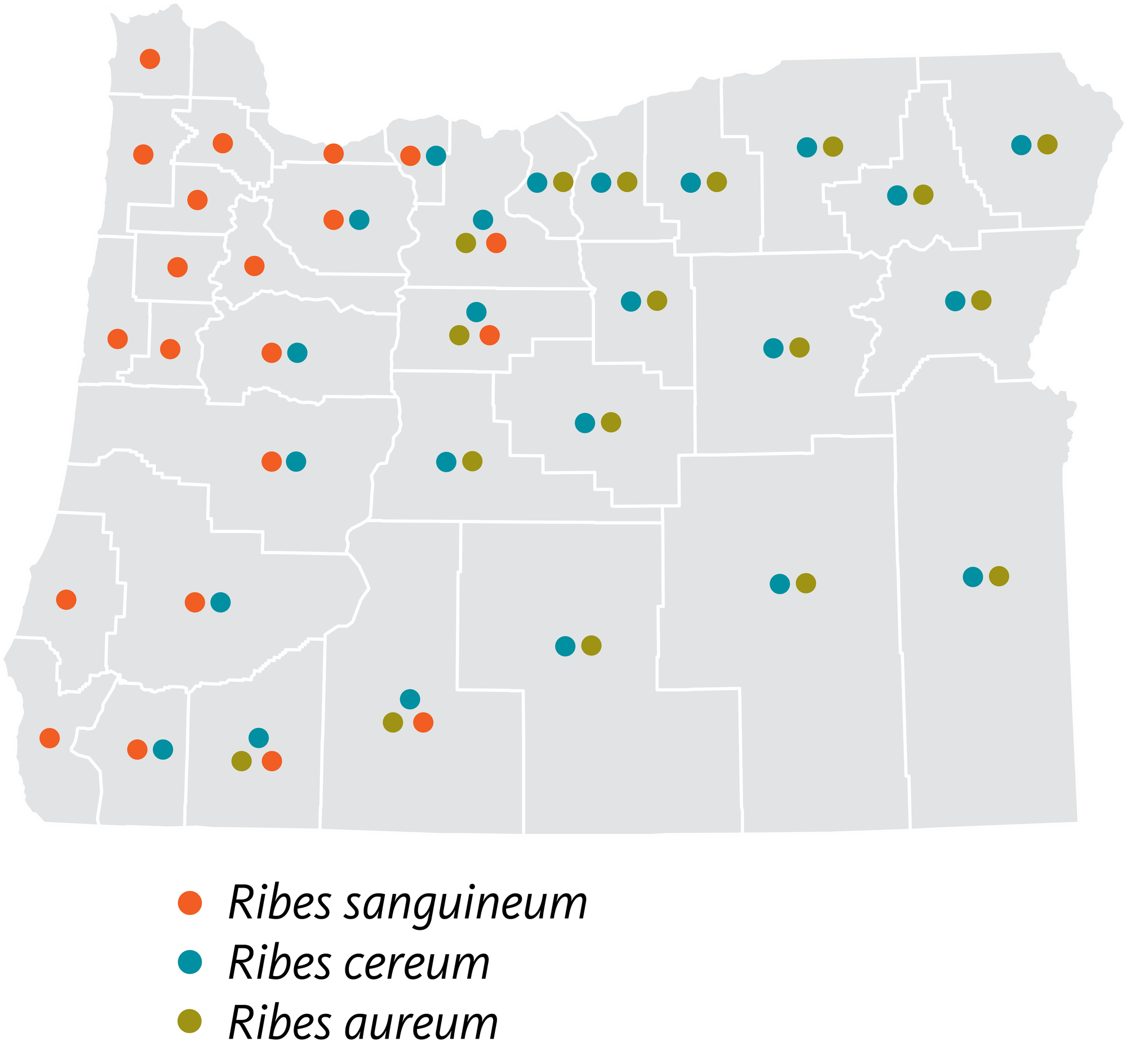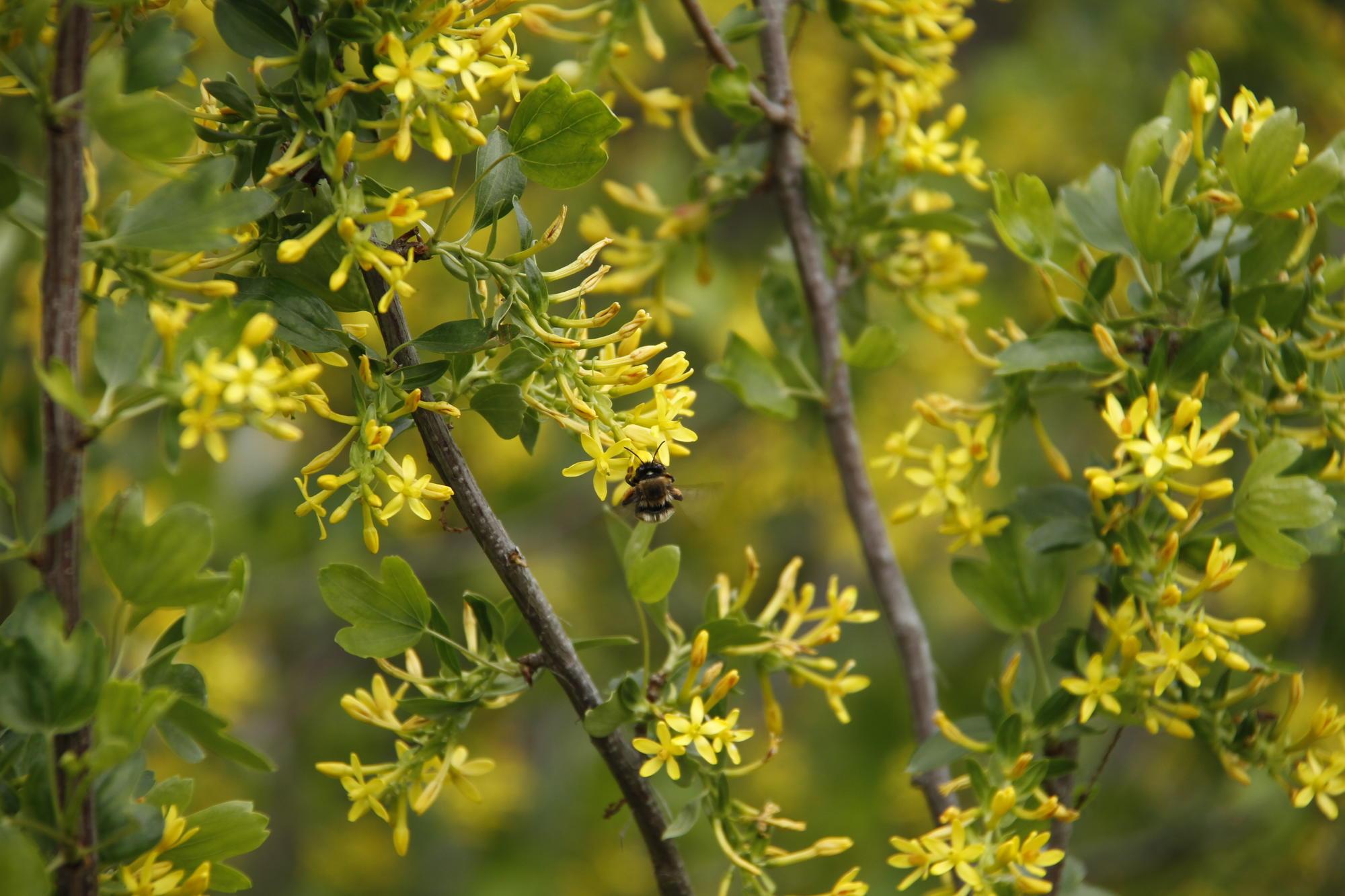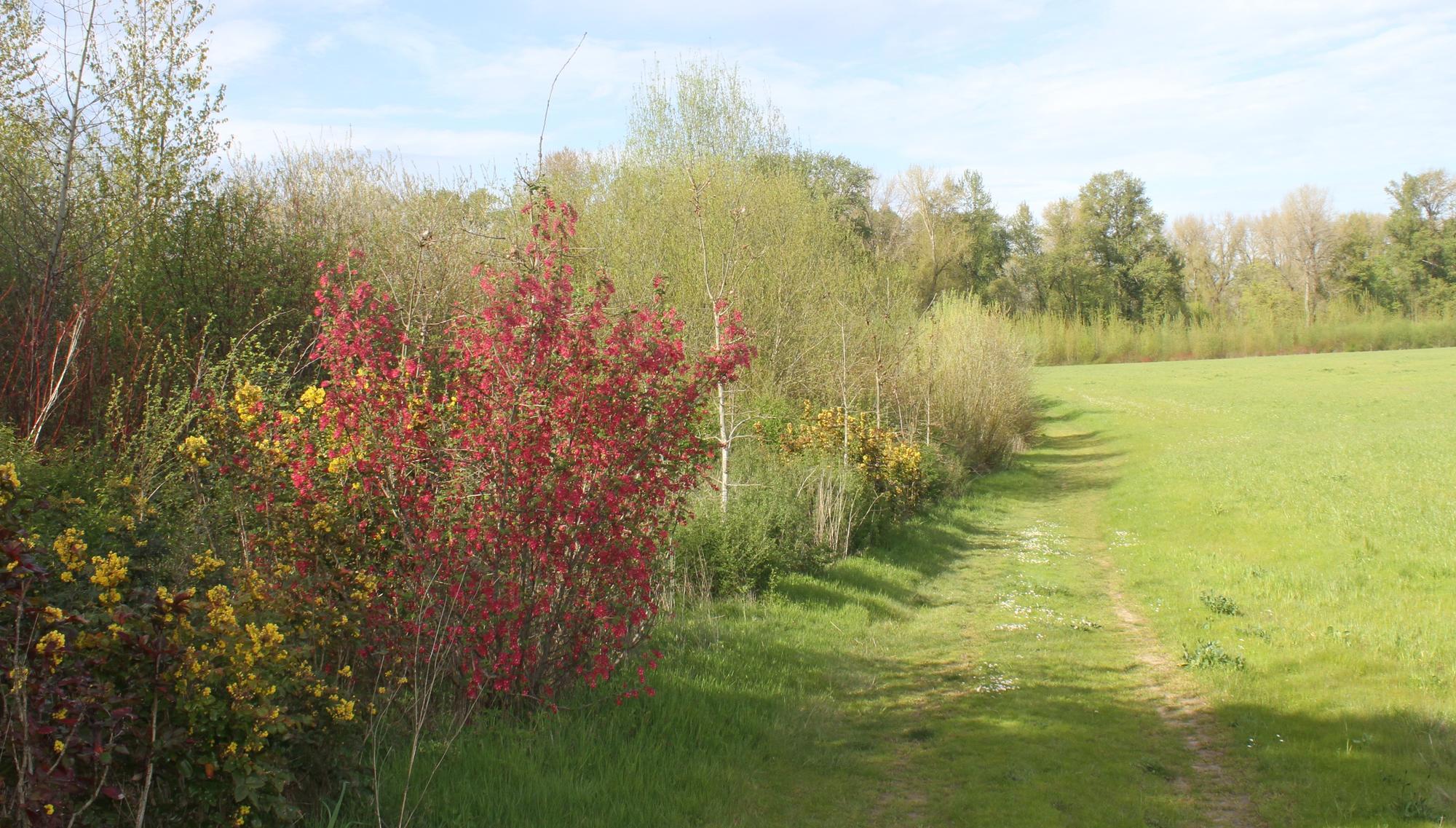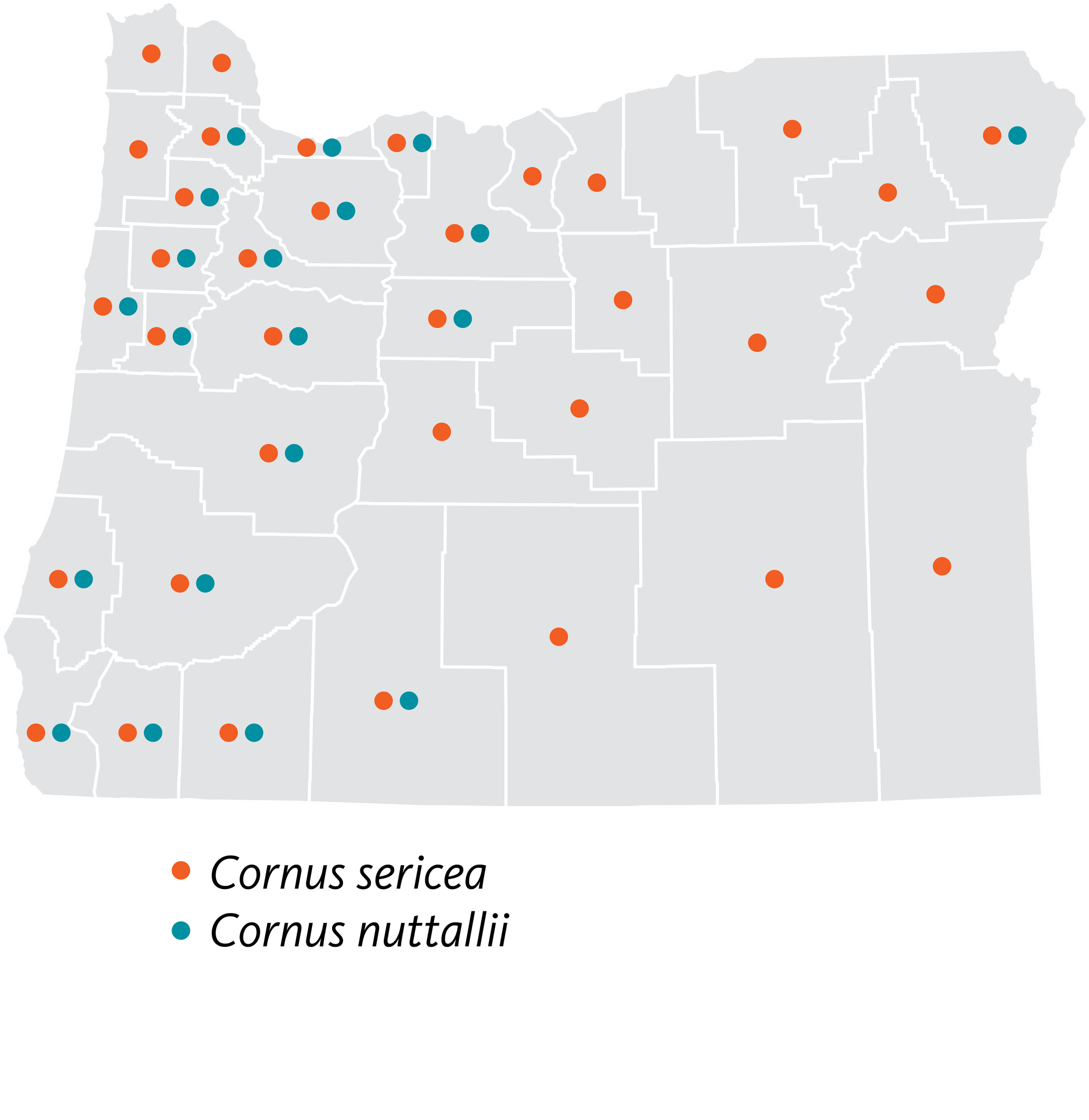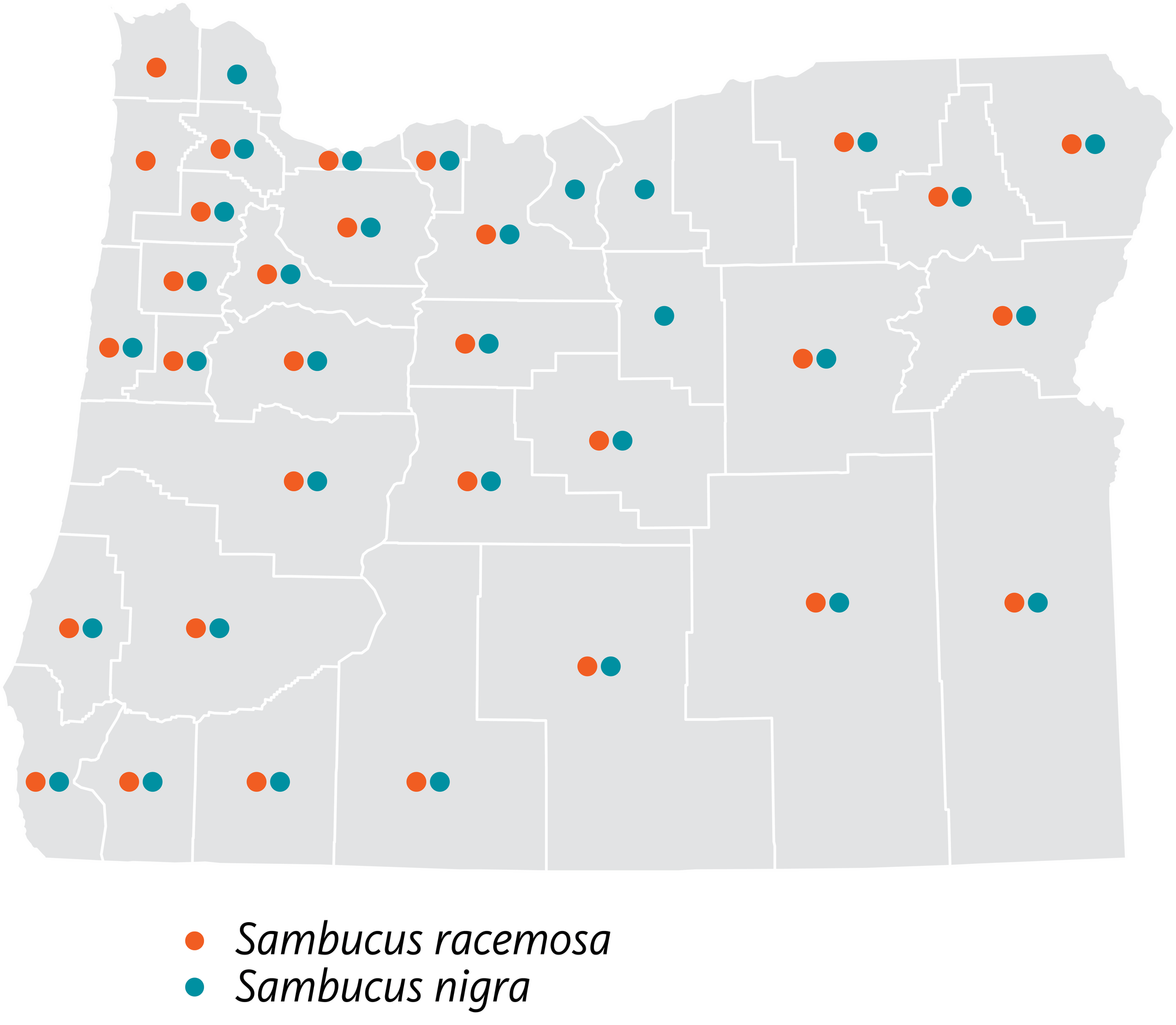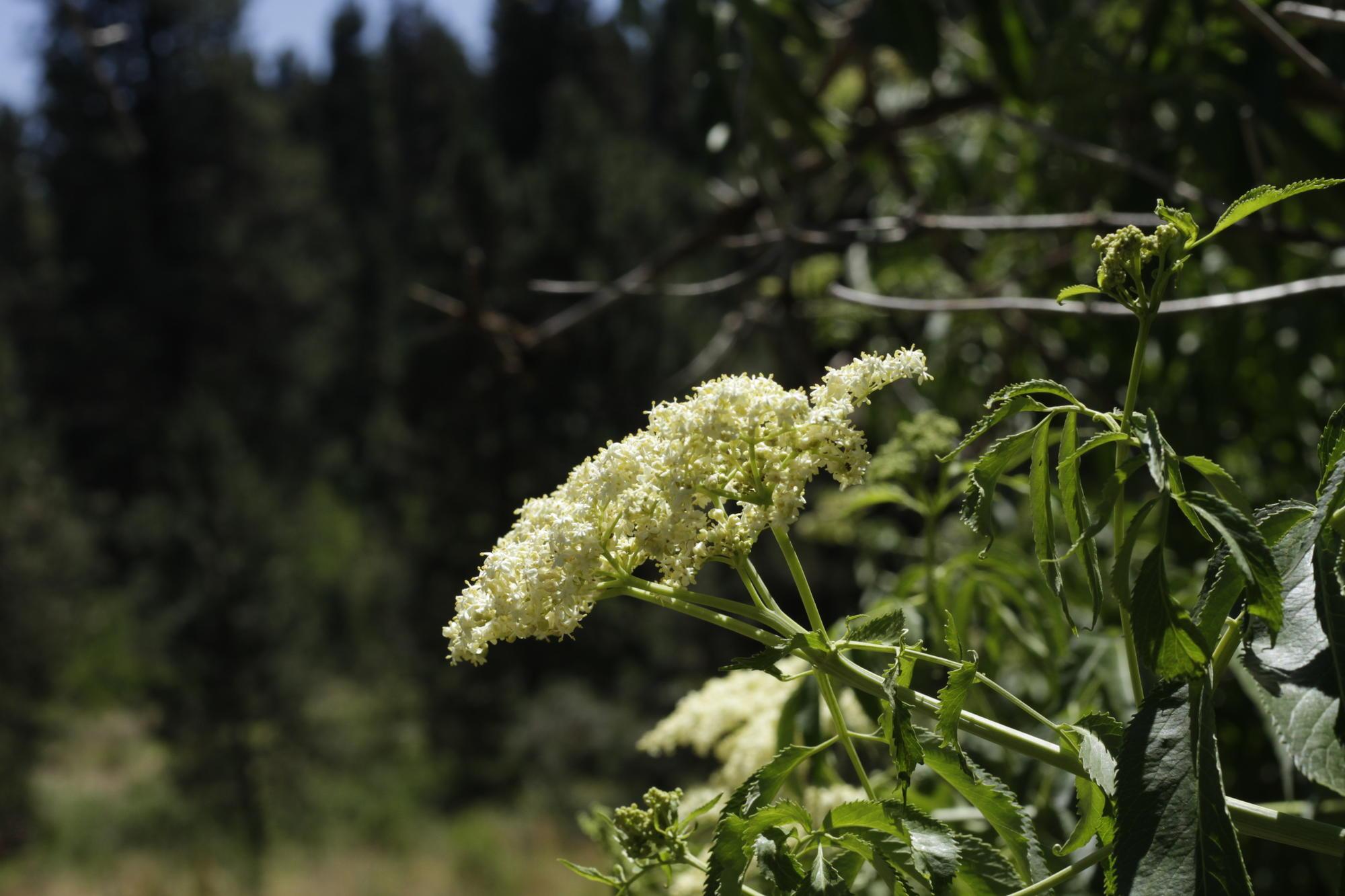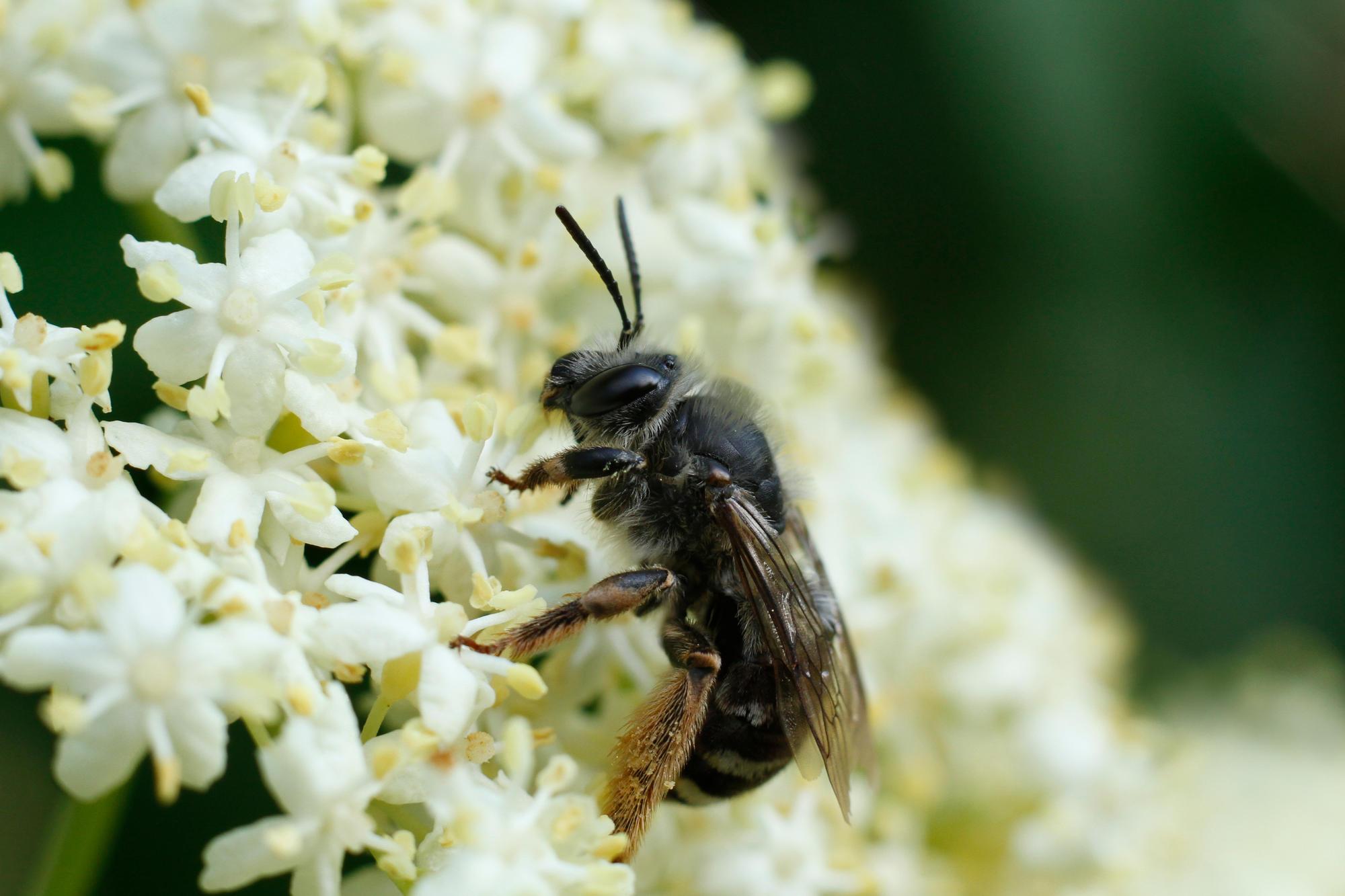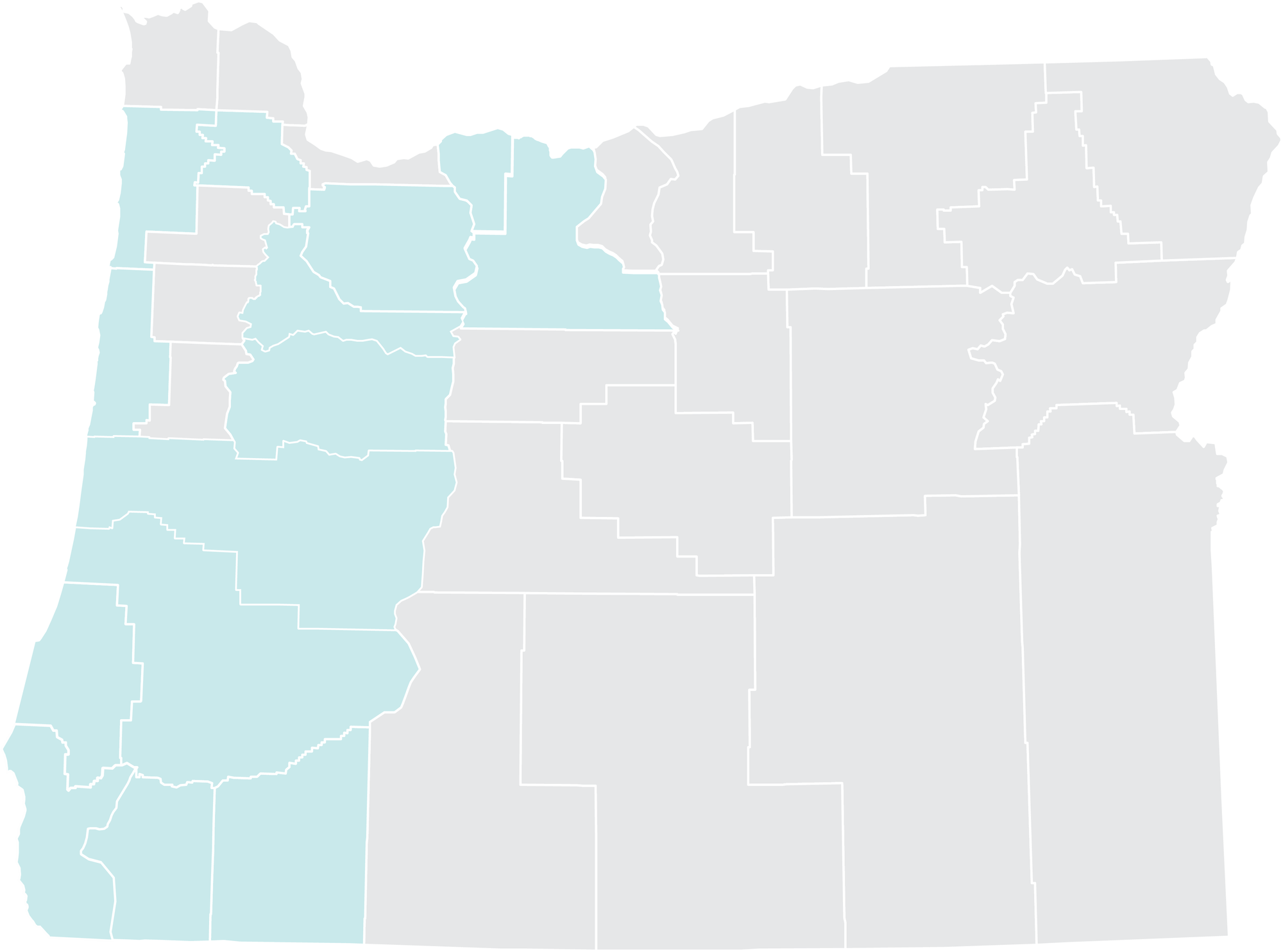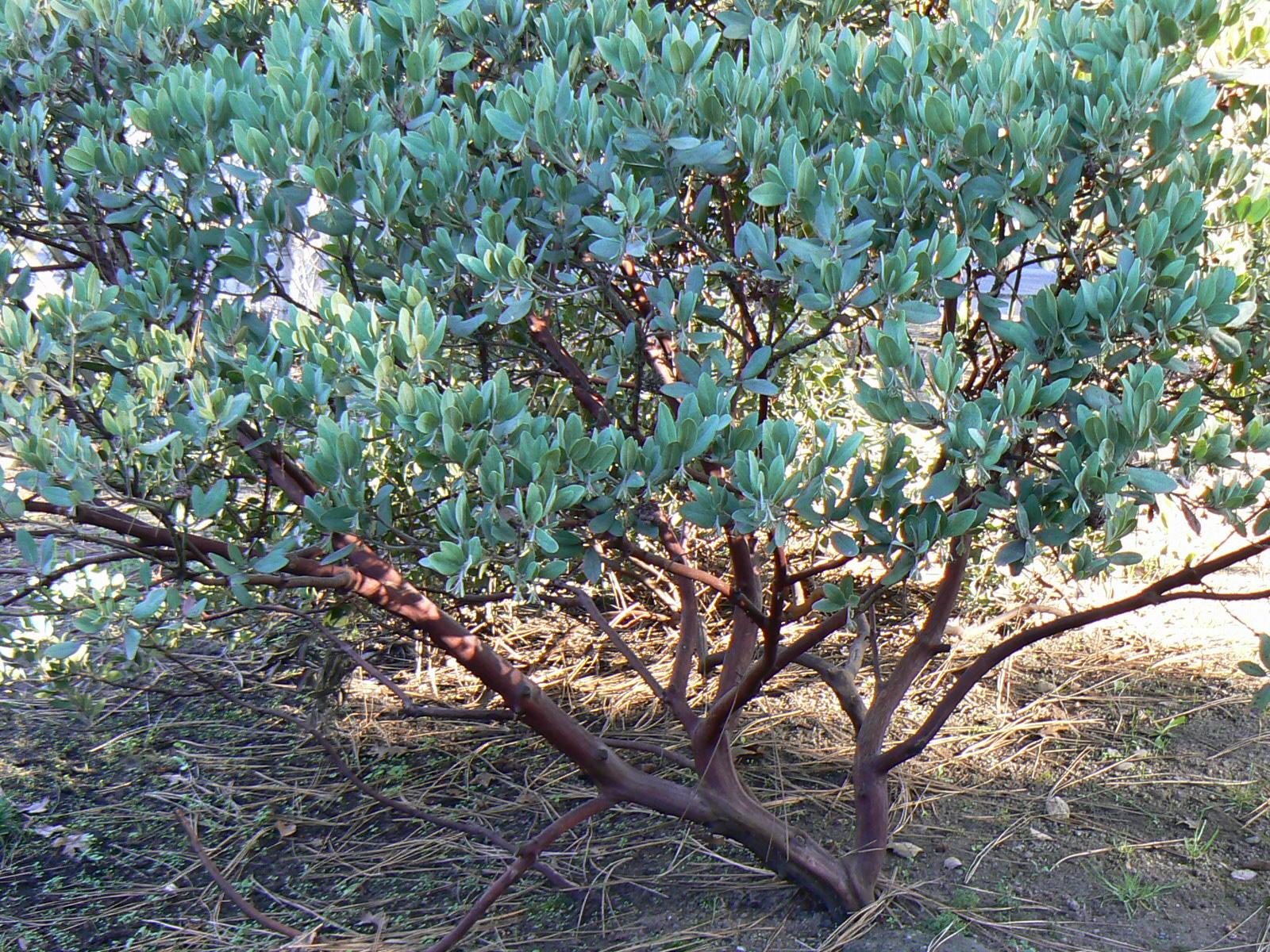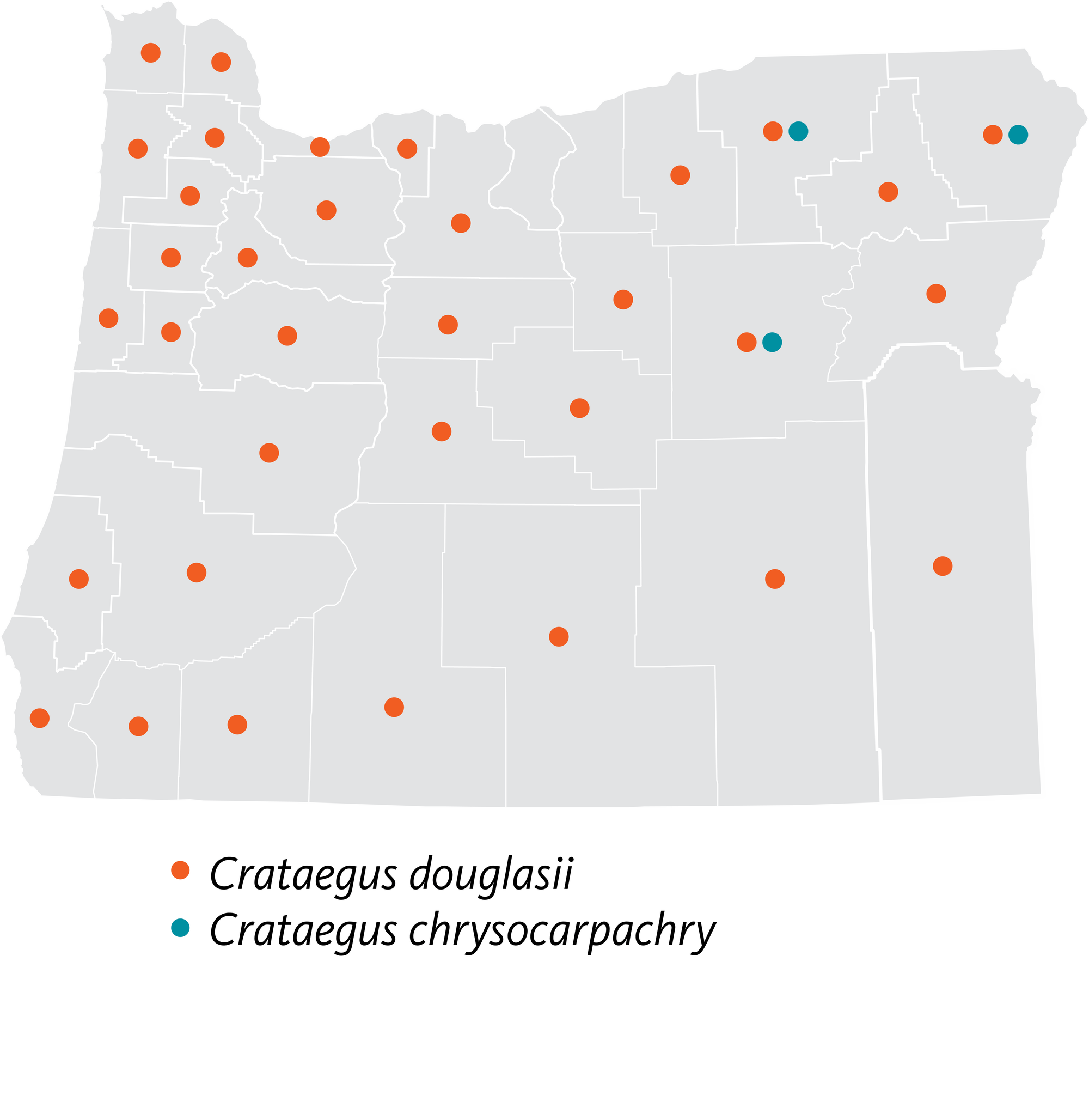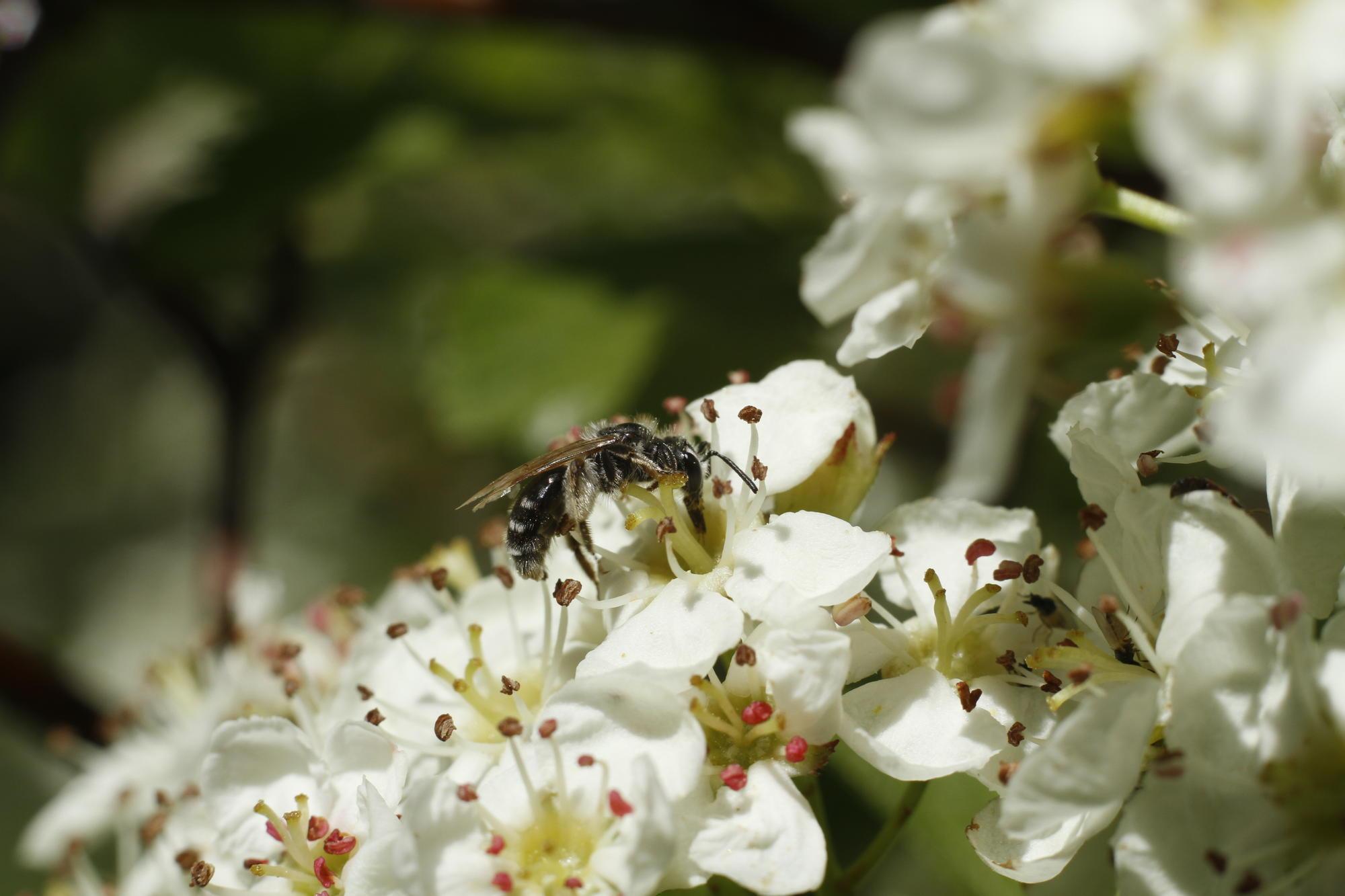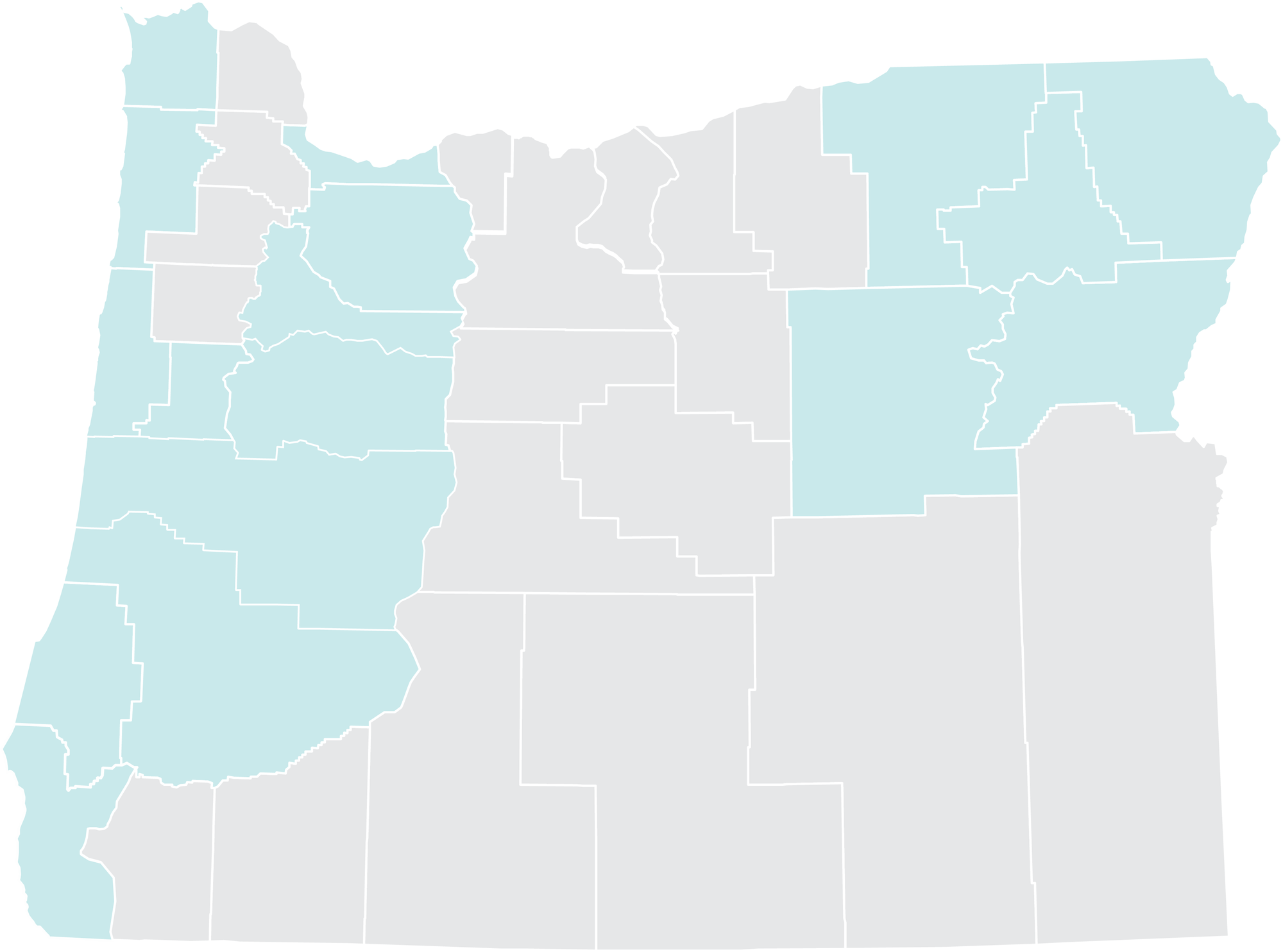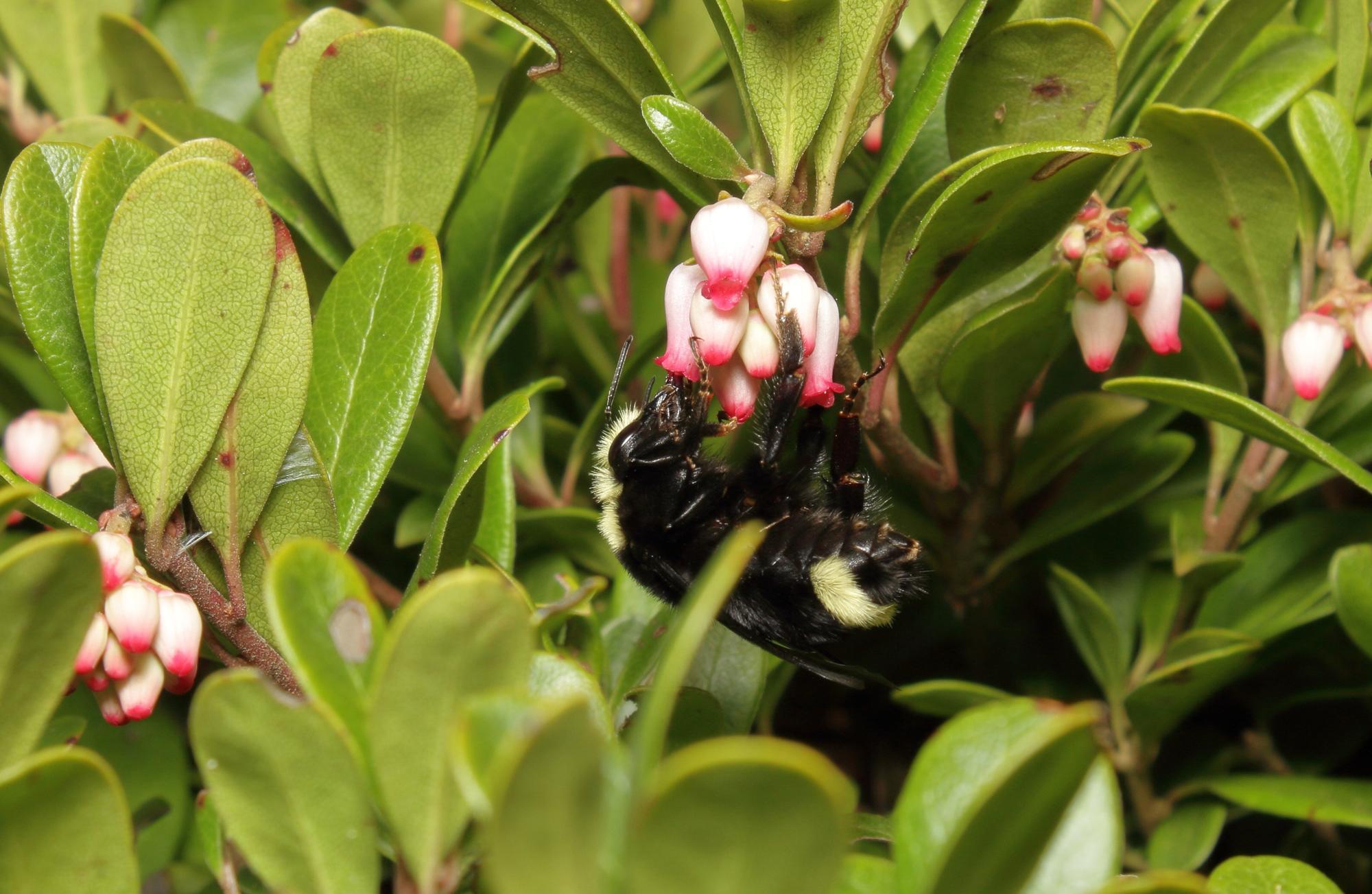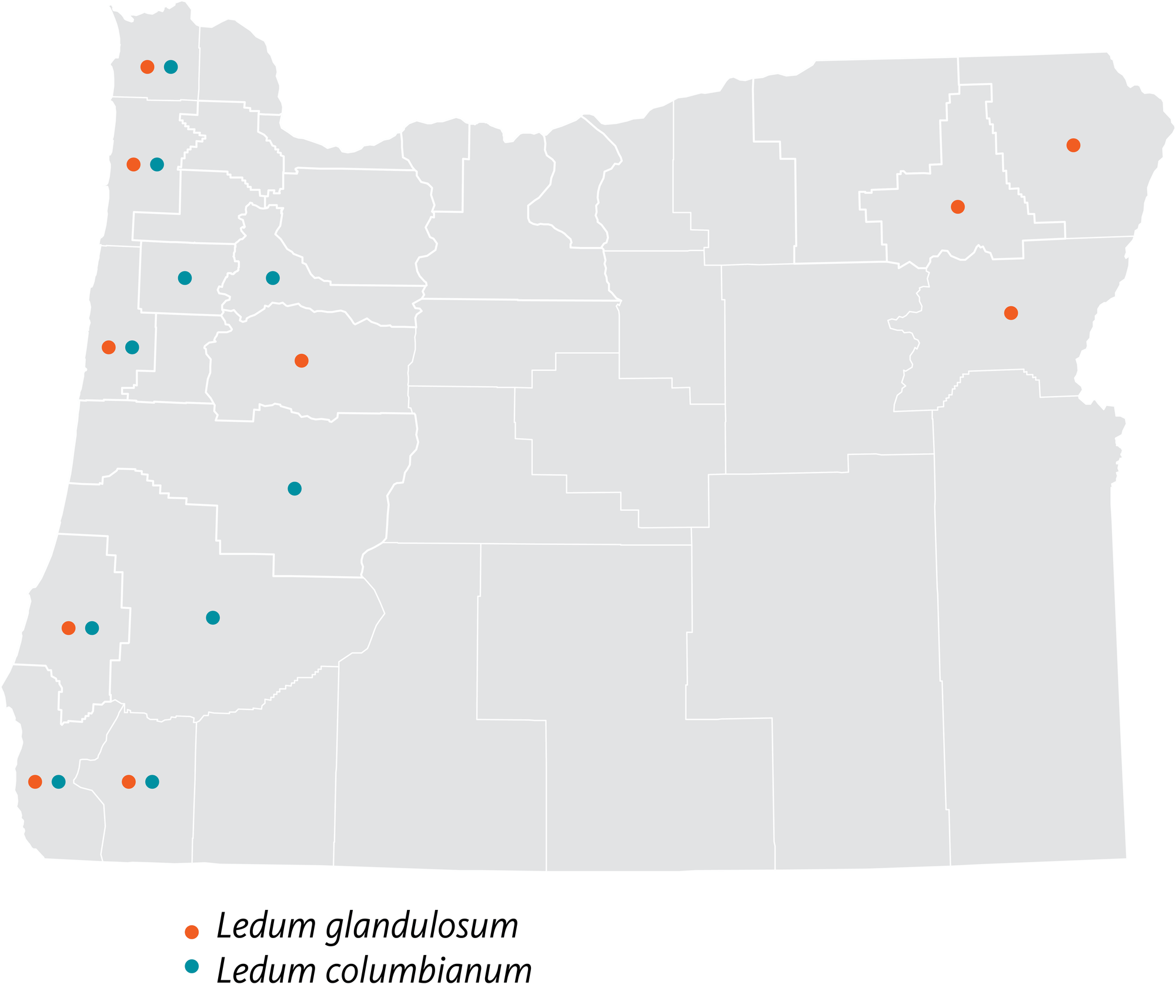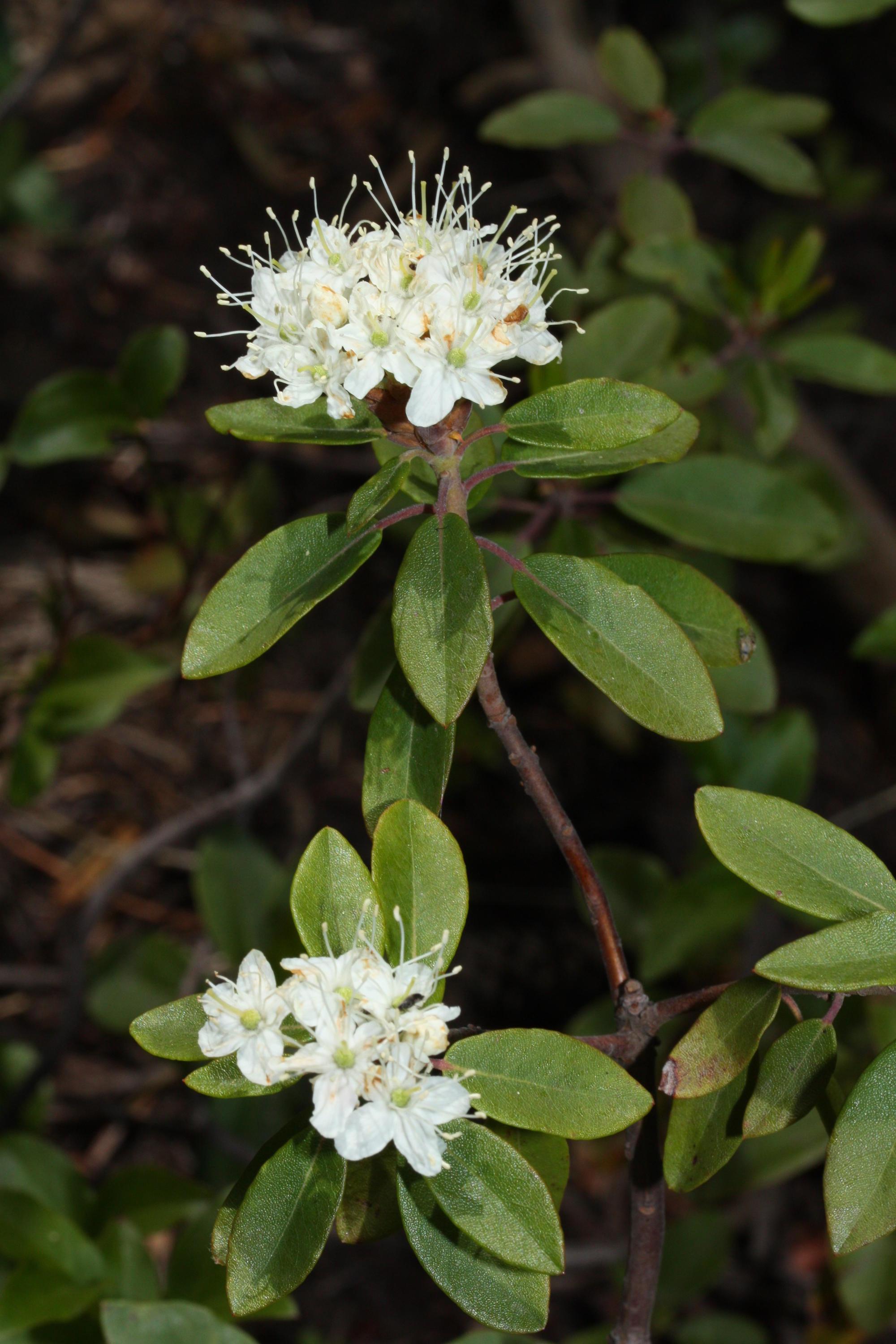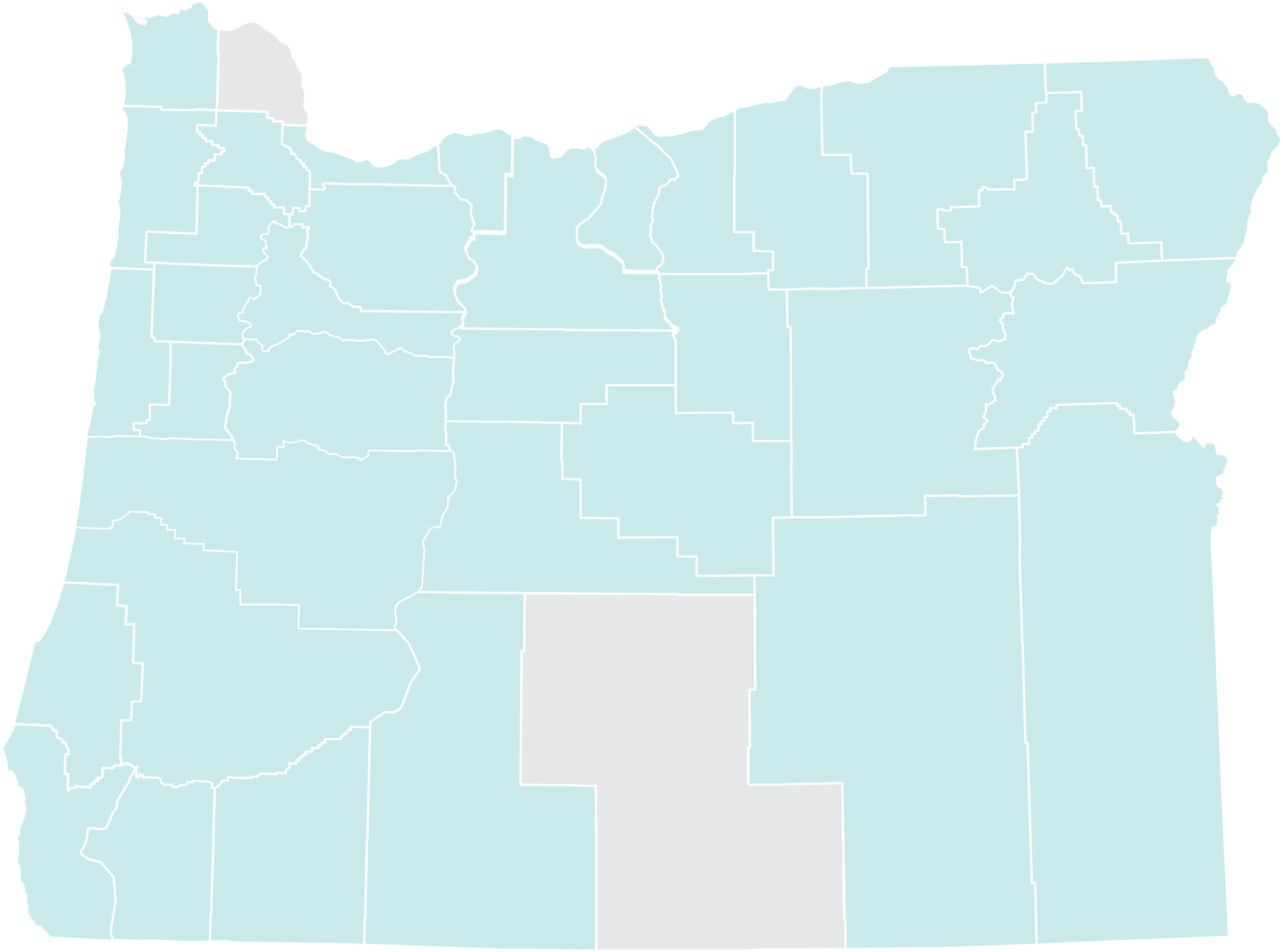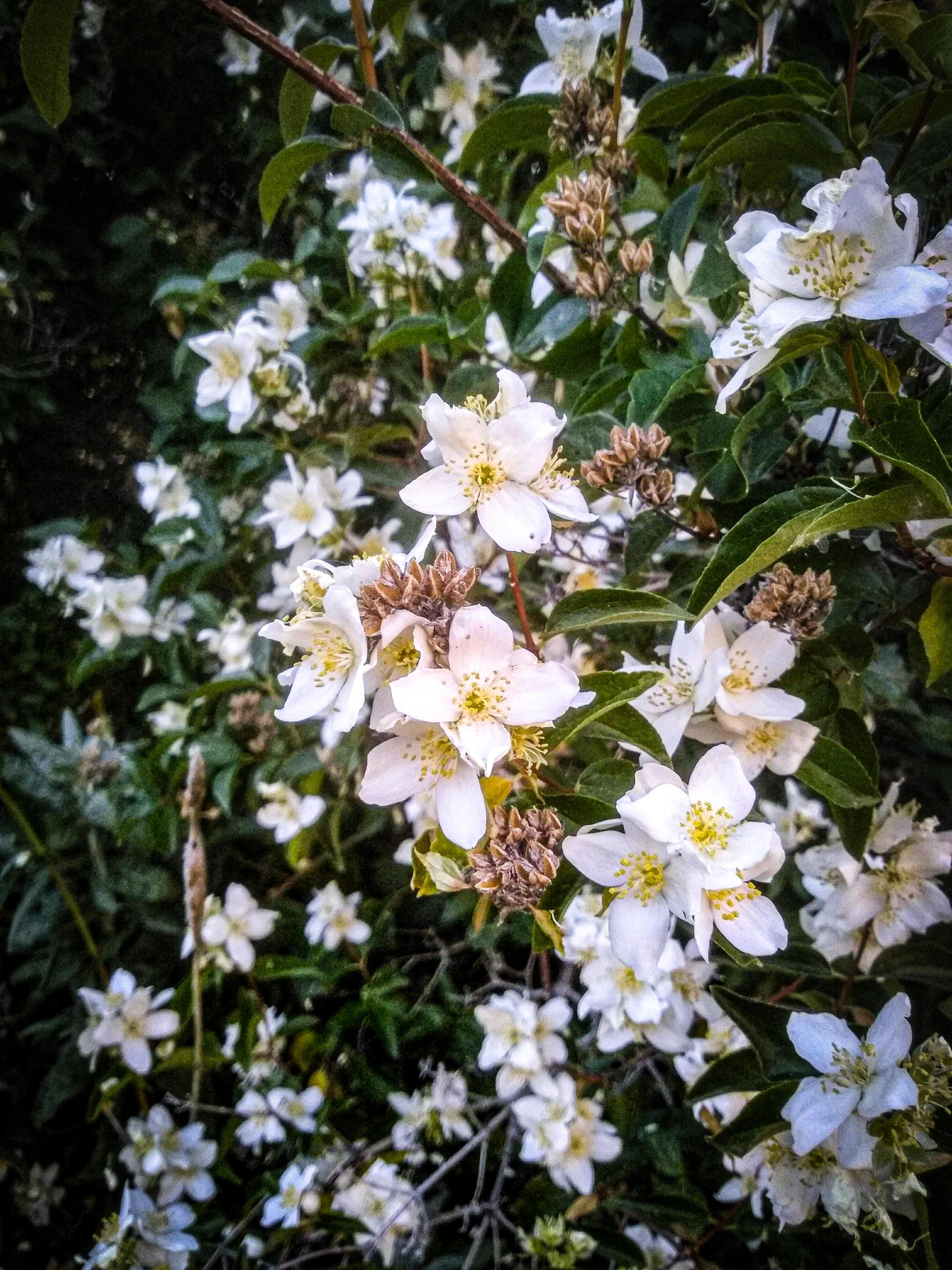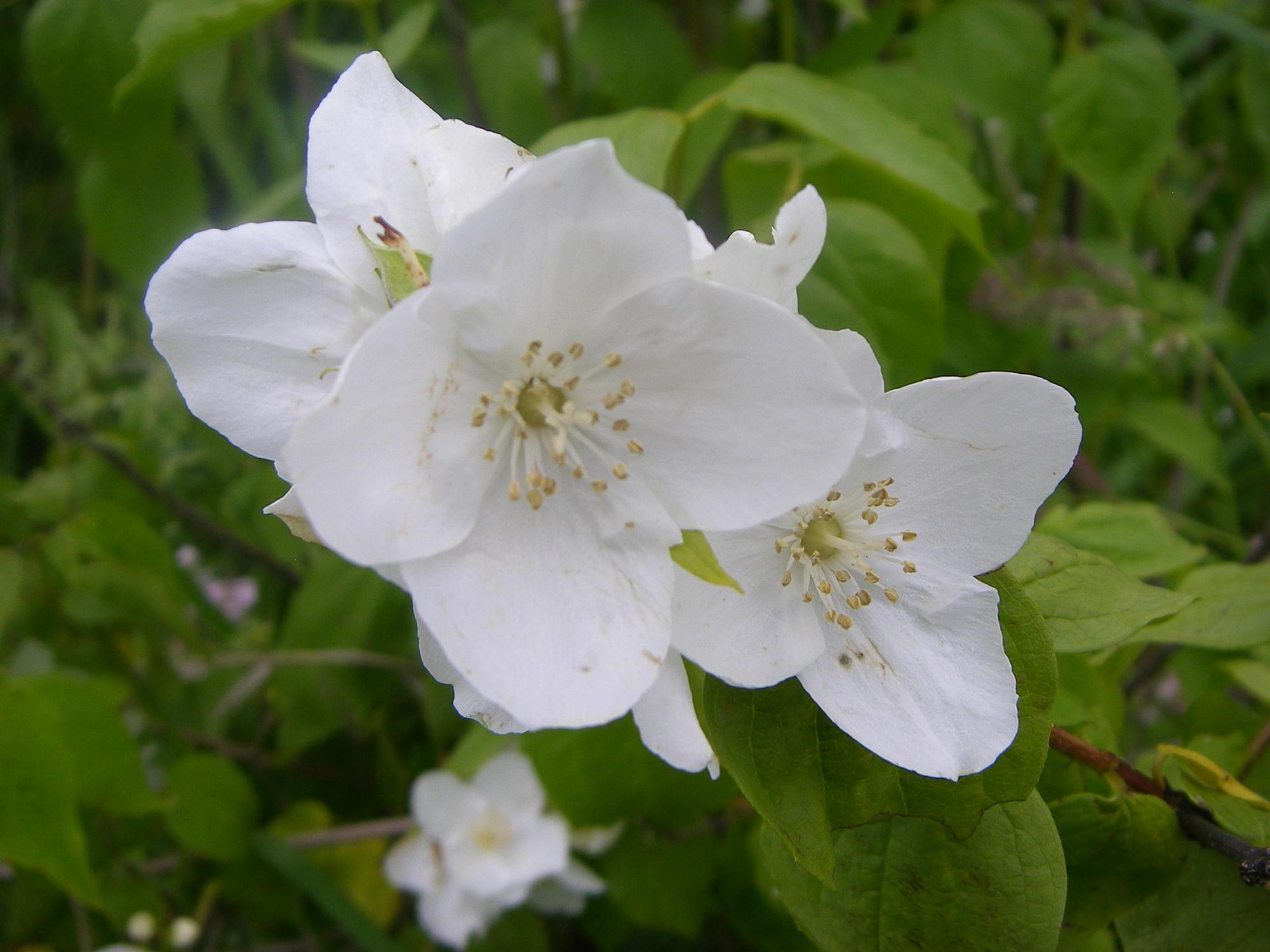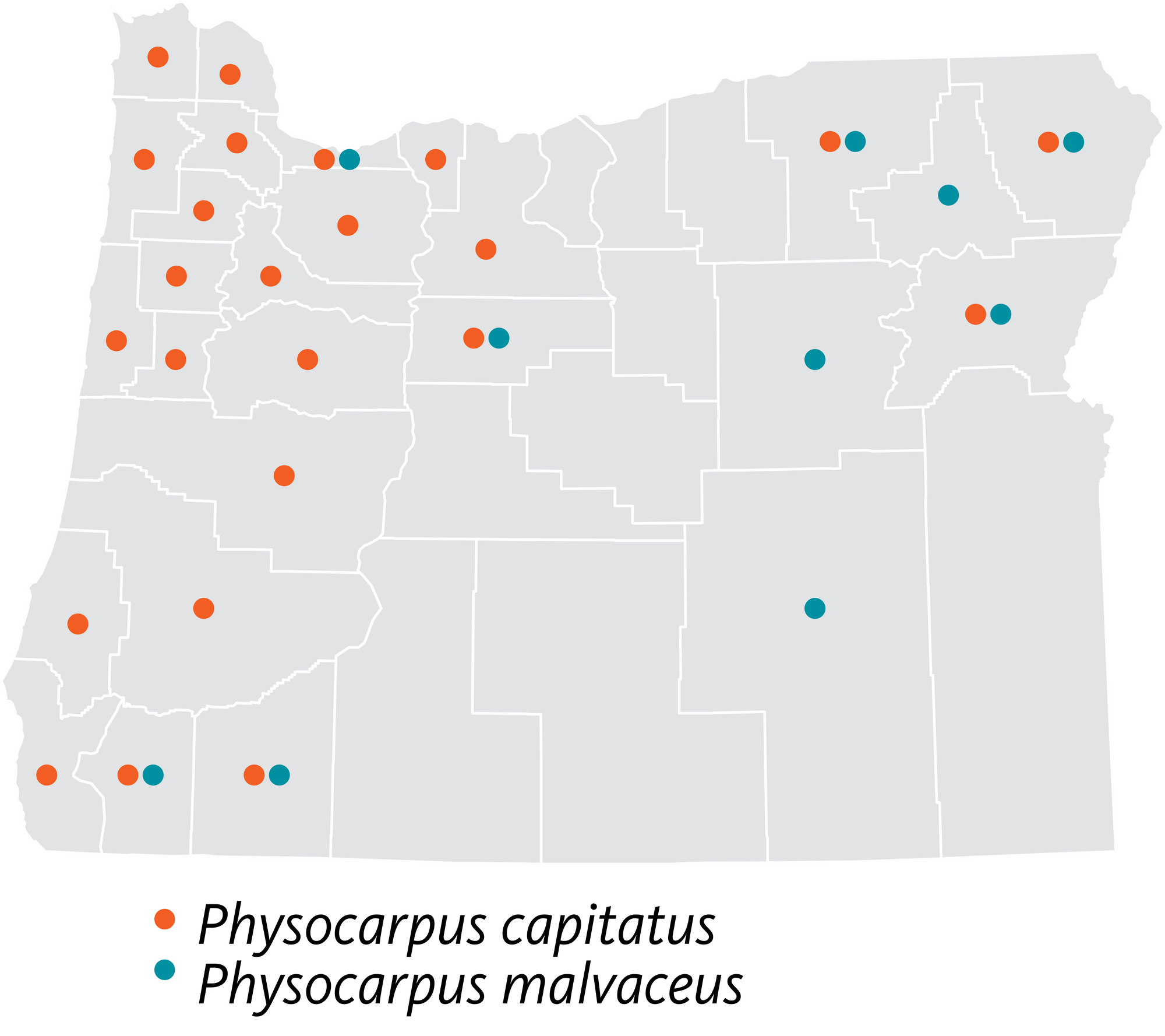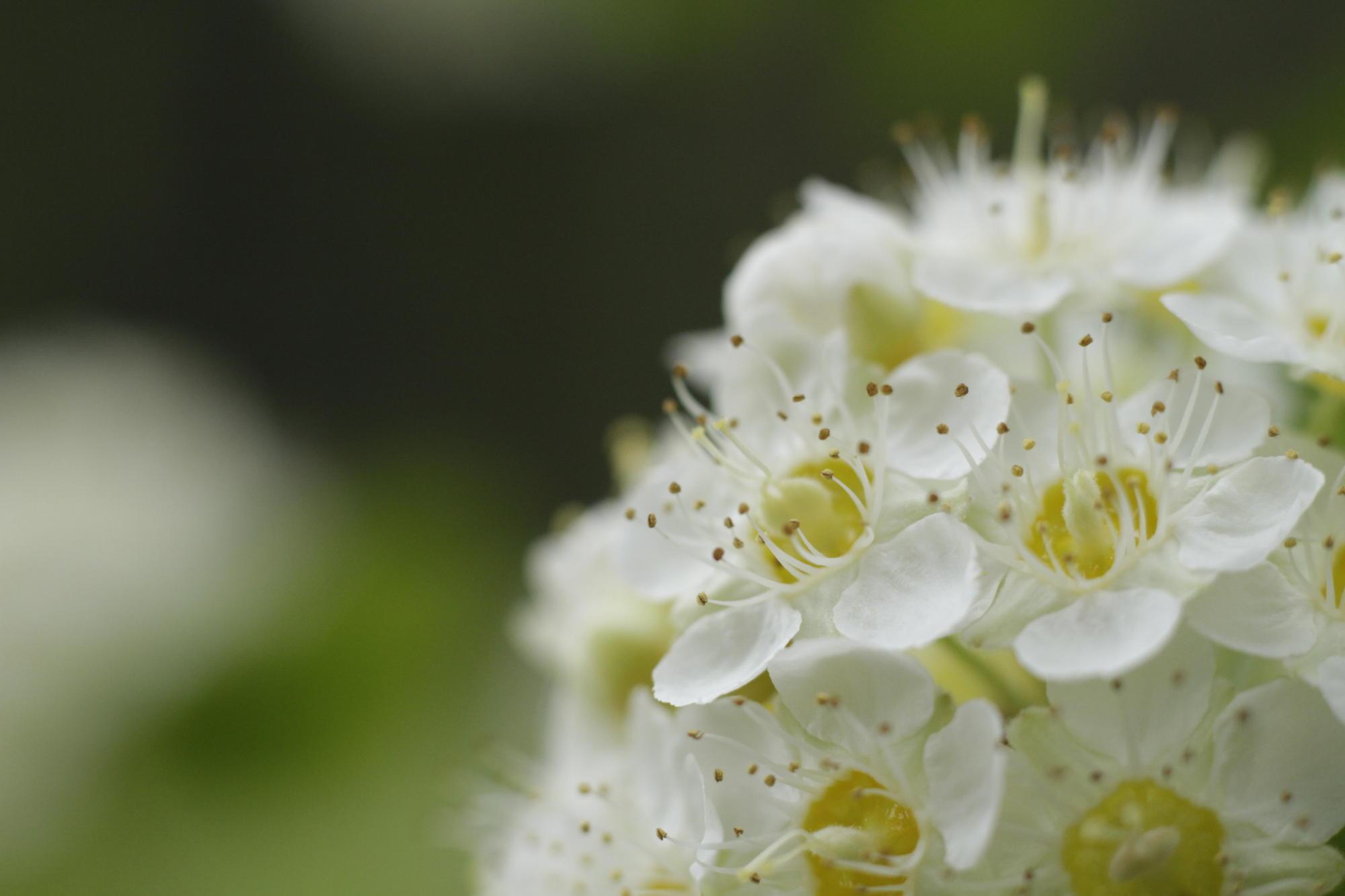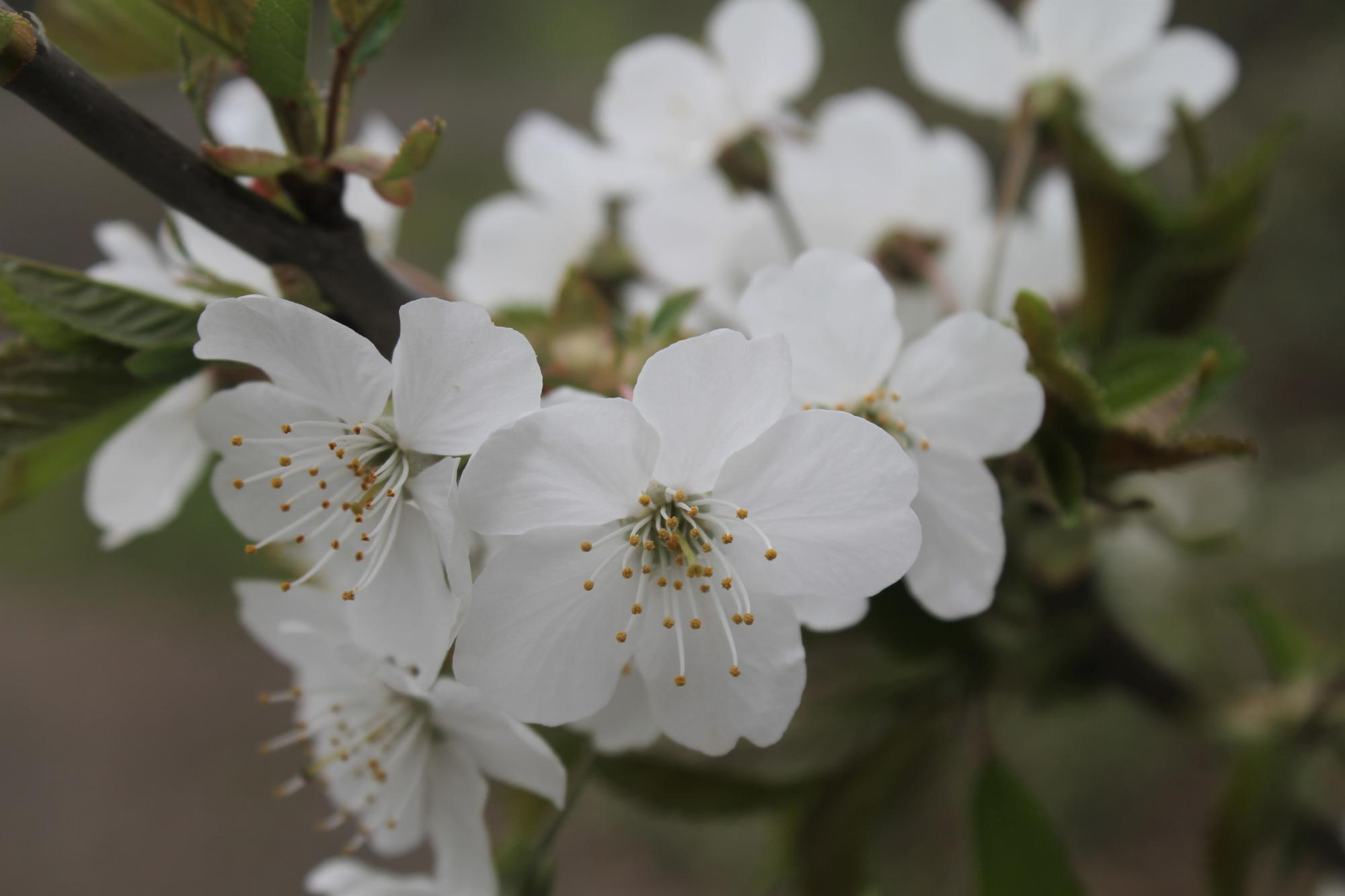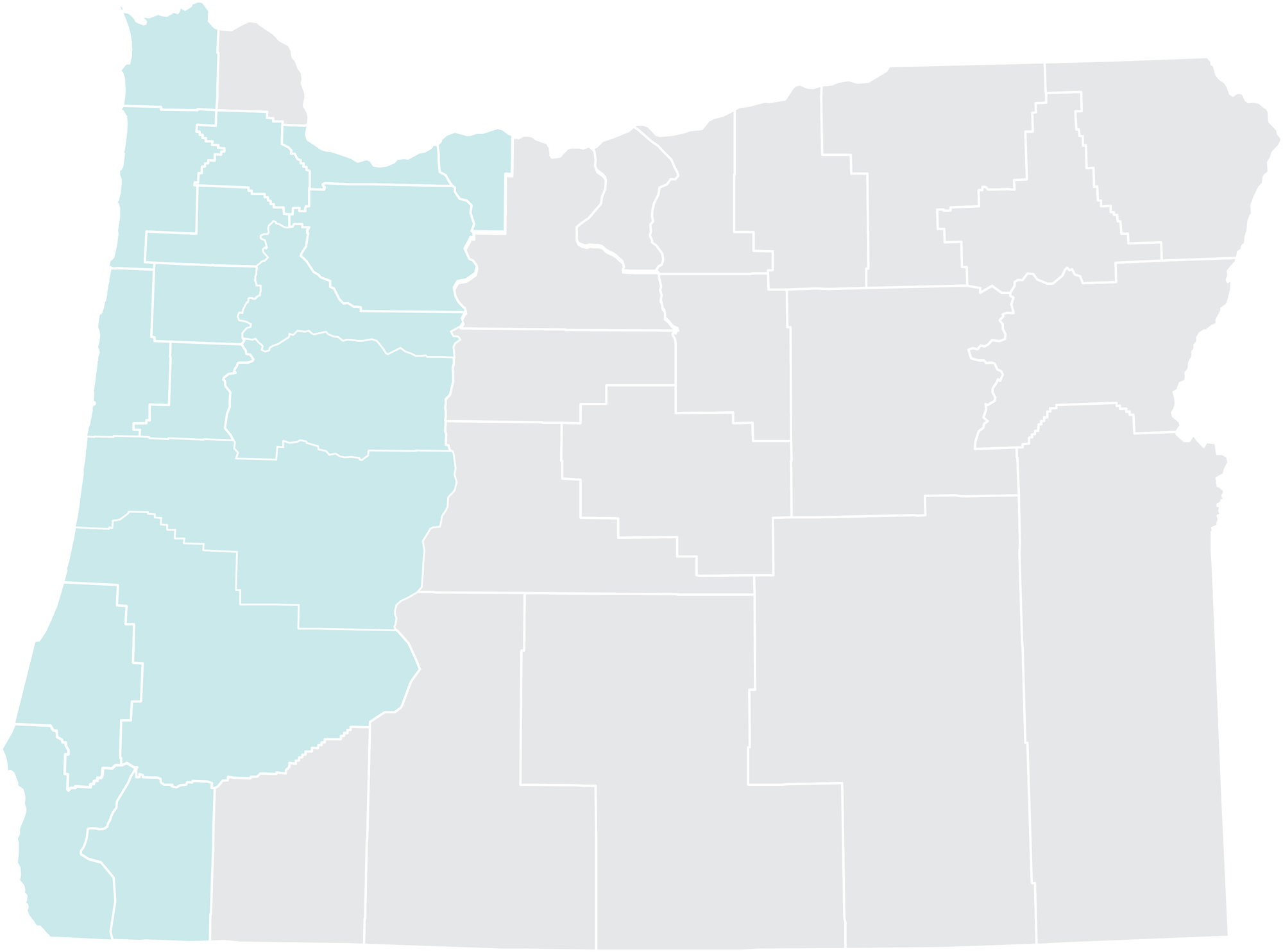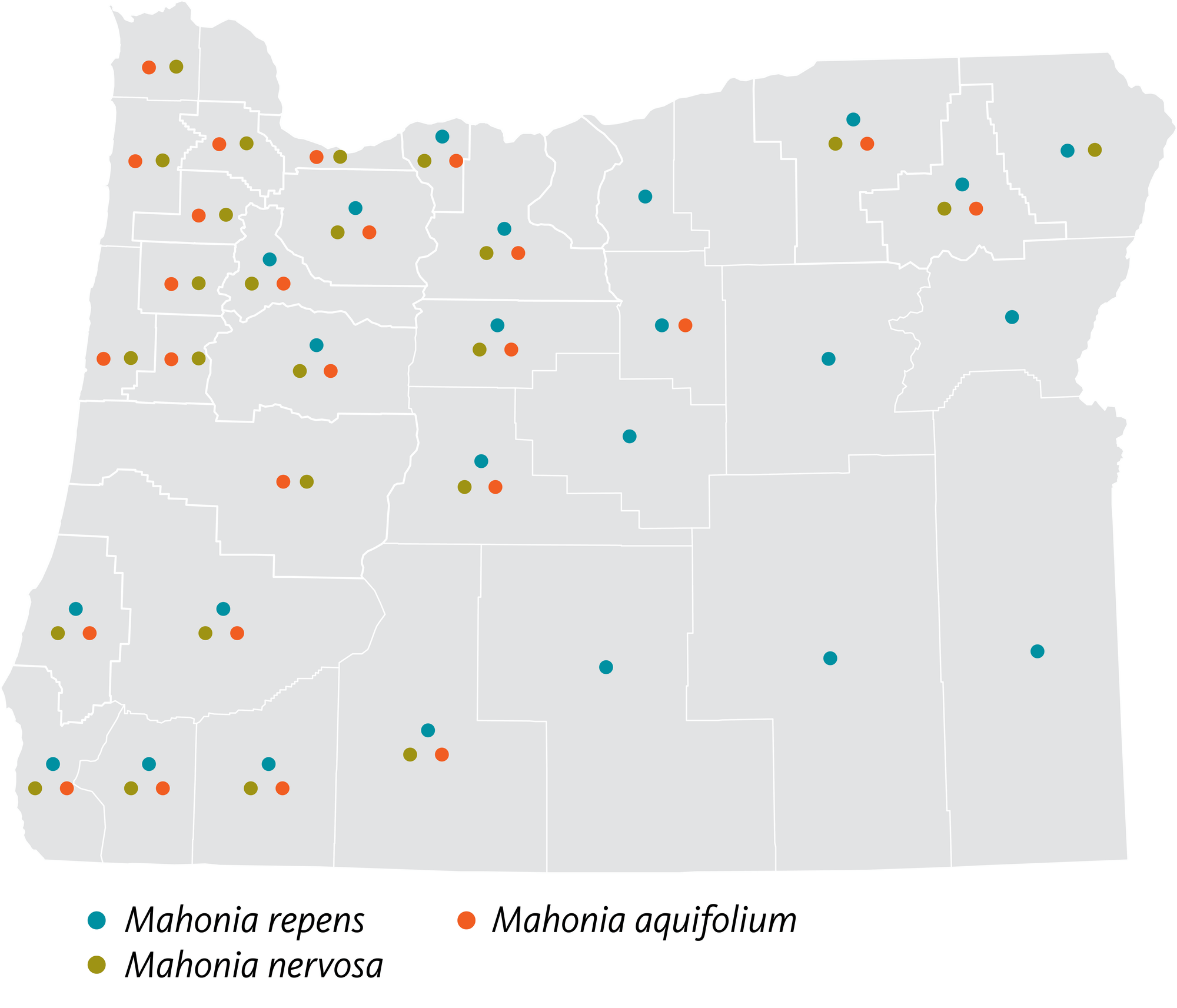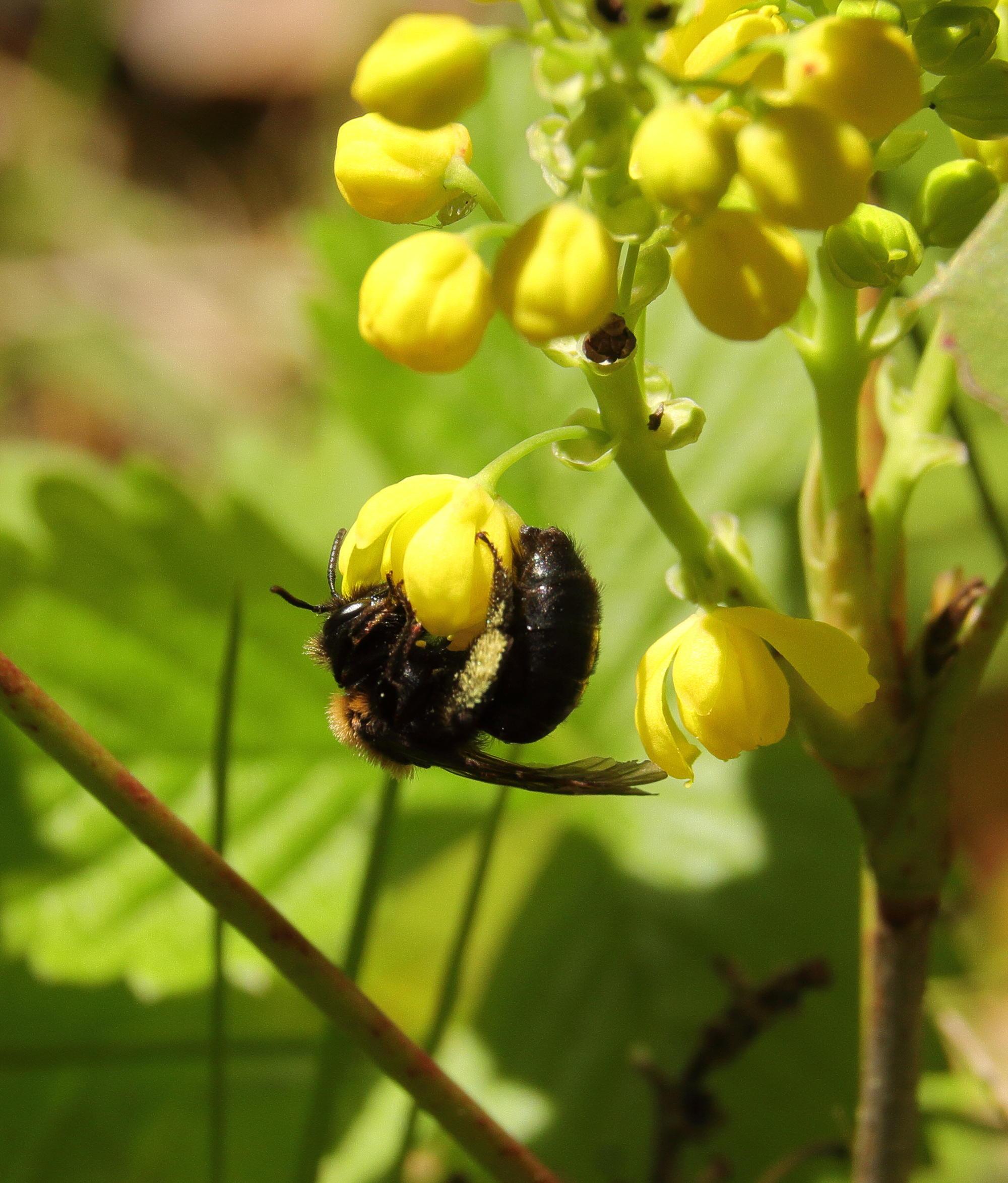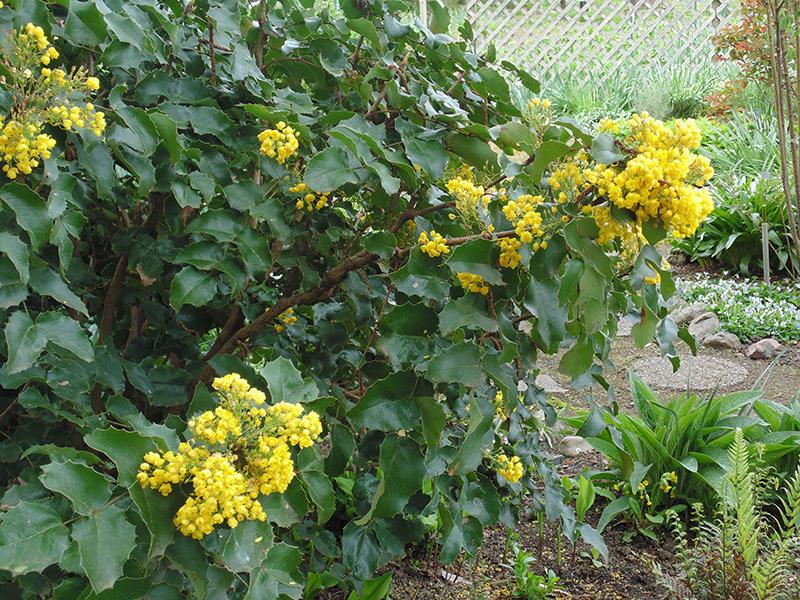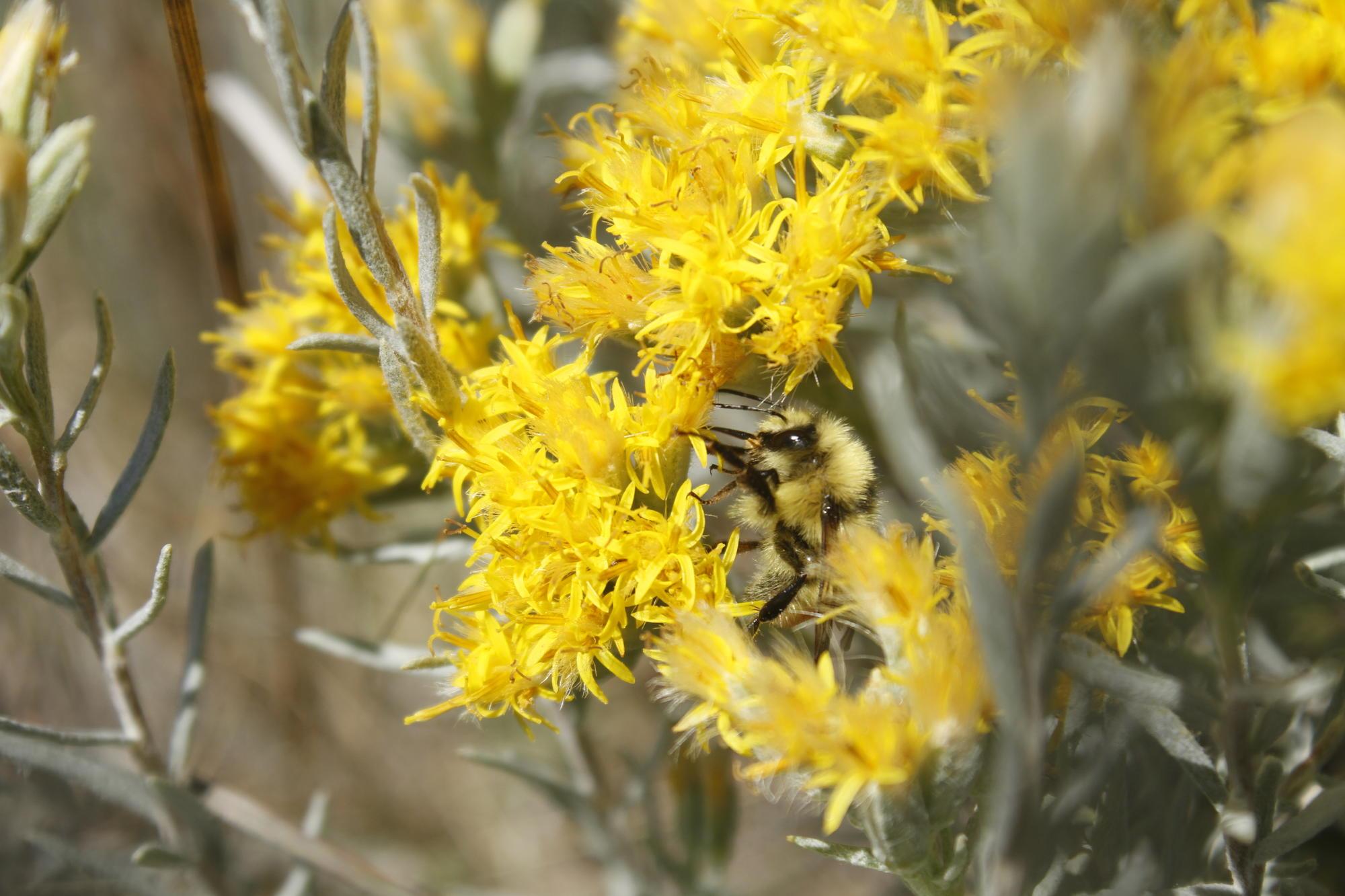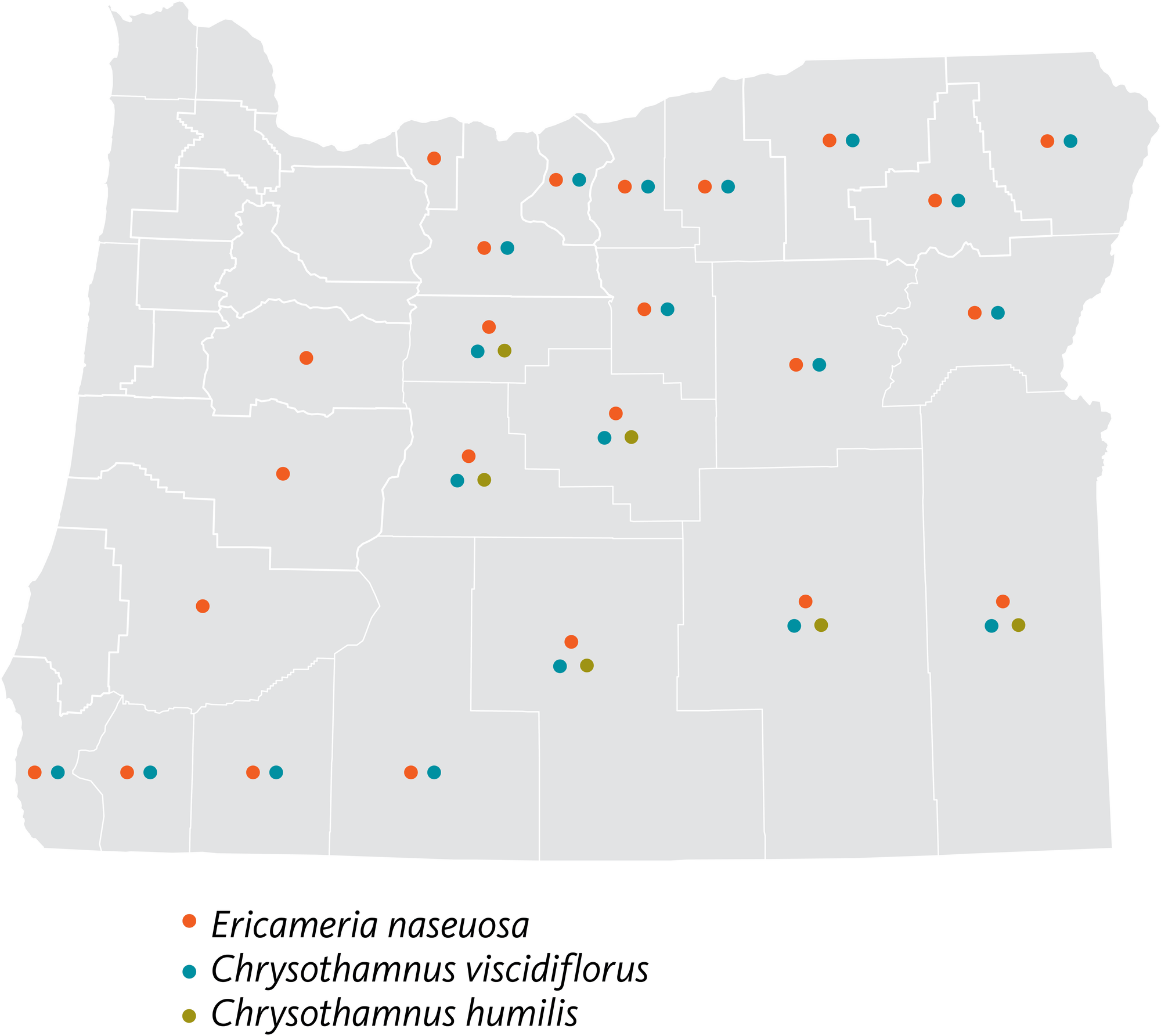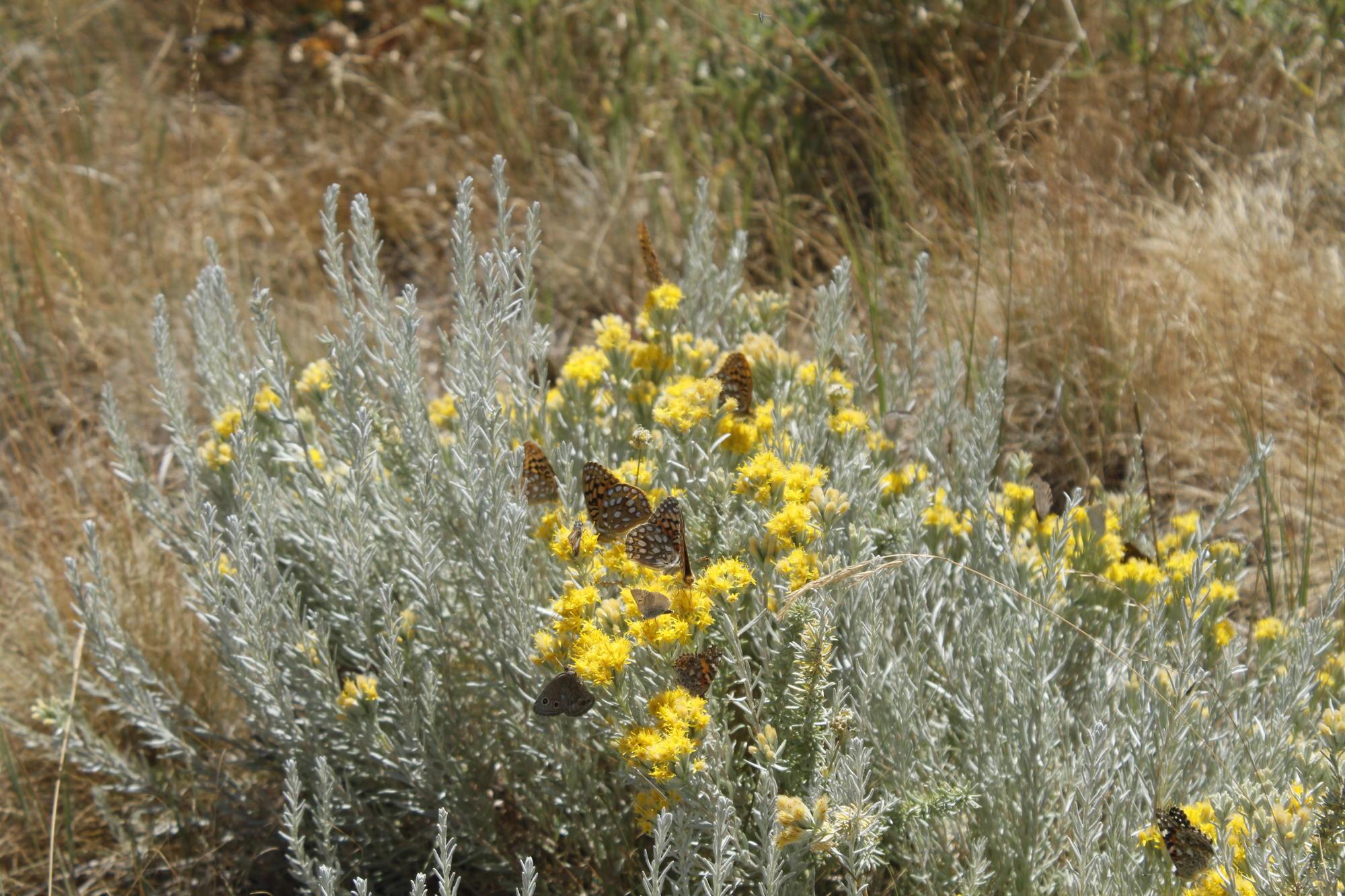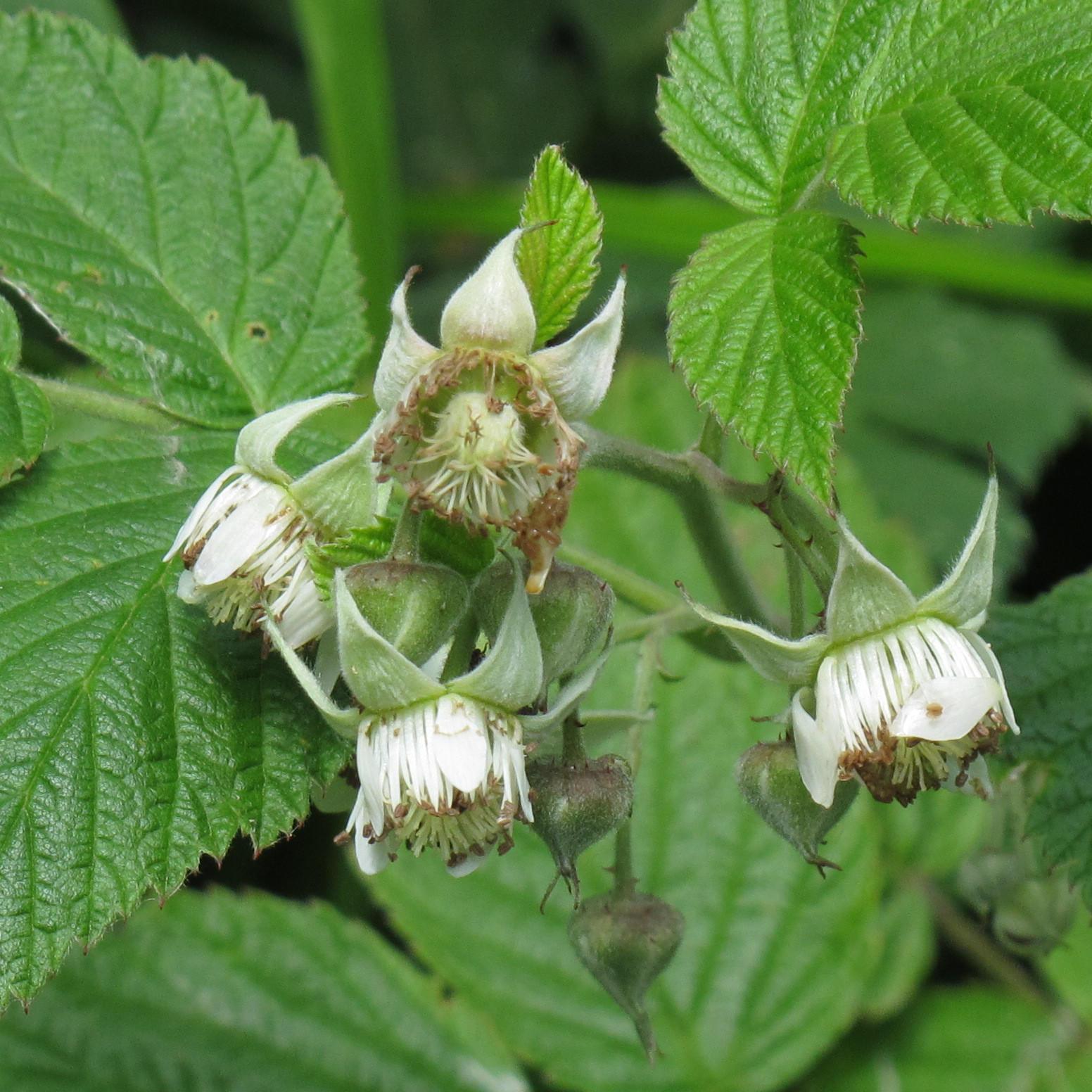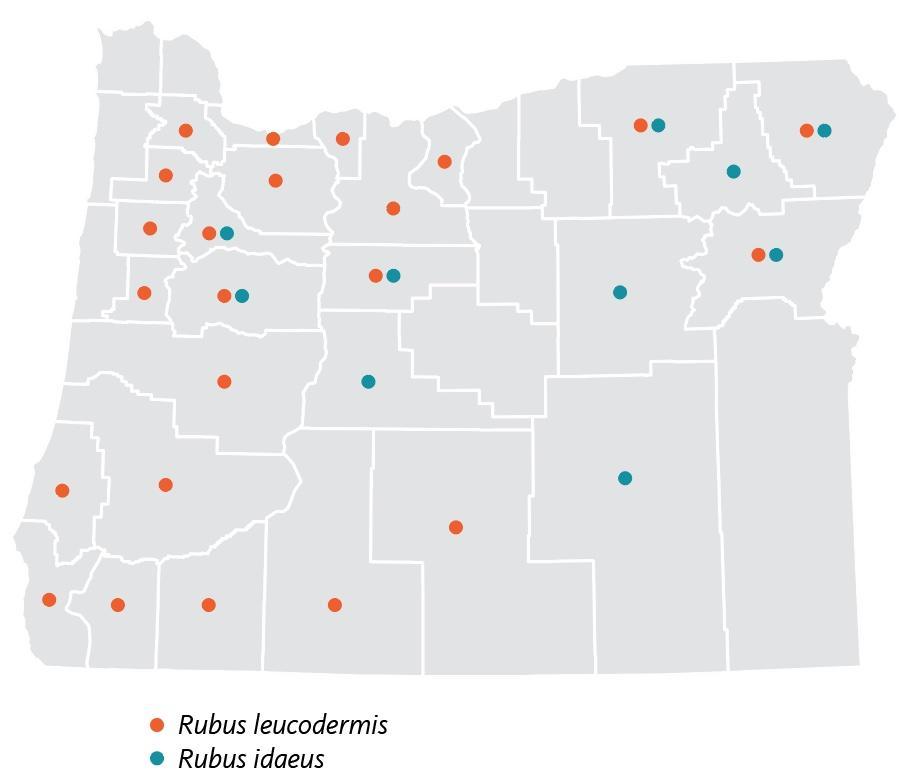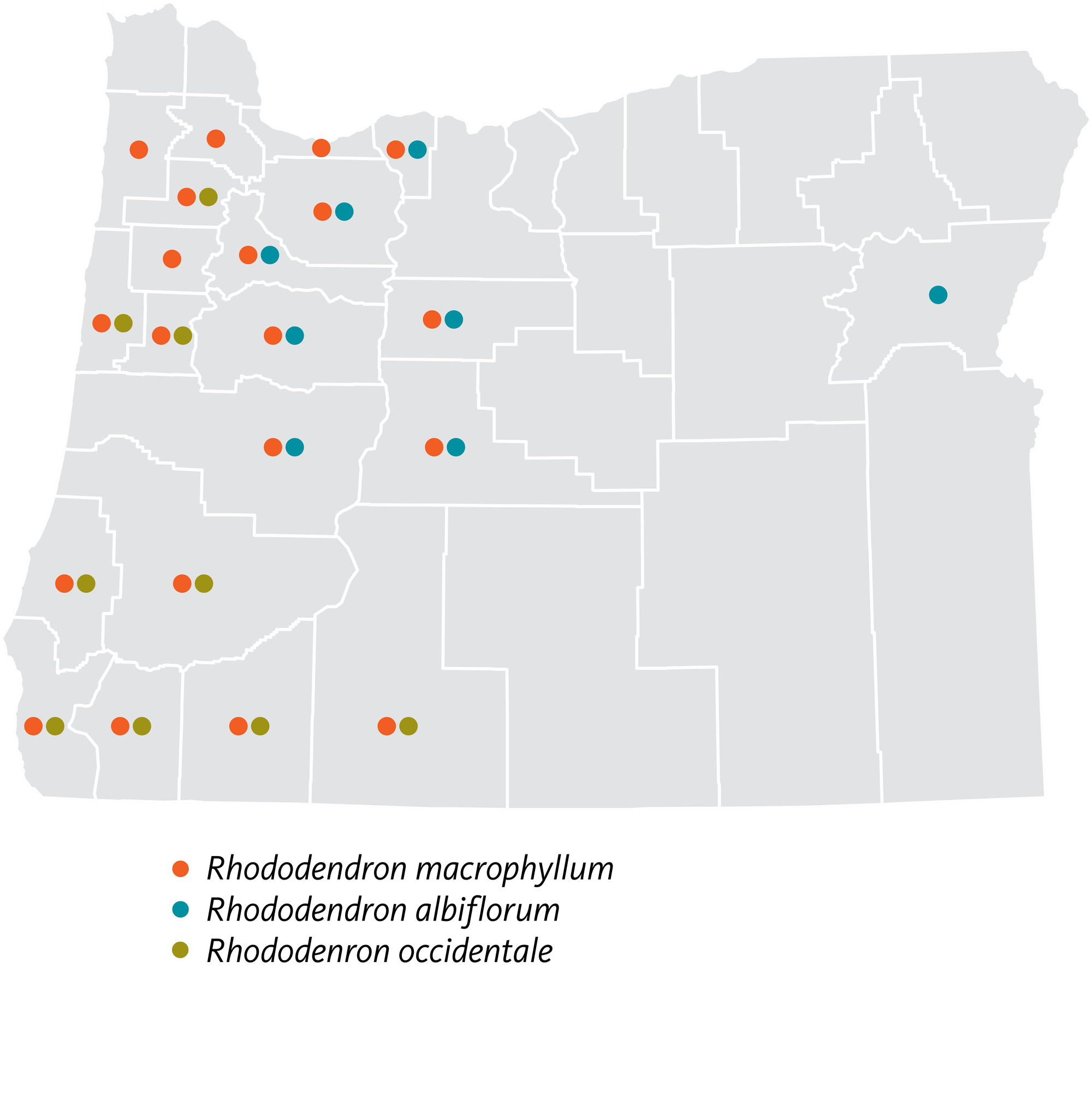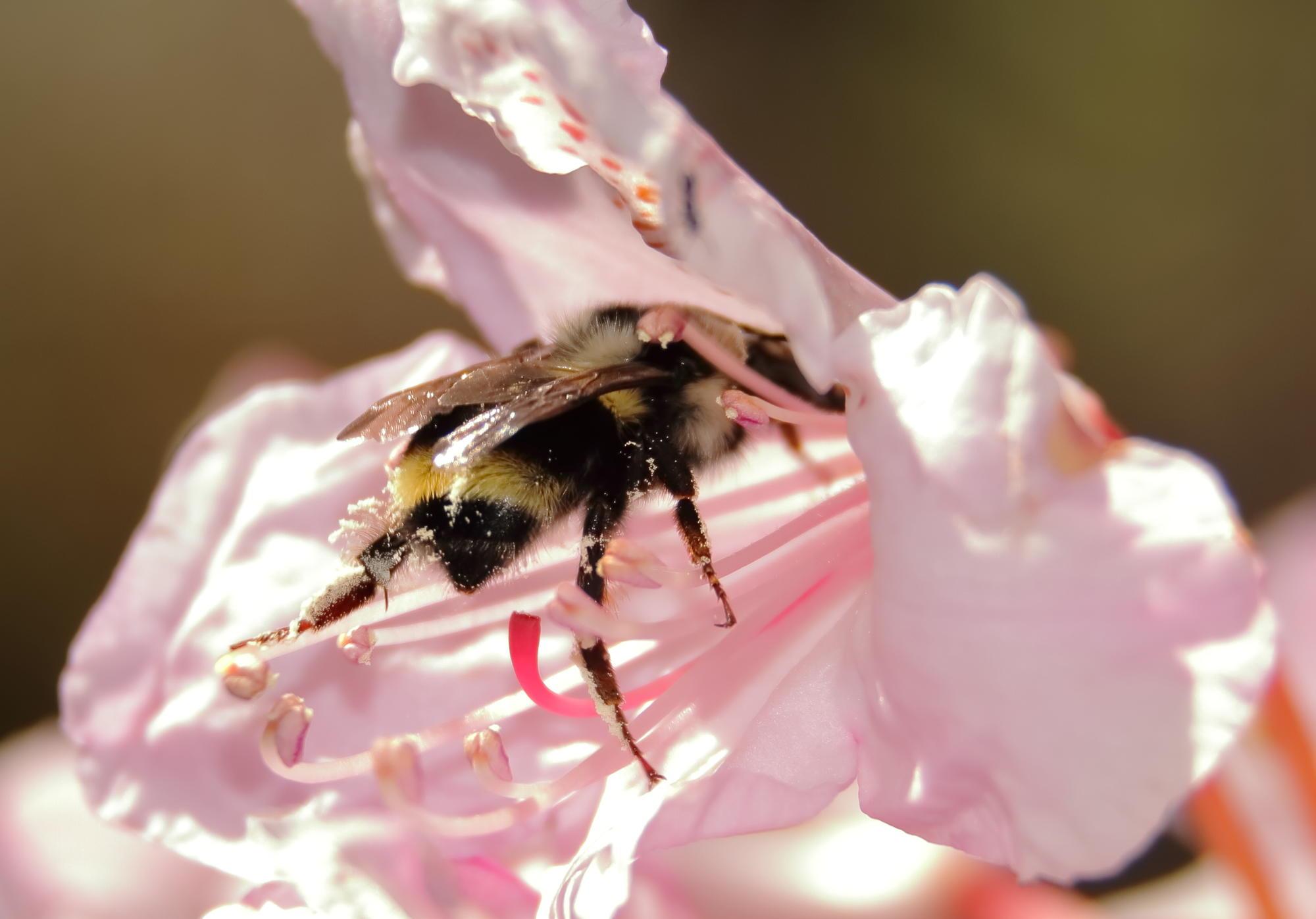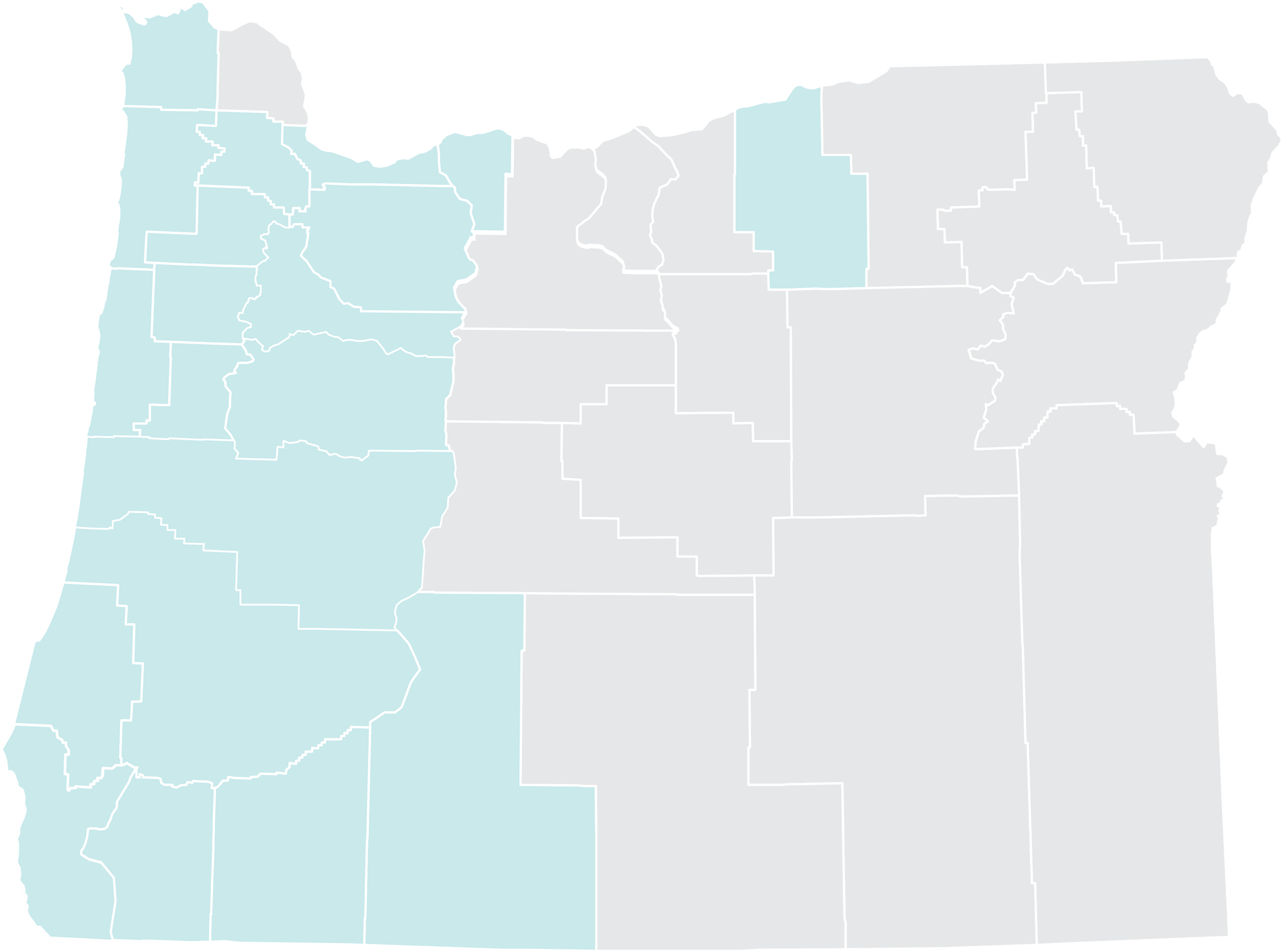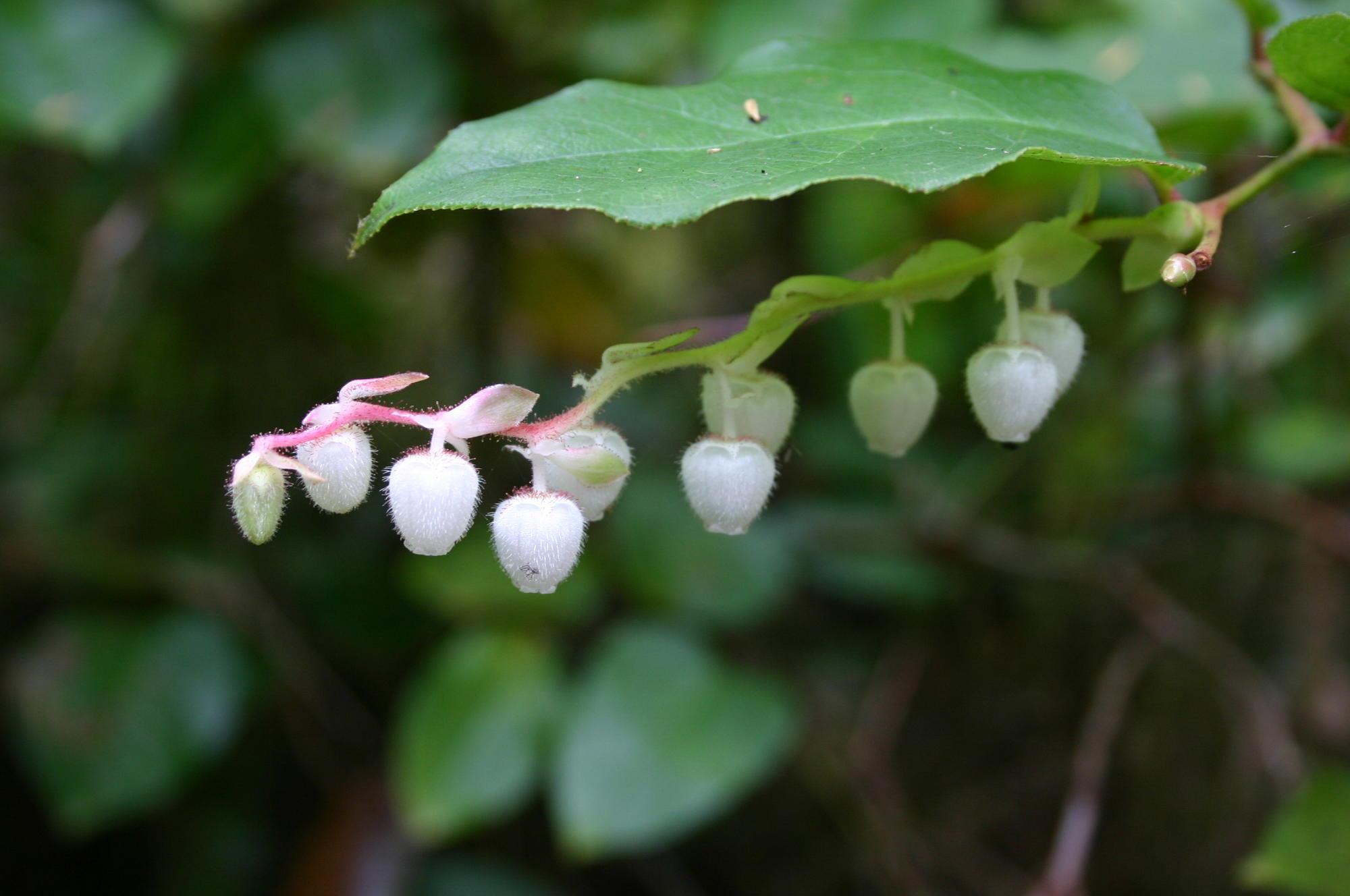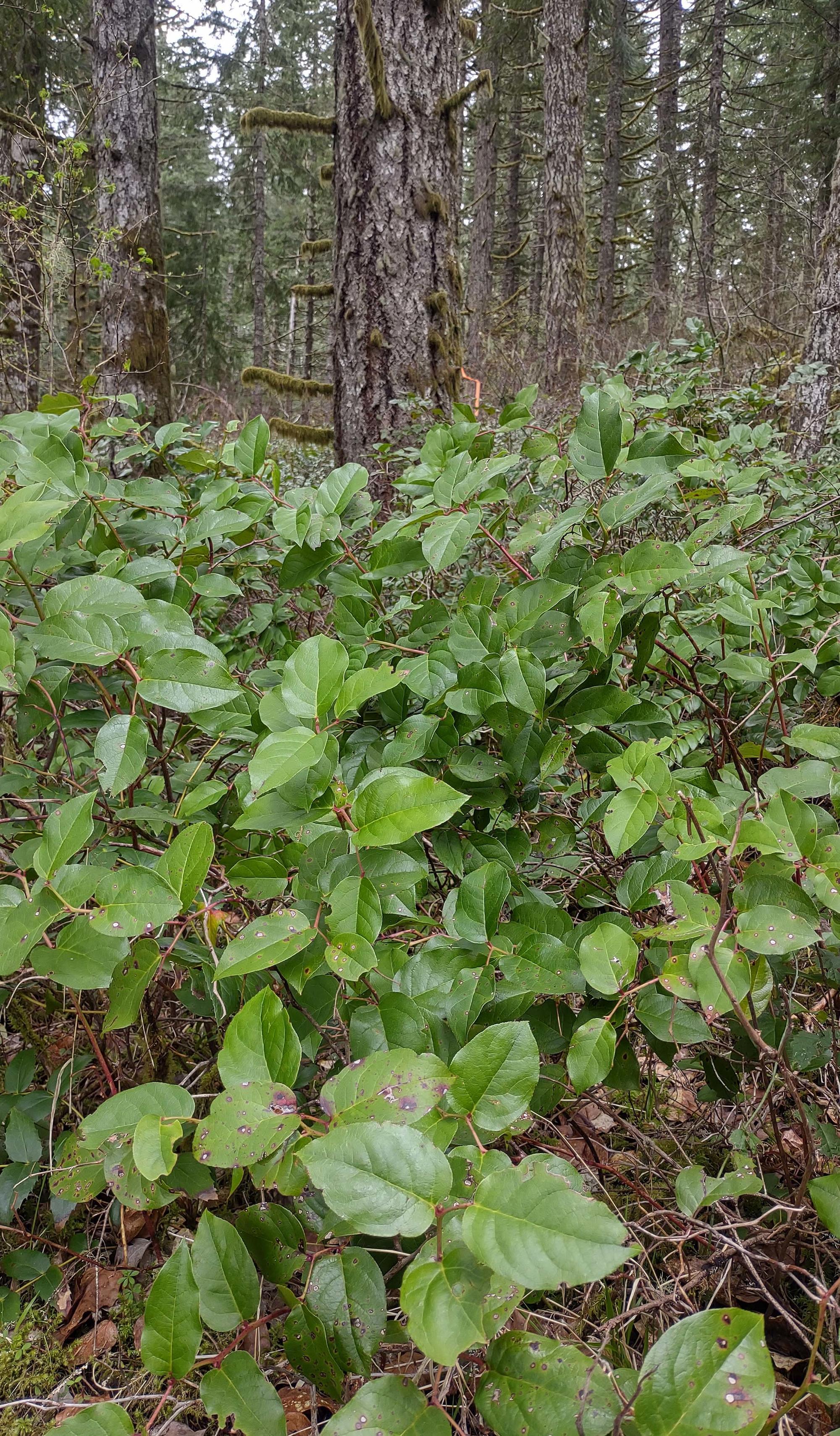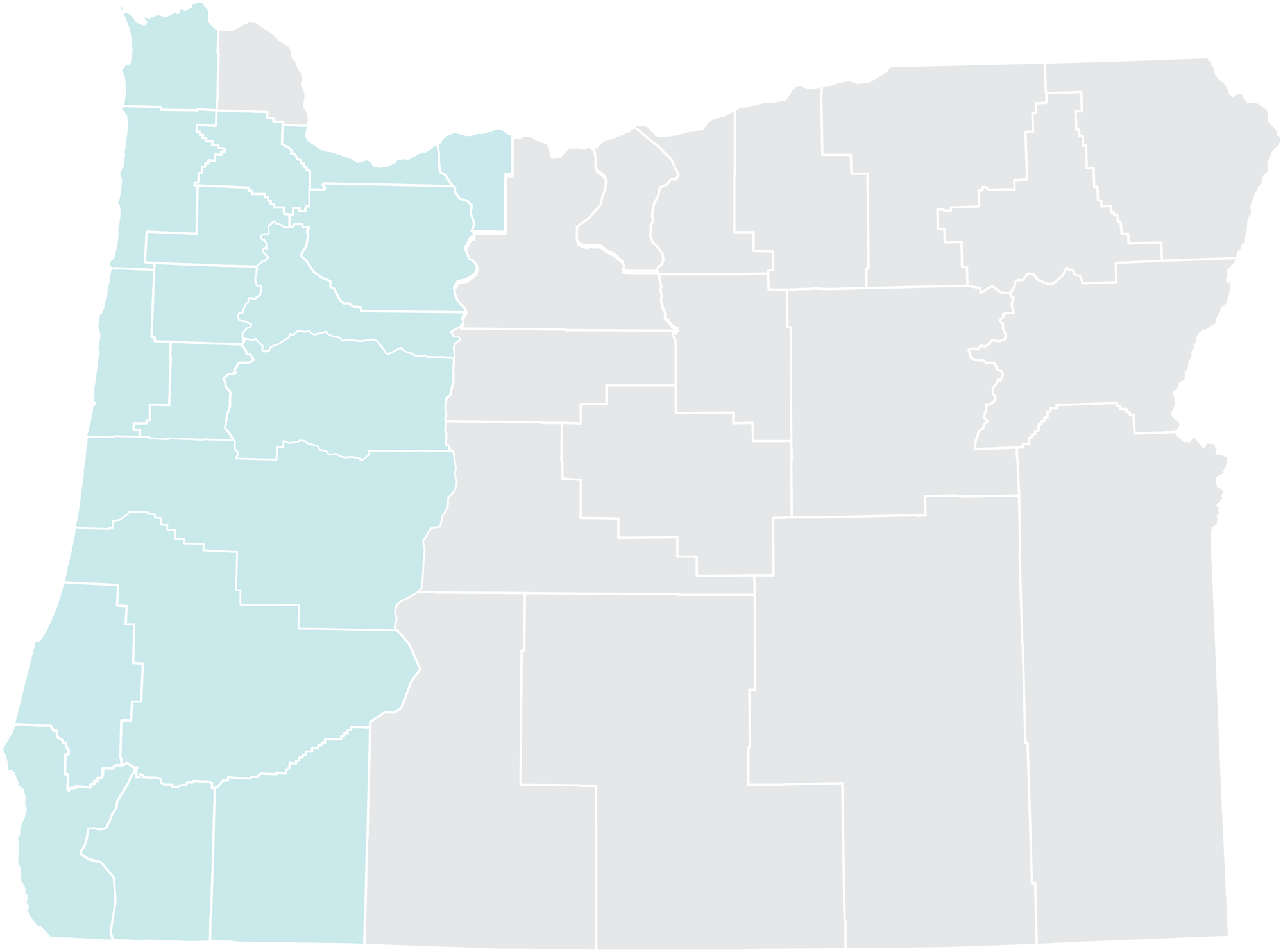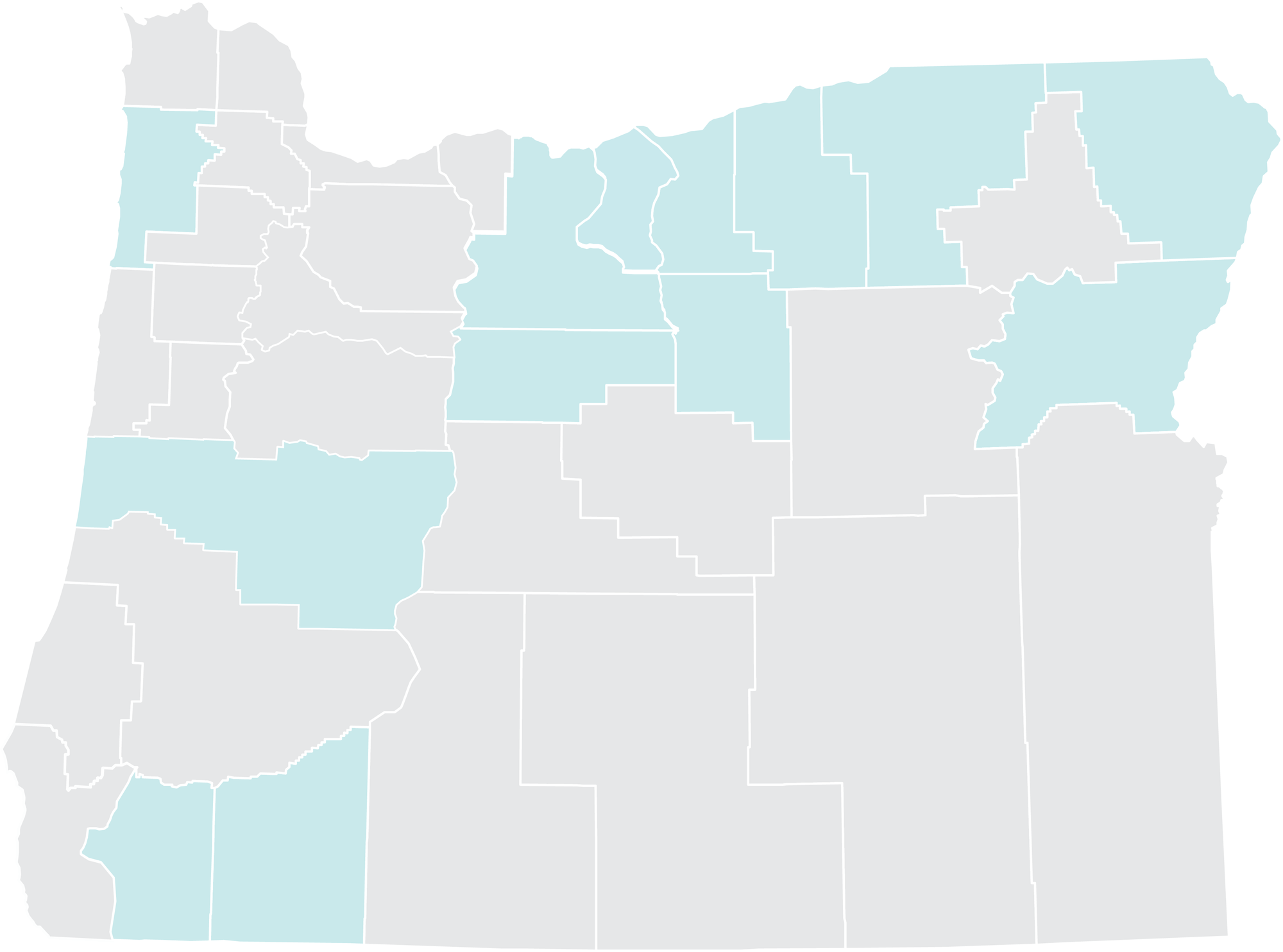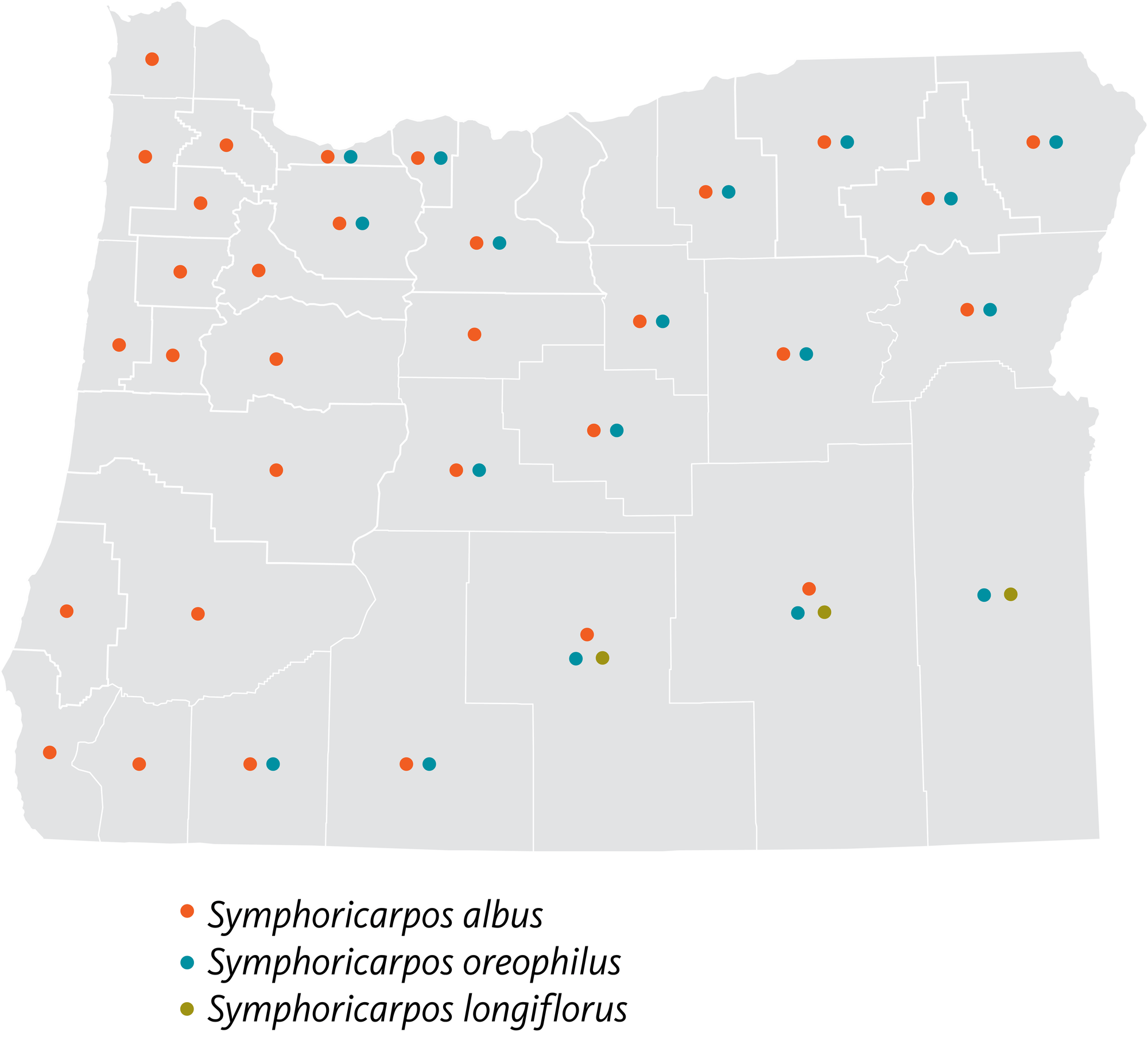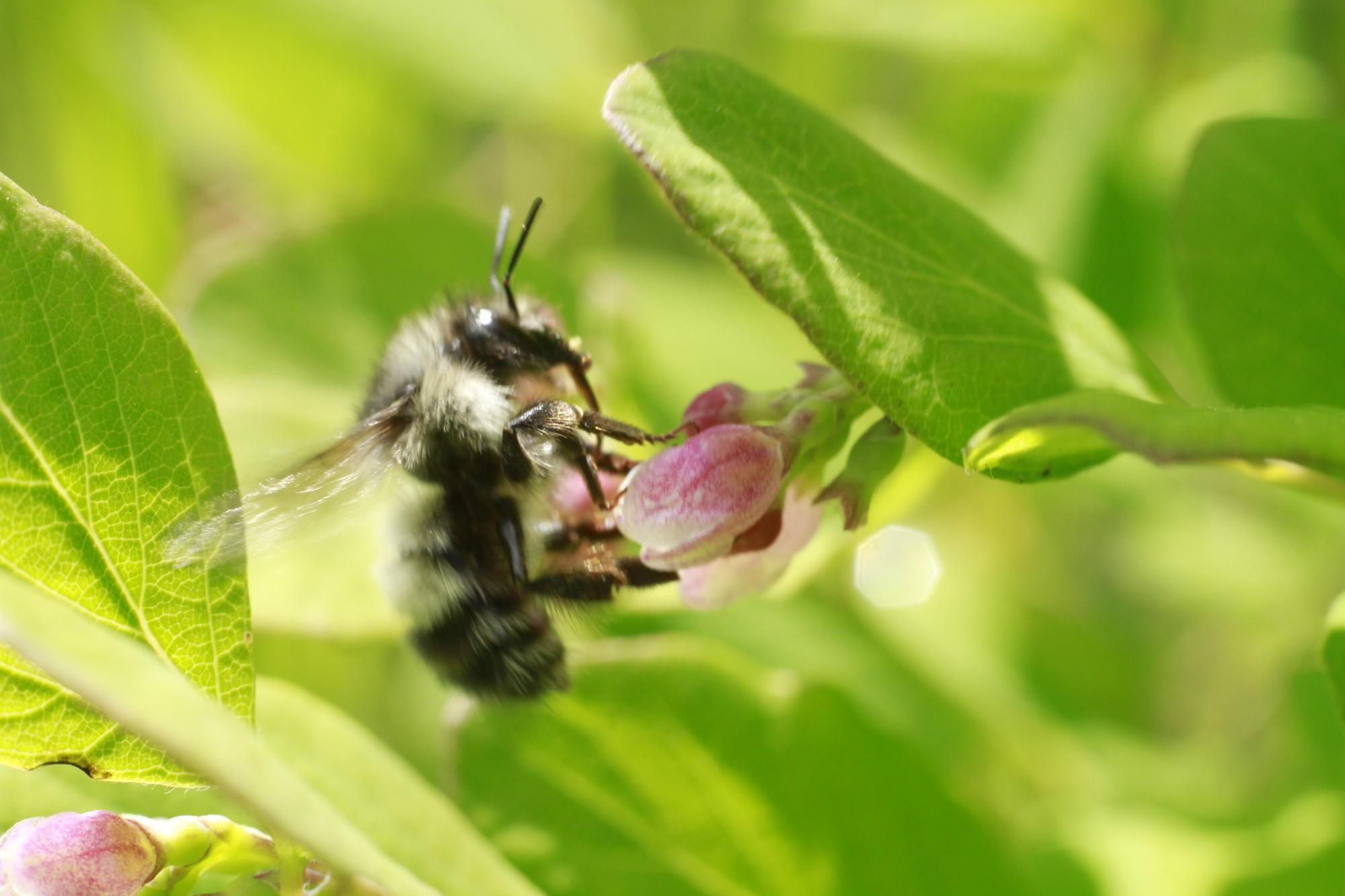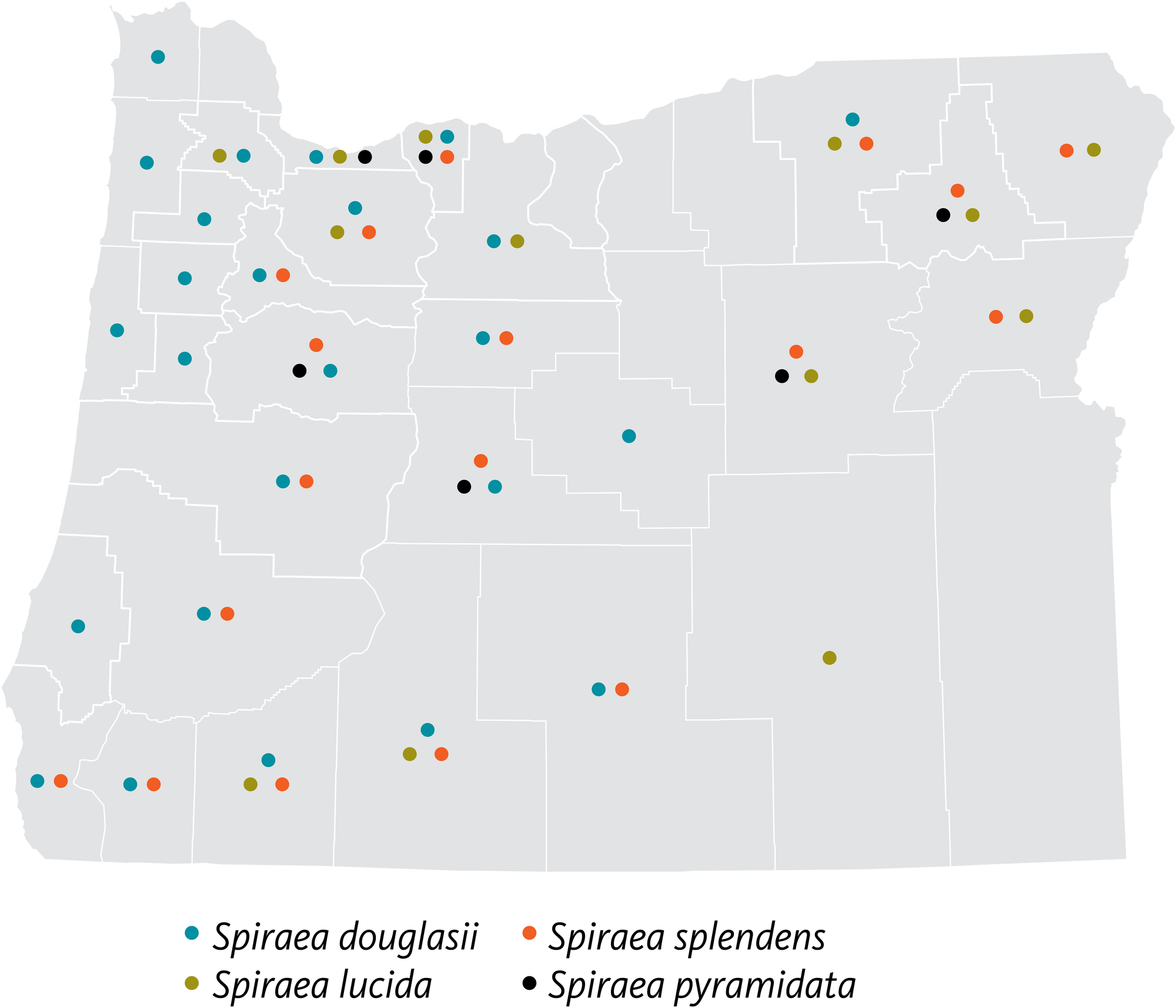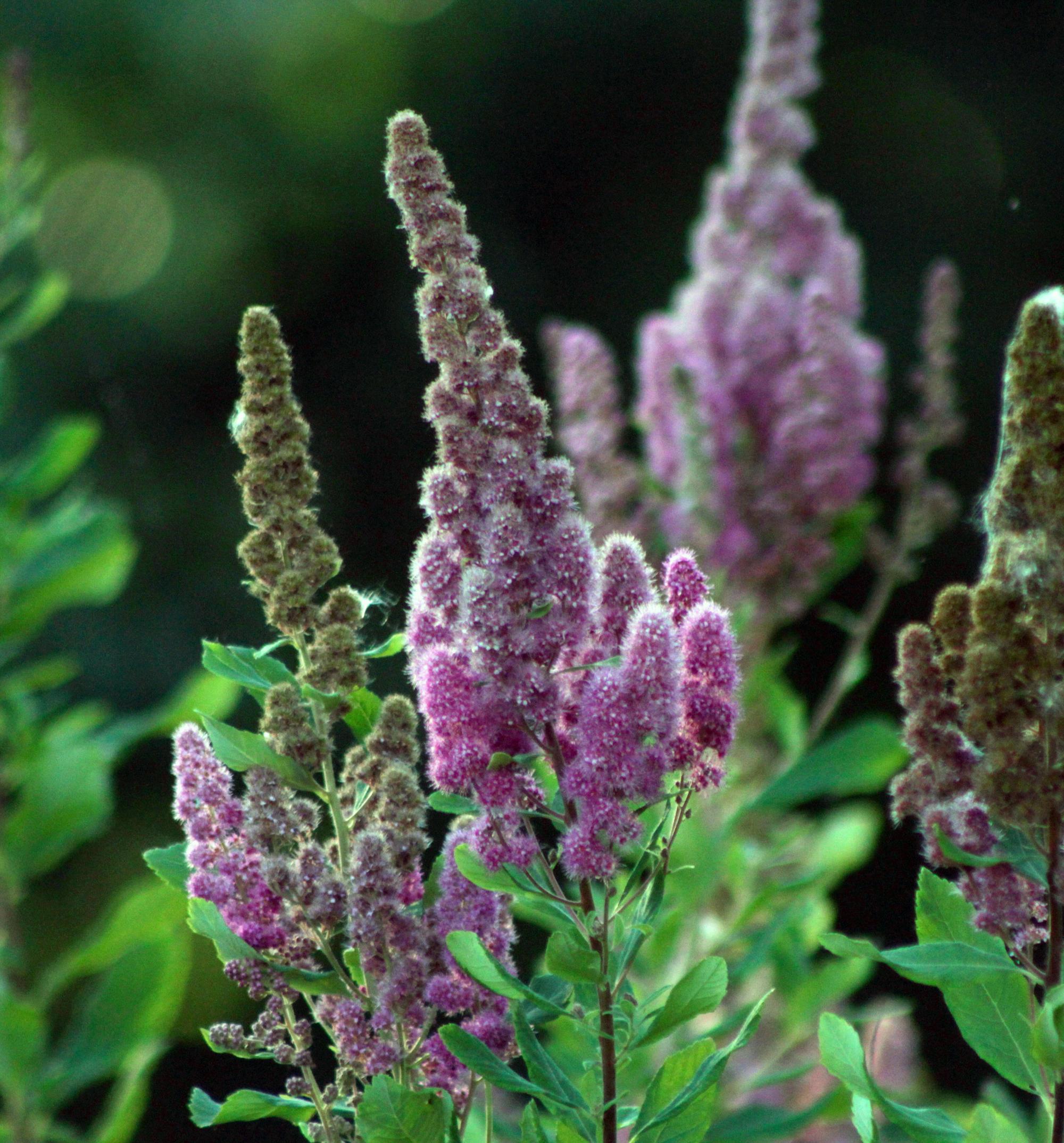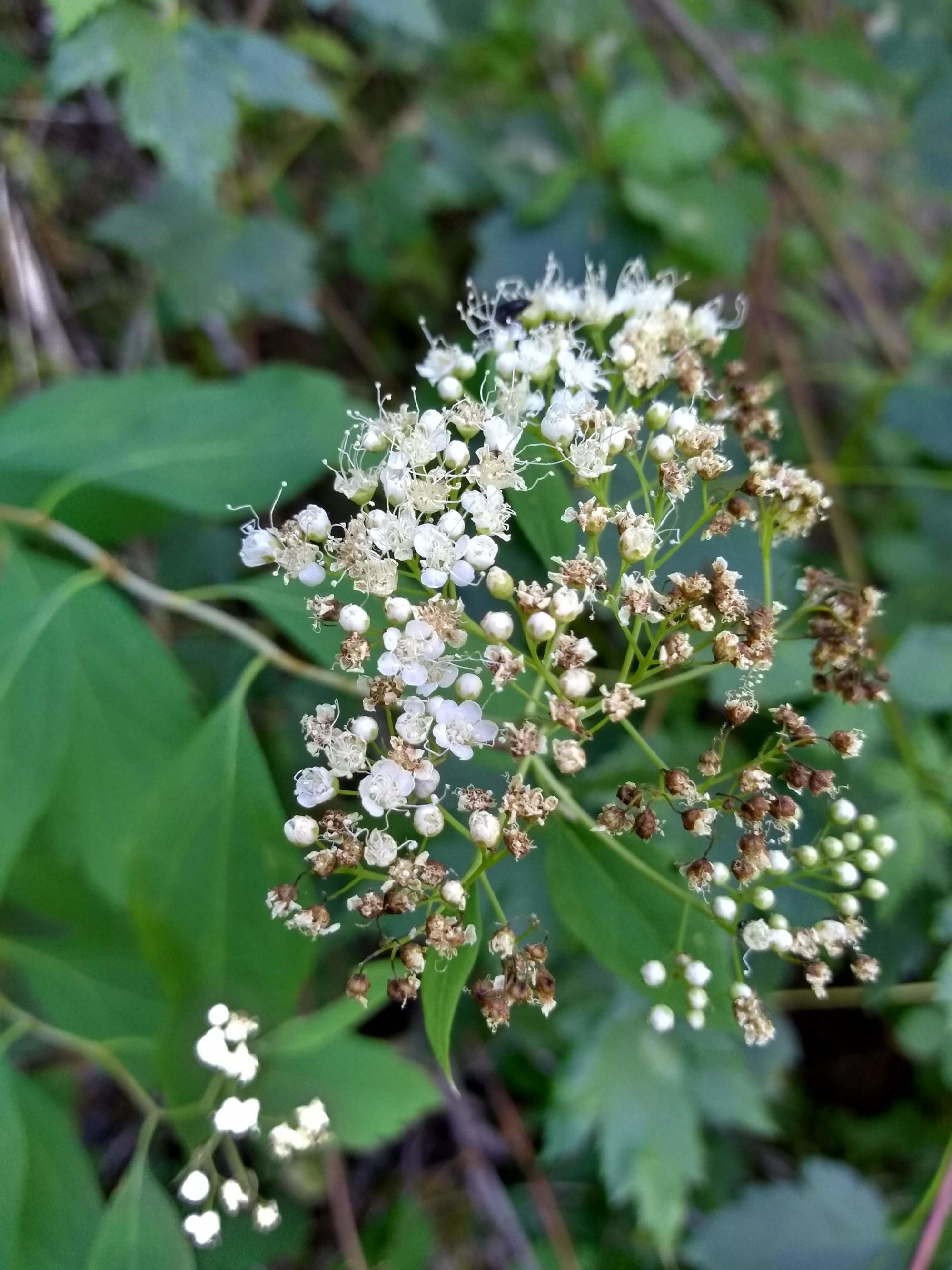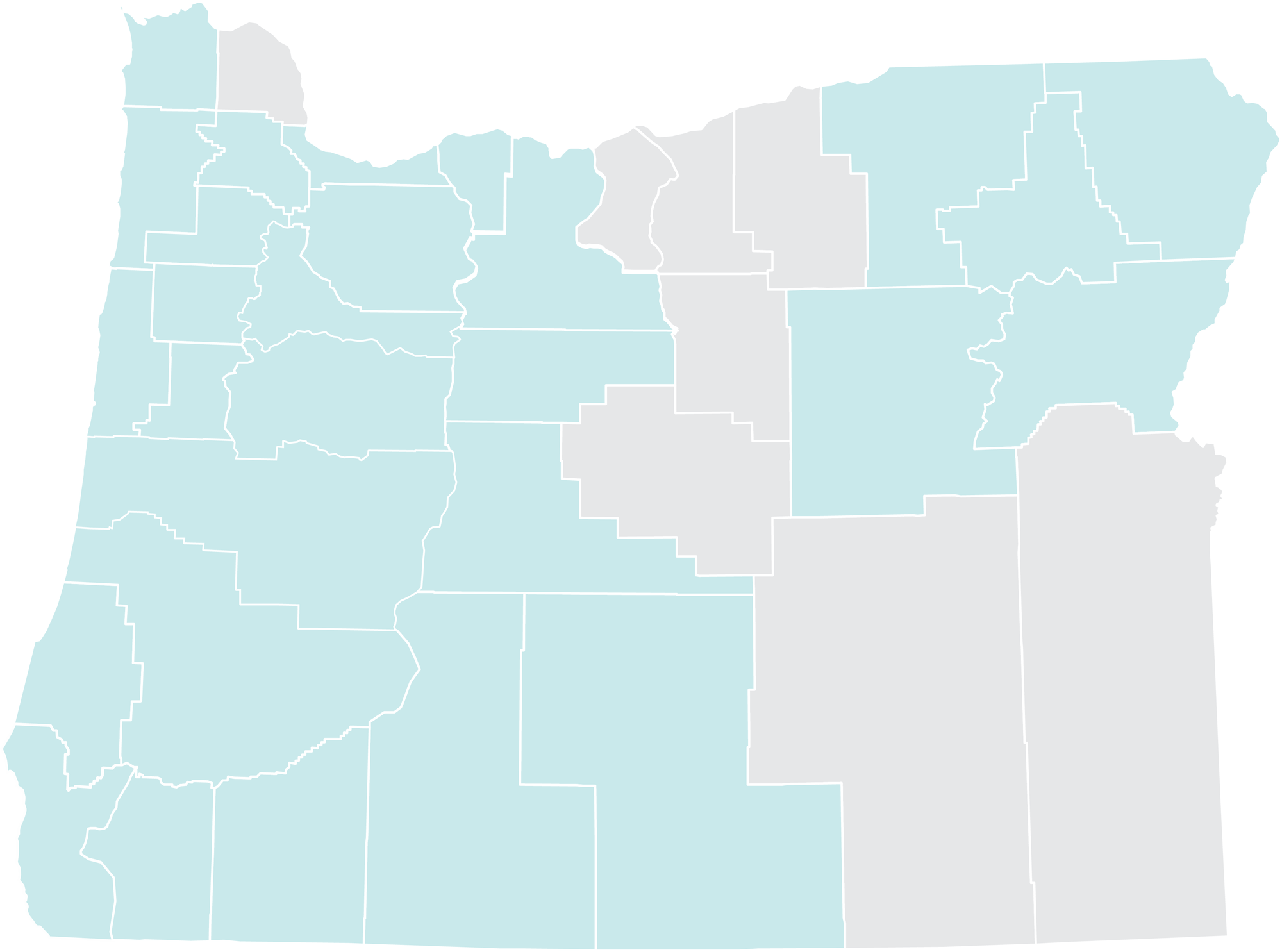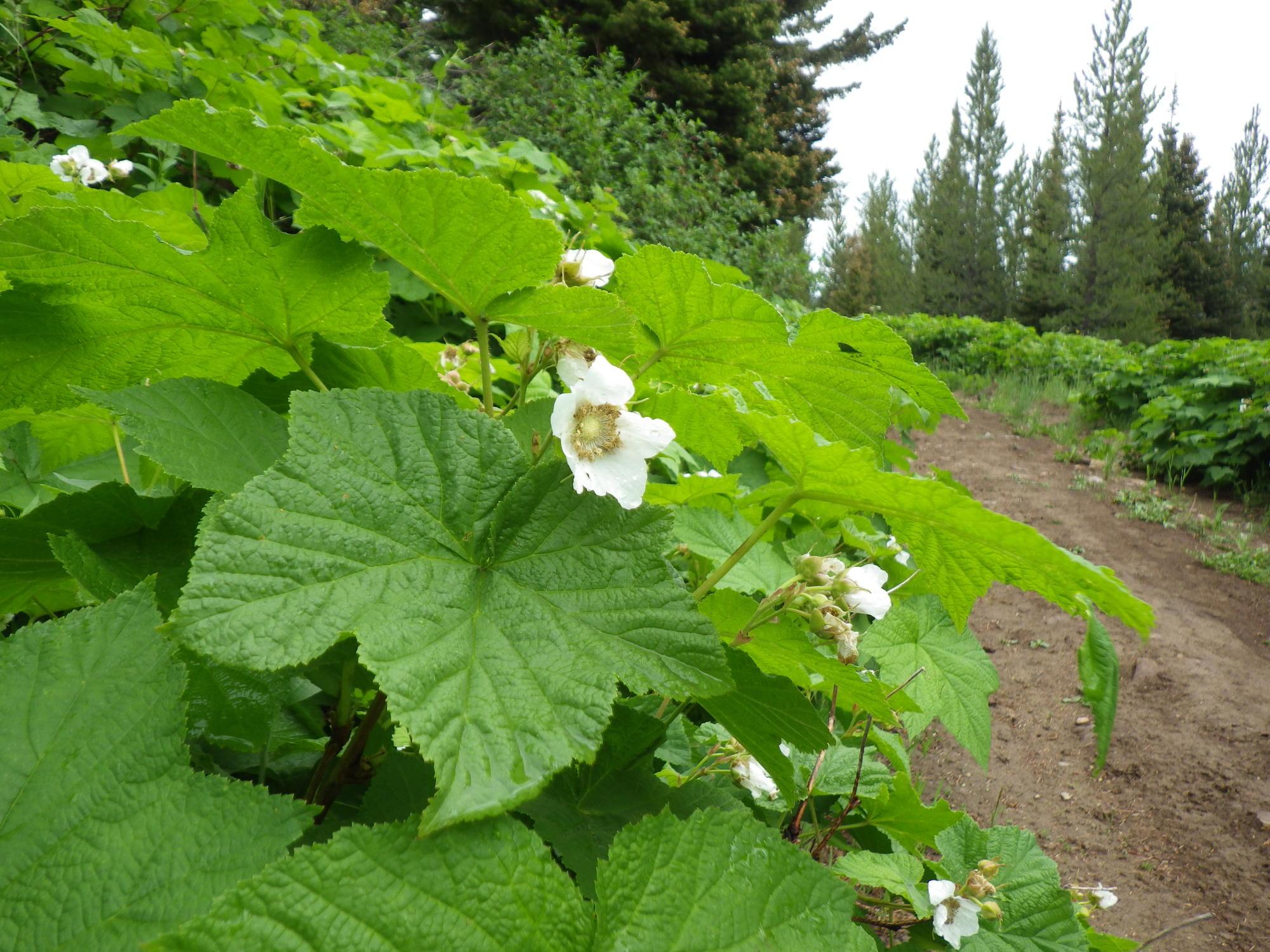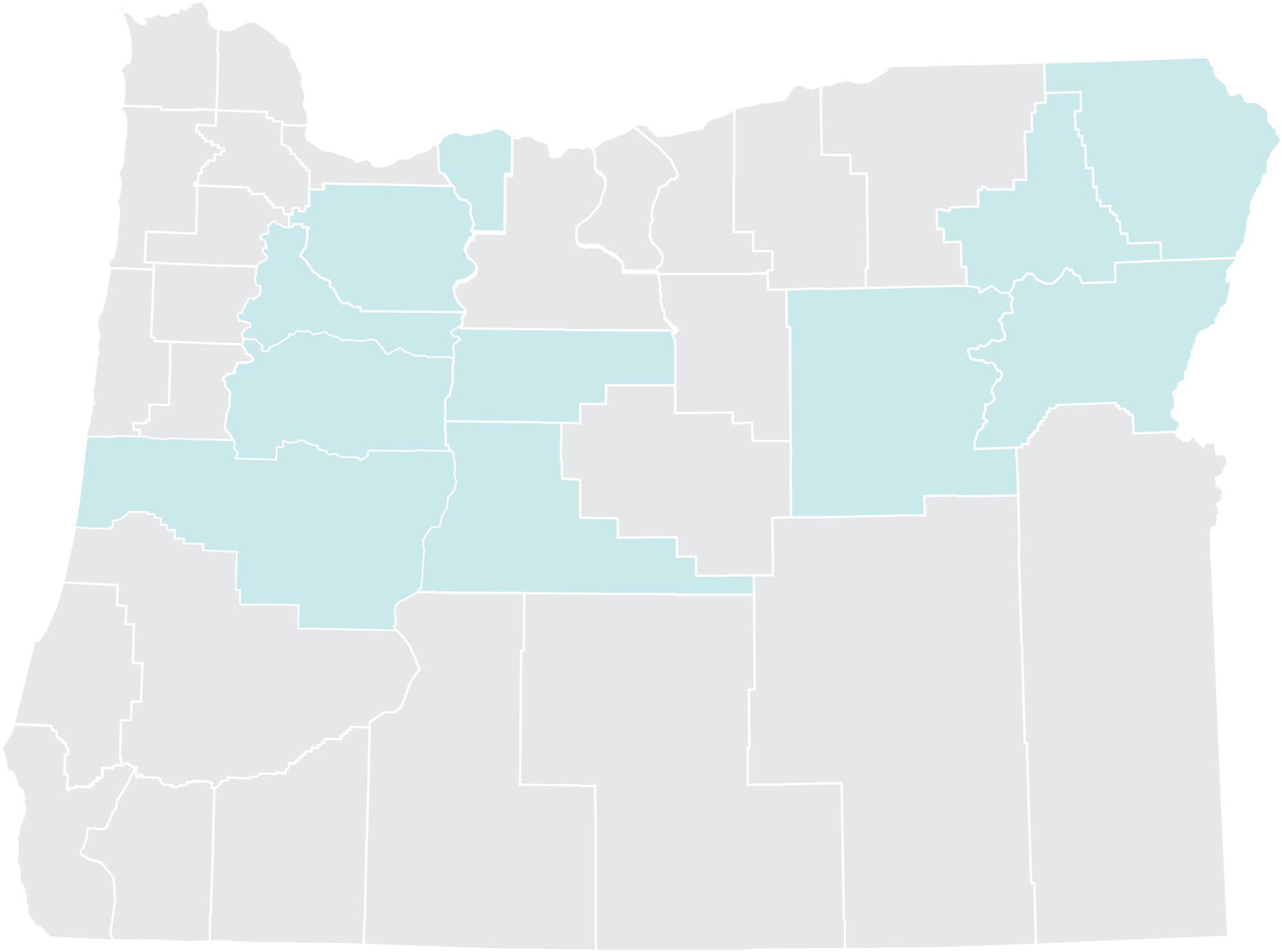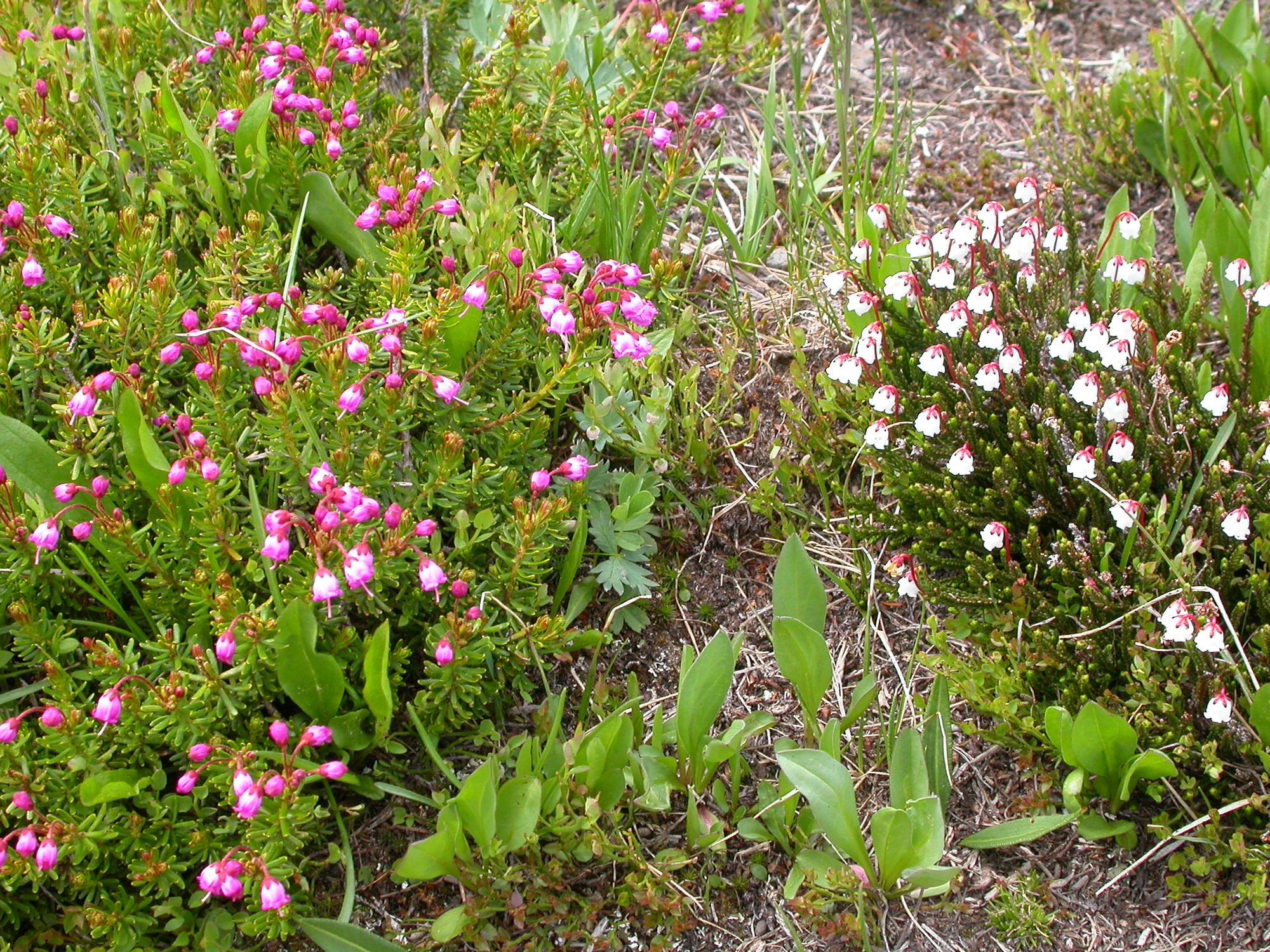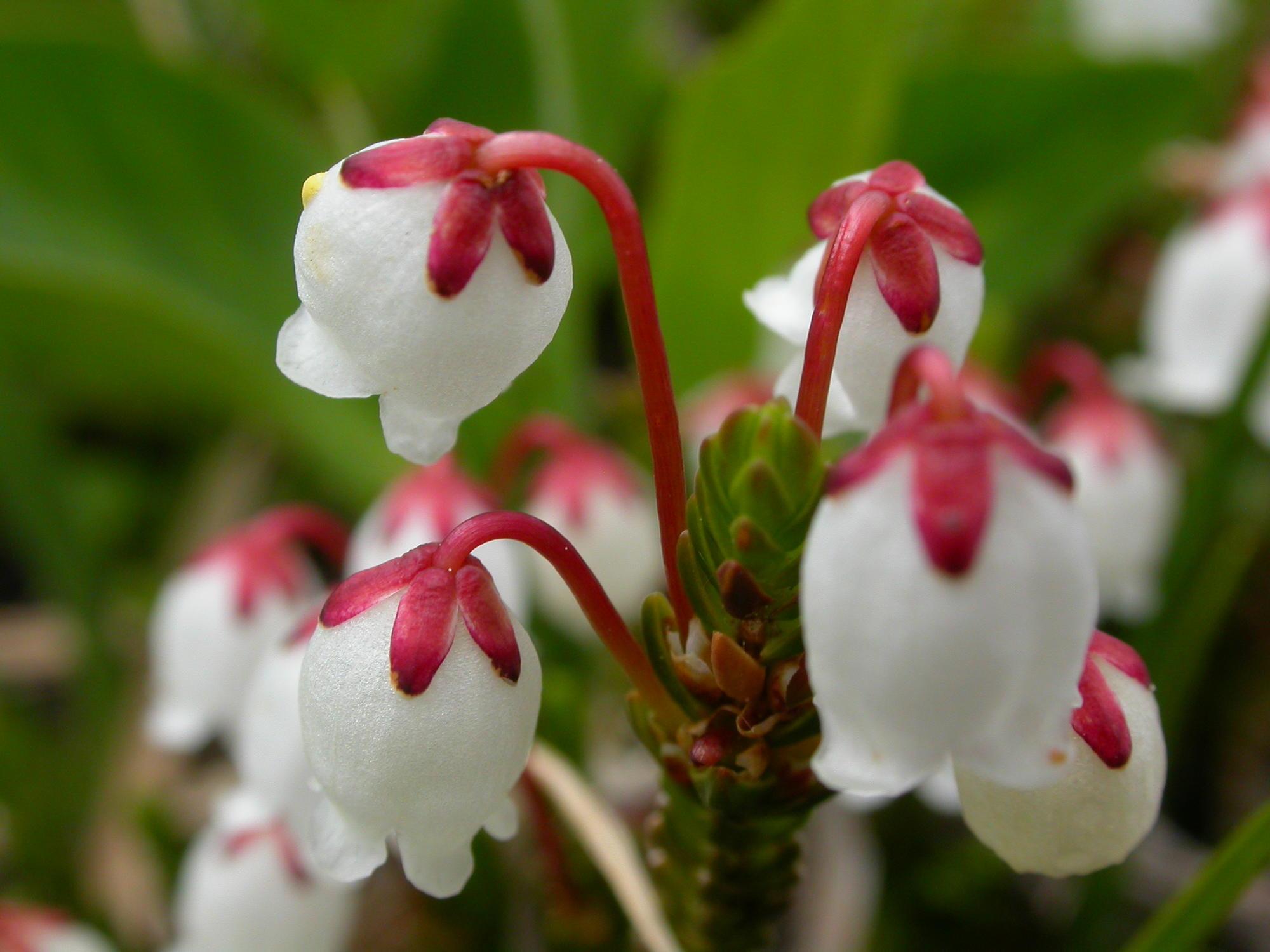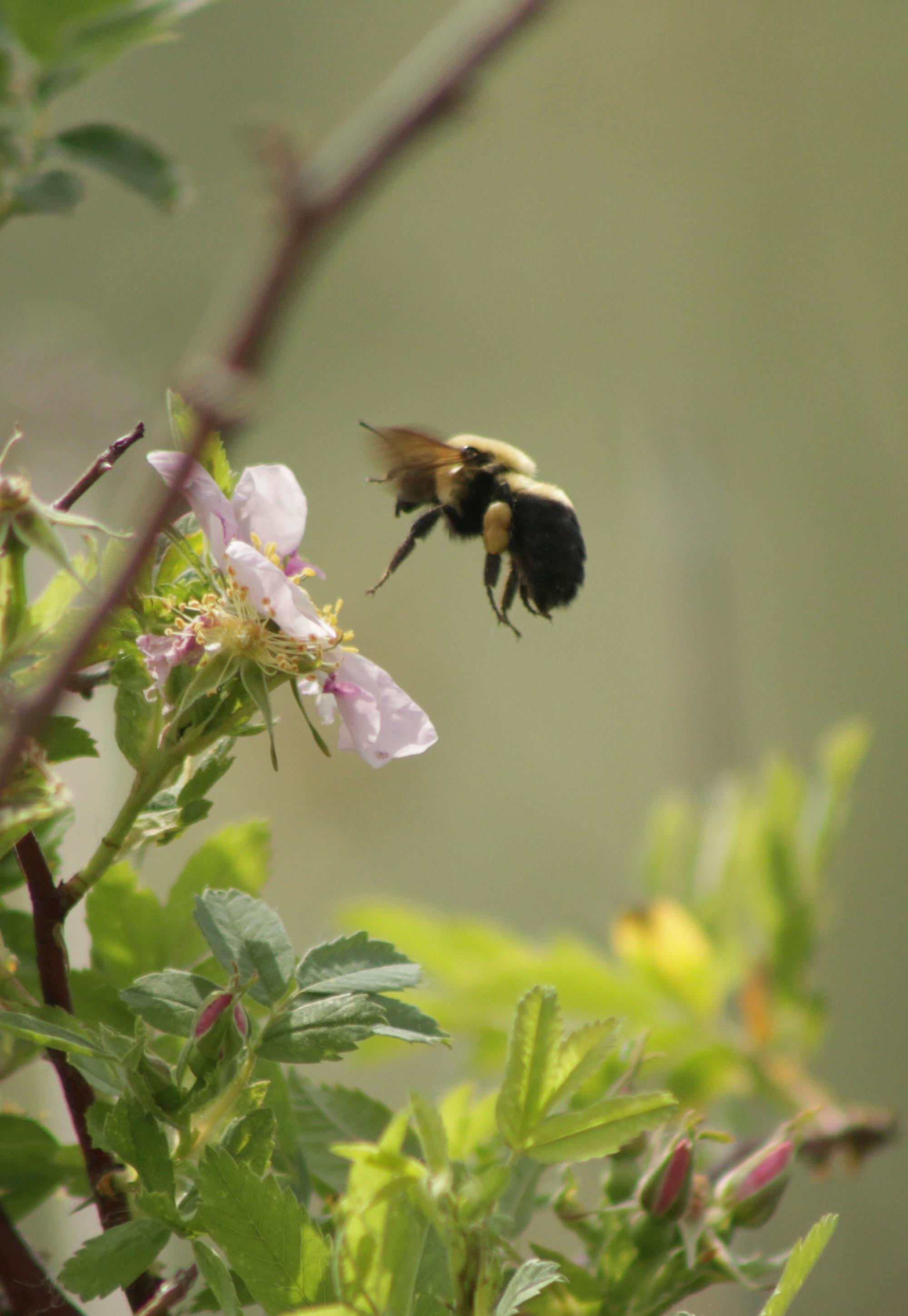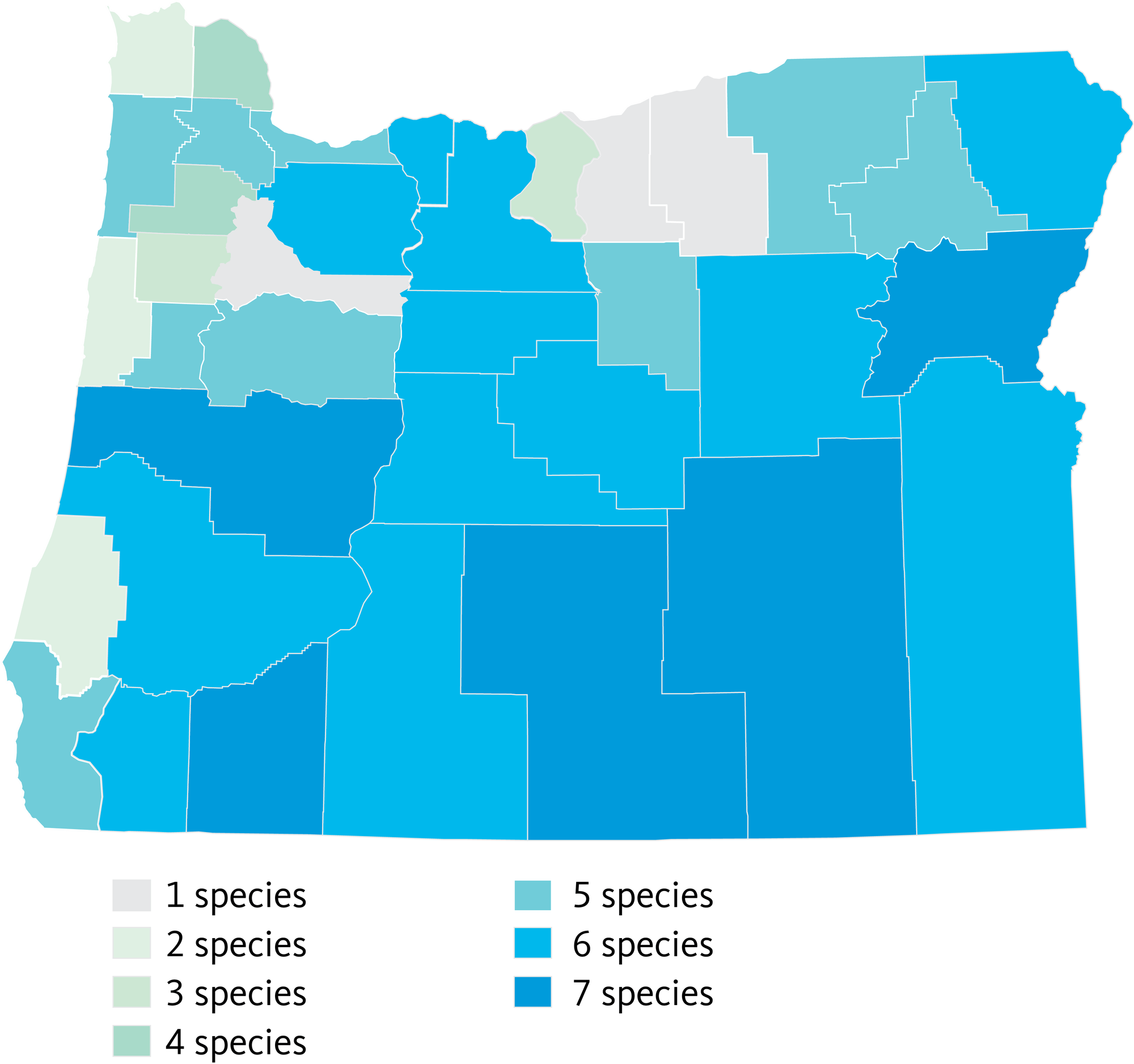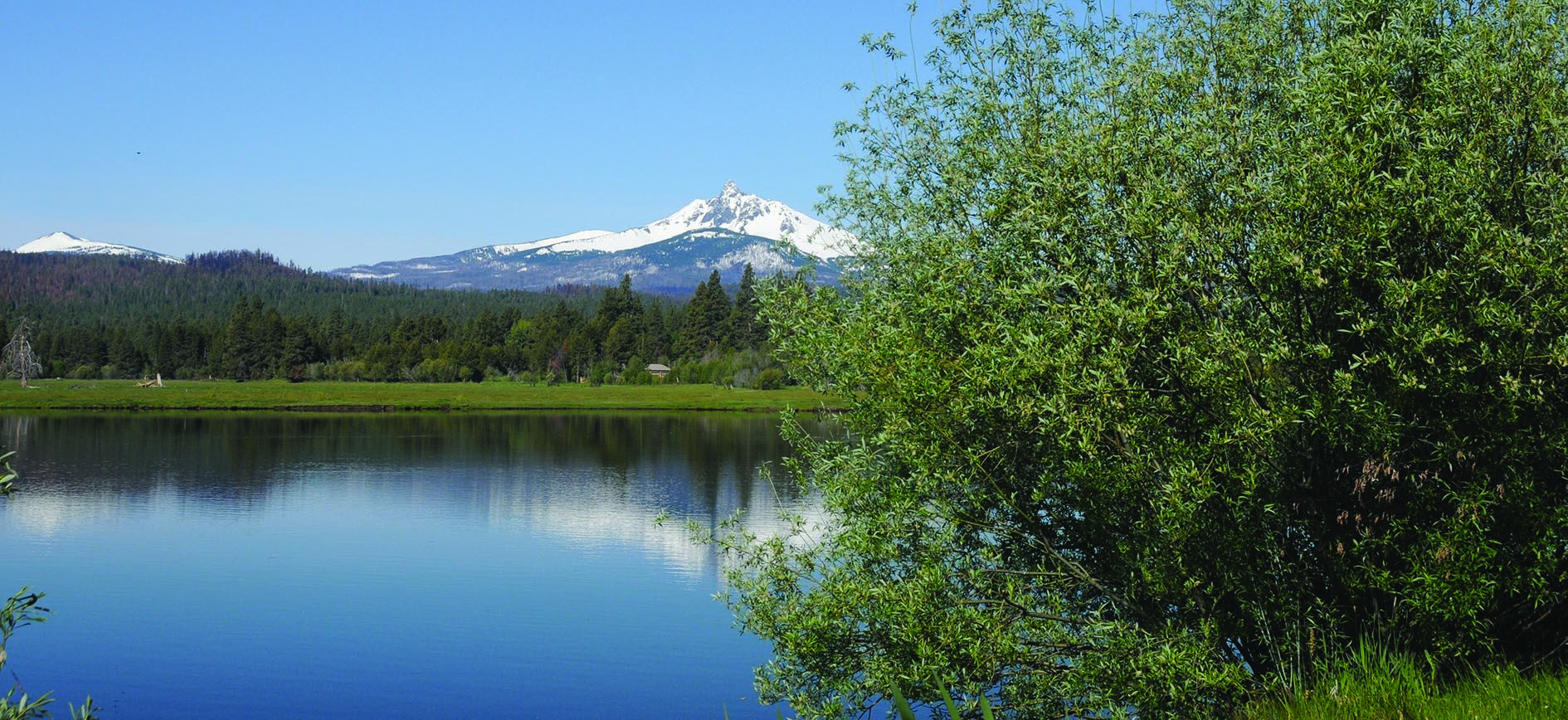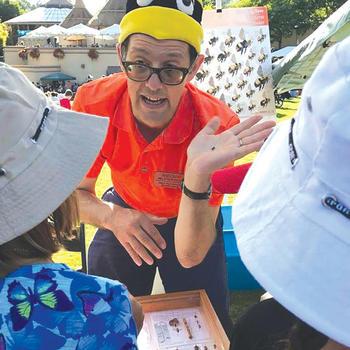Contents
- Introduction
- About this guide
- Why shrubs and trees?
- How to use this guide
- Antelope bitterbrush
- Bigleaf maple
- Ceanothus
- Chokecherry
- Currants
- Dogwoods
- Elderberries
- Hairy manzanita
- Hawthorns
- Huckleberries and related shrubs
- Kinnickinnick
- Labrador teas
- Lewis' mockorange
- Ninebarks
- Oceanspray
- Oregon crab apple
- Oregon grape
- Rabbitbrush
- Raspberries
- Rhododendrons
- Salal
- Salmonberry
- Smooth sumac
- Snowberry
- Spirea
- Thimbleberry
- Western moss heather
- Wild roses
- Willows
- Resources
Introduction
Bee biology and diversity
Bees are a wonderfully diverse group of insects important to the economy and ecology of Oregon. Many people are familiar with European honey bees (Apis mellifera), blue orchard mason bees (Osmia lignaria) and bumble bees (Bombus spp.). These charismatic, well-known species are important pollinators. But they represent a tiny fraction of the roughly 4,000 species documented in North America. Oregon has up to 800 species, including about 25 species of bumble bees. While a handful of these bees are managed and several are non-native, most are wild bees native to the state. (Honey bees are both non-native and managed.)
With such tremendous biodiversity, native bees differ considerably in their life histories. They vary in the plants they visit for food, how they build their nests and in their degree of sociality. One way that bees vary is in their floral preferences. Not all flower species are equally attractive or even accessible to all bee species. Some species visit many different types of flowers. Others forage only on plants within a specific family or genus. With such diversity, it is no surprise that some bee species are ineffective pollinators. For example, some bees can remove resources from a flower without pollinating it. Nevertheless, most bee species contribute to pollination. And when native bee communities are disrupted, seed and fruit production can decline. These effects can ripple into the ecosystem, affecting mammals and birds that depend on fruits and seeds. As beautiful as bee biodiversity is on its own, native bees are important pollinators that facilitate plant reproduction in wildland and agricultural ecosystems.
The pollination process
Pollination, or the transfer of pollen between flowers of the same species, occurs in nearly every terrestrial ecosystem on Earth. Much of our world’s flowering plant diversity relies on insects for pollination. In most ecosystems, bees are among the most important pollinating insects.
Pollination occurs because bees seek resources from flowers to provide energy and protein. They use nectar, pollen (and rarely floral oil) for themselves and their developing young. When a bee visits a flower and collects these resources, pollen sticks to her body and some likely transfers to the next flower she visits. While these visits do not always result in pollination, repeated visits from many bees help guarantee that blooms get pollinated. Once a flower is pollinated, the plant can start producing seeds or fruit.
Pollinator declines
Unfortunately, habitat destruction, climate change, pesticides and disease all threaten bees. Scientists have observed population declines in many native species. Some Oregon bee species have experienced sharp reductions in range and abundance. These include the western bumble bee, Bombus occidentalis, and Franklin’s bumble bee, Bombus franklini. Franklin’s bumble bee is listed under the Endangered Species Act.
Habitat restoration for bees
In recent years, interest in habitat restoration and enhancement for native bees has skyrocketed. In Oregon, projects range in size from pollinator gardens in urban yards to large-scale ecosystem restoration. Yet, when habitat enhancement and restoration efforts omit key plant species, some bees that rely on those plants may be left out. Carefully consider which plants to include in a habitat restoration or enhancement project to ensure you meet your goals.
Planting key plants for Oregon bees may be one way to improve habitat and help these species recover. Even though we have much to learn about many native bee species, increasing the number and diversity of flowering plants that support bees can boost the health of native pollinators. Since bee needs can vary from species to species, encourage pollinators by planting a wide variety of plants with abundant blooms. These strategies can also benefit commercially managed bee species in Oregon, like honey bees and blue orchard bees. Enriching floral landscapes can beautify gardens and reveal the fantastically diverse world of Oregon bees.
About this guide
This guide is designed to walk readers through the flowering trees and shrubs of Oregon. This information may help people across our state’s diverse biomes choose native shrubs and trees for pollinator habitat. This guide should help landowners promote native-bee-friendly landscapes on their property. While all of the shrubs and trees covered are native to Oregon, many may occur outside of the state. These are likely useful as pollinator plants elsewhere — especially in other parts of the Pacific Northwest.
This guide briefly profiles 29 different types or “taxa” of shrubs and trees that are useful to bees. All data were compiled from the Department of Agriculture Natural Resources Conservation Service Plants Database and various field guides (see “Resources”). For more specific information on the shrubs and trees, the guide links each species to Oregon Flora. This database contains more detailed maps, information on gardening with native plants, general traits and a list of links to other sources on each plant. For more information, see “Resources.”
Why shrubs and trees?
Long-lived and hardy
Shrubs and trees can live for a long time, with some species lasting decades. Many species are also resilient once established, can tolerate varied environmental conditions, and are less vulnerable to competition from weeds and grasses. Selecting appropriate shrubs and trees for your site will help your plants survive for many years. For example, antelope bitterbrush is a great choice for dry areas that frequently experience drought.
Shrubs have distinct advantages over shorter-lived annual or perennial forbs. Although shrubs can be more expensive than forbs, they are easier to establish and will continue to bloom for many consecutive seasons.
You can save money by propagating some shrubs from plant cuttings. You can plant cuttings of spirea and willows, for example, directly in the ground.
Visited by many bee species
Many shrubs and trees are visited by a wide variety of bee species, and some even appear to support specialist bee species. One eastern Oregon study found 80 species of bees visiting local native shrubs. Even species rare to the region were attracted to the native shrubs.
Useful as forage and nests
Native bees use trees and shrubs in many ways. Many bee species visit shrubs and trees to forage for nectar, pollen or floral oils. And some bees will use the hollow or pithy stems of shrubs like elderberry, raspberry and spirea to create nests. Other bee species will cut off small portions of shrub leaves to line their nests.
Produce delicious food and fruits
Some native shrubs and trees produce delicious fruits and berries. So, on top of providing forage resources to bees, they can provide forage resources for you! Native shrubs like huckleberries, certain currants, raspberries, thimbleberries and others produce edible fruit. You can tap bigleaf maple to extract sap for maple syrup production. You can also make cider from crab apples or use them as a pectin source when preserving other types of fruit.
Provide resources to other wildlife
Shrubs and trees can provide resources to other wildlife. Elk and deer browse foliage of both shrubs and trees. Squirrels and birds may eat berries or seeds produced by shrubs and trees. And birds or small mammals may take shelter and nest in the cavities of trees or in the branches of trees and shrubs. Even salmon, trout and other cold-water fish benefit from shrubs and trees. These plants stabilize river and stream banks and keep water cool by shading streams.
How to use this guide
This guide covers basic information on major shrubs and trees in Oregon. Learn what you need to consider when selecting appropriate plants, including details about the plant’s needs and considerations for pollinators. Maps show where the plants are found in nature. For single species, maps display the presence (green) or absence (gray) by county. In cases where multiple species occur, the map key shows either which species occurs in which county, or the number of species per county. (This improves map readability for taxa that have many species.) We used county-level information from the USDA NRCS Plants Database to inform the maps. Given the relative rarity and the patchy distribution of some trees and shrubs, a species may occur in a county where it is shown as “absent” in this guide.
Before going to the expense of buying new plants, survey your property for the shrubs in this manual. If you are a small-woodland owner, a park manager, a golf course superintendent or even a homeowner, many of these shrubs may already be growing on your property. You may be able to use existing shrubs or trees to propagate new plants.
Shrubs can be expensive and difficult to obtain. Match shrubs to key site characteristics and invest in their successful establishment. Use this guide together with the following resources to ensure proper site preparation and planting techniques:
- Hedgerow Planting (422) for Pollinators: Western Oregon and Washington.
- Oregon Flora's resources on gardening with native plants.
Weed control is a critical first step. Take steps to control weeds the year before you plant. You may need to use herbicides at sites with heavy weed pressure. If you have applied herbicides, make sure they have sufficiently degraded prior to planting to avoid damage to new shrubs. Or, plant shrubs into holes cut through weed fabric. This approach does not require the use of herbicides, although it can be more expensive. Another approach for weedy sites combines mowing and mulching. Mow weeds down, then cover the ground in a thick layer of mulch, about 5 to 6 inches deep. Plant shrubs into holes dug through the mulch into the underlying soil.
Make sure to give shrubs enough room to grow by spacing them far enough apart to accommodate their size at maturity. Some shrubs, such as willow, may require more spacing. Transplant potted shrubs or whips in fall. Nurseries and Soil and Water Conservation districts typically offer inexpensive bareroot plants in late winter.
Irrigate newly planted shrubs throughout their first year. Use long, deep watering to encourage root growth. For most native plants planted in appropriate sites, irrigation will not be necessary beyond the establishment year.
Antelope bitterbrush
Purshia tridentata
Pollinator notes and other characteristics: Documented bee visitors include mining bees (Andrena), mason bees (Osmia), green metallic bees (Agapostemon) and others. Antelope bitterbrush is an important floral resource in arid parts of the state where other blooming shrubs may not grow well. Eaten by large game (deer and elk) and livestock. Grows up to 10 feet tall. Prefers coarse or medium soils.
Shade tolerance: Intermediate
Drought tolerance: Tolerant
Bloom period: April–July
USDA hardiness zones: 3a–9a
Bigleaf maple
Acer macrophyllum
Pollinator notes and other characteristics: Visiting bees include mining bees (Andrena), mason bees (Osmia), bumble bees (Bombus) and honey bees (Apis mellifera). Early blooms can be an important resource for bees in spring when few flowers have bloomed. Rapid growth — up to 30 feet in the first 20 years. Will grow to 100 feet tall. Common in western Oregon. Tolerant of varied soils. Not fire resistant. Wood used for fuel and timber. Trees can be tapped for sap, which some people use to make maple syrup. Intermediate flood tolerance.
Shade tolerance: Intermediate
Drought tolerance: Not drought tolerant
Bloom period: April–May
USDA hardiness zones: 5–10b
Ceanothus
Ceanothus spp.
Pollinator notes and other characteristics: Supports a high diversity of native bees and butterflies. Most species grow to about 10 feet tall. Many bee species associated (more than 50 documented species). Other pollinators like hoverflies, wasps and butterflies are also often seen on most ceanothus species. The map shows seven species common in Oregon according to the number of species per county: whitethorn ceanothus (Ceanothus cordulatus), deerbrush (C. integerrimus), redstem ceanothus (C. sanguineus), prostrate ceanothus (C. prostratus), blueblossom (C. thyrsiflorus), snowbrush ceanothus (C. velutinus) and buckbrush (C. cuneatus).
Shade tolerance: Most species not shade tolerant
Drought tolerance: Most species drought tolerant
Bloom period: April–June (varies by species and location)
USDA hardiness zones: 5b–10b (depending on the species)
Chokecherry
Prunus virginiana
Pollinator notes and other characteristics: Supports high diversity of bees. (More than 60 species have been documented as visitors.) The large clusters of blooms can provide immense amounts of floral resources to bees. Grows to maximum 25 feet tall. Leaves and bark can be toxic to cattle, sheep and humans, but wildlife will consume fruits. Tolerant of varied soils.
Shade tolerance: Not tolerant
Drought tolerance: Medium
Bloom period: April–May
USDA hardiness zones: 2–10a
Currants
Ribes spp.
Pollinator notes and other characteristics: Currants are visited by diverse species including bumble bees (Bombus sp.), digger bees (Anthophora sp.), mining bees (Osmia sp.) and many others. The map shows three common Oregon species: golden currant (Ribes aureum), wax currant (R. cereum) and redflower currant (R. sanguineum). Currants — and in particular, wax currant — may be resistant to deer and elk browsing once established. Maximum mature height is about 10 feet. All do best in medium-textured soils. All produce edible berries, though wax currant berries are seedy and not considered palatable.
Shade tolerance: Intermediate
Drought tolerance: Tolerant, especially wax currant
Bloom period:
- Golden currant: April–May
- Wax currant: May–July
- Red-flower currant: April–June
USDA hardiness zones:
- Golden currant: 3–10b
- Wax currant: 5b–9a
- Redflower currant: 6–10b
Dogwoods
Cornus spp.
Pollinator notes and other characteristics: In eastern Oregon, the western bumble bee (B. occidentalis), a rare and potentially threatened species, has been observed visiting red-osier dogwood (Cornus sericea). Many other bee species visit both red-osier and Pacific dogwood. Maximum height: Pacific dogwood (C. nuttallii) to 40 feet and red-osier dogwood to 9 feet. Berries used by wildlife. Both visited by insects, but red-osier dogwood potentially more so.
Shade tolerance: Intermediate
Drought tolerance: Not drought tolerant, especially Pacific dogwood
Bloom period:
- Red-osier dogwood: June–August
- Pacific dogwood: April–May
USDA hardiness zones:
- Red-osier dogwood: 2–10b
- Pacific dogwood: 7b–9b
Elderberries
Sambucus spp.
Pollinator notes and other characteristics: The map shows two common species: black elderberry (Sambucus nigra) and red elderberry (S. racemosa). Both species commonly have dead, hollow twigs used by stem-nesting bees as a nesting resource. Early to mid-spring blooms on black elderberry can be important for early emerging bees. Wildlife eat the berries. Mature height is about 20 feet. Berries from black elderberry are edible. Grows best in medium to course soils.
Shade tolerance: Intermediate
Drought tolerance: Tolerant, especially black elderberry
Bloom period:
- Black elderberry: March–July
- Red elderberry: July–August
USDA hardiness zones:
- Black elderberry: 4–10b
- Red elderberry: 3–10b
Hairy manzanita
Arctostaphylos columbiana
Pollinator notes and other characteristics: Manzanita is best pollinated by “buzz pollinators,” including bumble bees (Bombus spp.) and a few other native bees. Blooms often quite early (even in late winter) and may be a good resource for spring-emerging queen bumble bees. Does well in varied soil but prefers well-drained conditions. Mature height is 6 feet. Can hybridize with other related plants including kinnikinnick. Can be tricky to propagate and establish (does not transplant well) but will do well in some sites.
Shade tolerance: Intermediate
Drought tolerance: Low
Bloom period: February–March
USDA hardiness zones: 7–9b
Hawthorns
Crataegus spp.
Pollinator notes and other characteristics: Both species are visited by a large number of bee species. In one eastern Oregon study, 24 species were observed on black hawthorn alone. Black hawthorn (C. douglasii) and fireberry hawthorn (C. chrysocarpa) both produce robust thorns and may be more resistant to deer and elk than many other plants. Mature height of fireberry hawthorn up to 16 feet; black hawthorn up to 40 feet. Both species are tolerant of a wide variety of soils and can be used for bank stabilization. Both produce useful fruit for wildlife.
Shade tolerance: Tolerant
Drought tolerance:
- Black hawthorn: Moderately tolerant
- Fireberry hawthorn: Tolerant once established
Bloom period: May–June
USDA hardiness zones:
- Black hawthorn: 5–9b
- Fireberry hawthorn: 4a–8a
Huckleberries and related shrubs
Vaccinium spp.
Pollinator notes and other characteristics: Visited by wide variety of bees. Benefit from “buzz pollination” by bumble bees (Bombus spp.) and other species. 10 native Vaccinium species have been documented in Oregon: dwarf bilberry (Vaccinium cespitosum), Cascade bilberry (V. deliciosum), cranberry (V. macrocarpon), thinleaf huckleberry (V. membranaceum), whortleberry (V. myrtillus), oval-leaf huckleberry (V. ovalifolium), California evergreen huckleberry (V. ovatum), small cranberry (V. oxycoccos), red huckleberry (V. parvifolium), grouse whortleberry (V. scoparium), bog blueberry (V. uliginosum). All produce edible berries.
Shade tolerance: Tolerant
Drought tolerance: Low–moderate, except red huckleberry (high)
Bloom period: March–August (dependent on the species)
USDA hardiness zones: 5a–10a (depending on the species)
Kinnikinnick
Arctostaphylos uva-ursi
Pollinator notes and other characteristics: Visited by variety of bees, especially bumble bees (Bombus spp.), which have long tongues and can easily access nectar resources in the deep, bell-shaped flowers. Not preferred by deer or elk, but other wildlife will eat the berries. Although quite woody, the species is often considered a subshrub rather than a true shrub. Maximum mature height is about 1 foot. Grows in a variety of soils and can help stabilize sandy soil. Once established, little to no maintenance required.
Shade tolerance: Intermediate
Drought tolerance: High
Bloom period: March–June
USDA hardiness zones: 2–10a
Labrador teas
Ledum spp.
Pollinator notes and other characteristics: The map depicts two species: Labrador tea (Ledum x columbianum) and western Labrador tea (L. glandulosum). They are likely pollinated by bees, although little documentation exists of visitors. Early bloom period may make it a useful shrub for early emerging solitary bees and early emerging bumble bee queens. Conspicuous flowers may make it an appealing garden plant. Low shrub, growing to about 3 feet tall. Can grow in varied soil conditions.
Shade tolerance: Tolerant
Drought tolerance: Not tolerant
Bloom period: March–May
USDA hardiness zones: 3b–9b
Lewis’ mock orange
Philadelphus lewisii
Pollinator notes and other characteristics: Anecdotal reports indicate it attracts a variety of pollinators; however, documentation is limited. Maximum mature height is 10 feet. Browsed by deer and elk. Does best in medium to course, well-drained soils. Large, ornamental flowers. Requires little maintenance.
Shade tolerance: Not tolerant
Drought tolerance: Intermediate
Bloom period: May–June
USDA hardiness zones: 4–9b
Ninebarks
Physocarpus spp.
Pollinator notes and other characteristics: Two species are depicted here: Pacific ninebark (Physocarpus capitatus) and mallow ninebark (P. malvaceus). Both are good pollinator plants but can have a short bloom window (depending on weather), with bloom ending quickly after onset. Visited by a wide variety of bees when in bloom. Does well in a variety of soils. Maximum height is 15 feet for mallow ninebark and 20 feet for Pacific ninebark. Can be propagated via seed or wood cuttings.
Shade tolerance: Moderate
Drought tolerance:
- Pacific ninebark: not tolerant
- Mallow ninebark: high
Bloom period: May–June
USDA hardiness zones: 5–10b
Oceanspray
Holodiscus discolor
Pollinator notes and other characteristics: Blooms later than many shrubs in Oregon, helping provide late-season forage to bees. Oceanspray is recognized as a plant that is of special importance to native bees because a wide variety of bee species forage on oceanspray. Oceanspray is also an important host plant for several native butterfly species. Generally hardy. Maximum of 15 feet tall, generally less than 6 feet. Does well in well-drained soil. While shade tolerant, prefers sun.
Shade tolerance: Tolerant
Drought tolerance: Moderate
Bloom period: May–August
USDA hardiness zones: 5b–10b
Oregon crab apple
Malus fusca
Pollinator notes and other characteristics: Open flowers with easily accessible pollen and nectar may attract a variety of bees, particularly important in early spring when not many other blooms are open. Fruit can be made into jams or used as source of pectin for jams made with other fruit. Typical mature height is 15 feet. Does best in medium to course soils.
Shade tolerance: Intermediate
Drought tolerance: Not tolerant
Bloom period: April–May
USDA hardiness zones: 6b–9b
Oregon grape
Mahonia spp.
Pollinator notes and other characteristics: Anecdotally, attracts a variety of bees including mason bees and bumble bees. Three species are displayed in the map above: tall Oregon grape (Mahonia aquifolium), dwarf Oregon grape (M. nervosa), and creeping Oregon-grape (M. repens). Generally, shorter stature (less than 2 feet tall), except tall Oregon grape, which can grow to 10 feet tall. Does not require large amounts of water; good drought tolerance. Resistant to deer and elk browsing. The synonym for Mahonia genus is Berberis, though Mahonia is the name recognized and used by USDA. Bright-yellow blooms. Produces edible (but tart) berry.
Shade tolerance: Tolerant
Drought tolerance: High tolerance
Bloom period: May–July
USDA hardiness zones: 5a–9b
Rabbitbrush
Ericameria spp. and Chrysothamnus spp.
Pollinator notes and other characteristics: The map shows three species: Truckee rabbitbrush (Chrysothamnus humilis), yellow rabbitbrush (C. viscidiflorus) and rubber rabbitbrush (Ericameria nauseosa). While rabbitbrush fall into two genera, all species are similar in appearance and attract a wide variety of bees and other pollinators. Since rabbitbrushes bloom later than most other shrubs and trees, they are a great option for extending bloom resources into fall. In drier climates, rabbitbrush is often one of the only plants still blooming in late summer. Because rabbitbrush has many subspecies, sourcing plants locally is the best option. Depending on species, maximum height of 8 feet.
Shade tolerance: Moderate
Drought tolerance: Very tolerant
Bloom period: July–October
USDA hardiness zones: 3–10a
Raspberries
Rubus spp.
Pollinator notes and other characteristics: The map shows two species: American red raspberry (Rubus idaeus) and whitebark raspberry (R. leucodermis). Both species depend on insects for pollination and have numerous documented visitors. Maximum height is 6 feet. Both species produce edible berries and are browsed by deer and elk. Take care when sourcing R. idaeus, as most subspecies are not native; only the subspecies strigosus (grayleaf red raspberry) is native.
Shade tolerance: Tolerant
Drought tolerance: Moderate
Bloom period: March–June
USDA hardiness zones: 5–10a
Rhododendrons
Rhododendron spp.
Pollinator notes and other characteristics: The map documents three species: Cascade azalea (Rhododendron albiflorum), Pacific rhododendron (R. macrophyllum) and western azalea (R. occidentale). Rhododendrons attract a variety of bee species, from small solitary bees like mining bees (Andrena spp.) or parasitic nomad bees (Nomada spp.) to bumble bees (Bombus spp.). At higher elevations, bumble bees are especially common visitors. Showy blooms make for an attractive garden plant. Rhododendrons are widely available at nurseries (especially R. macrophyllum). Height varies by species; generally, the maximum height is about 15 feet. Produces large, white or pink flowers.
Shade tolerance: Intermediate
Drought tolerance: Not tolerant
Bloom period: March–July
USDA hardiness zones: 7a–10a
Salal
Gaultheria shallon
Pollinator notes and other characteristics: Visited by a variety of bees, including bumble bees, whose long tongues can easily access nectar in the bell-shaped flowers. Produces mildly sweet, edible fruit. Typically blooms in mid-spring to early summer. Grows rapidly (spreads through rhizomes). The maximum height is typically 6 feet, although it can be taller. Tolerates wide range of soil conditions.
Shade tolerance: Tolerant
Drought tolerance: Low
Bloom period: April–June
USDA hardiness zones: 6–10a
Salmonberry
Rubus spectabilis
Pollinator notes and other characteristics: This shrub’s hollow stems can provide nesting resources for some bees. The open flowers are readily accessible to a wide variety of bee species. Salmonberry produces mild edible berries. Other wildlife use salmonberry for shelter and food, especially in spring when other berries have yet to ripen. Moderately sized shrub, with a maximum height of 10 feet. Moderate growth rate; can be grown from cuttings. Grows best in fine- to medium-textured, moist soils.
Shade tolerance: Intermediate
Drought tolerance: High
Bloom period: March–May
USDA hardiness zones: 5–10a
Smooth sumac
Rhus glabra
Pollinator notes and other characteristics: Visited by many bee species — more than 30 have been documented. High drought tolerance makes it a good option for dry climates. Fruits and seeds used by wildlife as winter food. Many people plant smooth sumac for its colorful autumn foliage. Maximum height is 14 feet. Can be become weedy and hard to get rid of if not maintained. Generally able to grow in poor soils. Easily outcompeted by larger-stature plants.
Shade tolerance: Not tolerant
Drought tolerance: Very high
Bloom period: April–May
USDA hardiness zones: 3–9b
Snowberry
Symphoricarpos spp.
Pollinator notes and other characteristics: The map shows three species: common snowberry (Symphoricarpos albus), desert snowberry (S. longiflorus) and mountain snowberry (S. oreophilus). Snowberry is visited by a wide range of bee species but seems to be particularly attractive to bumble bees. The midsummer blooms are an important resource. Snowberry is readily available at native plant nurseries, making it an easy-to-source plant that generally grows well. It is generally a low, shrubby plant, with a maximum height of 5 feet. Browsed by deer, elk and other wildlife. Provides shelter to small animals and some nesting birds. Produces distinct white berries that are not edible.
Shade tolerance: Intermediate
Drought tolerance: Tolerant, especially S. longiflorus
Bloom period: May–July
USDA hardiness zones: 6a–10b
Spirea
Spiraea spp.
Pollinator notes and other characteristics: Four species are shown in the map here: rose spirea (Spiraea douglasii), shinyleaf spirea (S. lucida), pyramid spirea (S. x pyramidata) and rose meadowsweet (S. splendens). More than 30 species of bees visit these shrubs. Showy flowers have a pleasant, sweet smell. Medium-sized shrub has a maximum height of about 7 feet. Grows well in most soils. High flood tolerance makes spirea good candidates for planting near ponds or streams that may experience seasonal flooding. Can spread easily in some sites. Reportedly, spirea have been helpful in containing invasive reed canary grass. These shrubs provide food and shelter to other small wildlife.
Shade tolerance: Low
Drought tolerance: Moderate
Bloom period: July–September
USDA hardiness zones: 5b–9b
Thimbleberry
Rubus parviflorus
Pollinator notes and other characteristics: Visited by a number of bee species for nectar and pollen. Native bees like small carpenter bees (Ceratina spp.) use the stems as nesting material. Thimbleberry is generally a low shrub, but it can grow up to 8 feet tall. Produces slightly tart edible berries. Leaves are palatable to browsing animals, such as deer and elk.
Shade tolerance: Intermediate
Drought tolerance: Moderate
Bloom period: March–May
USDA hardiness zones: 3–10b
Western moss heather
Cassiope mertensiana
Pollinator notes and other characteristics: Visited by some bees and is also a good butterfly plant. Good pollinator plant for rocky areas. Many non-native cultivars and species of heather are widely available, so sourcing native species may be challenging. This is a fairly short plant and sometimes is considered a subshrub. Mature height up to 1 foot. Common in areas with high snowfall.
Shade tolerance: Tolerant
Drought tolerance: Moderately tolerant
Bloom period: July–August
USDA hardiness zones: 5b–7b
Wild roses
Rosa spp.
Pollinator notes and other characteristics: The map includes four species: baldhip dwarf rose (Rosa gymnocarpa), Nootka rose (R. nutkana), cluster rose (R. pisocarpa) and Woods’ rose (R. woodsii). Roses are visited by many insects, including diverse bee species. Native roses are reportedly more attractive to native bees than non-native cultivars. The open flower shape of roses provides easily accessible nectar and pollen resources for both large and small bees. Native roses generally grow to a maximum height of 6 feet. Rose hips can be used in jams; they are high in vitamin C.
Shade tolerance: Moderate, except cluster rose (intolerant)
Drought tolerance: Intermediate, except Nootka rose (low)
Bloom period:
- Most species: May–June
- Cluster rose: June–August
USDA hardiness zones:
- Baldhip rose: 5–10a
- Nootka rose: 5–9b
- Cluster rose: 7b–8b
- Woods’ rose: 3–9a
Willows
Salix spp.
Pollinator notes and other characteristics: More than 30 species of willow are native to Oregon. The map shows only the seven most common species: narrowleaf willow (Salix exigua), Geyer’s willow (S. geyeriana), arroyo willow (S. lasiolepis), Lemmoon’s willow (S. lemmonii), Pacific shining willow (S. lucida), MackKenzie’s willow (S. prolixa), and Scouler’s willow (S. scouleriana). Willows are likely important to early emerging bees. One study conducted in northeast Oregon found that several rarely collected mining bee species (Andrena spp.) were relatively common on willow. Observations like this indicate specialist interactions (a bee species that only forages on a certain type of plant). It is likely that willows support several specialist bee species. This study also found higher concentrations of bees on willow as compared to more abundant annual, herbaceous flowers. Willow size varies depending on the species, but they are generally around 10 feet tall.
Shade tolerance: Many are shade tolerant.
Drought tolerance: Depends on the species
Bloom period: February–May, depending on species, location
USDA hardiness zones: 5b–10b
Resources
Reference books and publications
Coupe, R., R. Parish, D. Lloyd and J. Antos. Plants of Southern Interior British Columbia and the Inland Northwest. Edmonton: Lone Pine Publishing, 1999.
MacKinnon, A., J. Pojar and P.B. Alaback. Plants of the Pacific Northwest Coast: Washington, Oregon, British Columbia and Alaska. Rev. ed. Vancouver: Lone Pine Publishing, 2004.
Mitchell, S.R., S.J. DeBano, M.M. Rowland, S. Burrows. 2021. Feed the bees and shade the streams: riparian shrubs planted for restoration provide forage for native bees. Restoration Ecology e13525: 1–13.
Vaughan, M., E. Mader, J. Guisse, J. Goldenetz-Dollar and B. Borders. Hedgerow Planting (422) for Pollinators: Western Oregon and Washington. 2013. The Xerces Society for Invertebrate Conservation.
OSU Extension resources
Anderson, A., L. Locher, J. Hayes, M. Mead, S. Danler, D. Jones and G.A. Langellotto. Native Plant Picks for Bees, EM 9363. 2022.
Bell, N., H. Stoven, A. Melathopoulos, Trees and Shrubs for Fall and Winter Bloom, EM 9277. 2020.
Jensen, E.C. Shrubs to Know in Pacific Northwest Forests, EC 1640. Revised 2022.
Jensen, E.C. Trees to Know in Washington and Oregon, EC 1450. Revised 2020.
Melathopoulos, A., N. Bell, S. Danler, A.J. Detweiler, I. Kormann, G.A. Langellotto, N. Sanchez, H. Stoven, D. Smitley. Enhancing Urban and Suburban Landscapes to Protect Pollinators, EM 9289. 2020.
Web-based resources
Oregon Flora: gardening with native plants
CalFlora: Information on California plants
